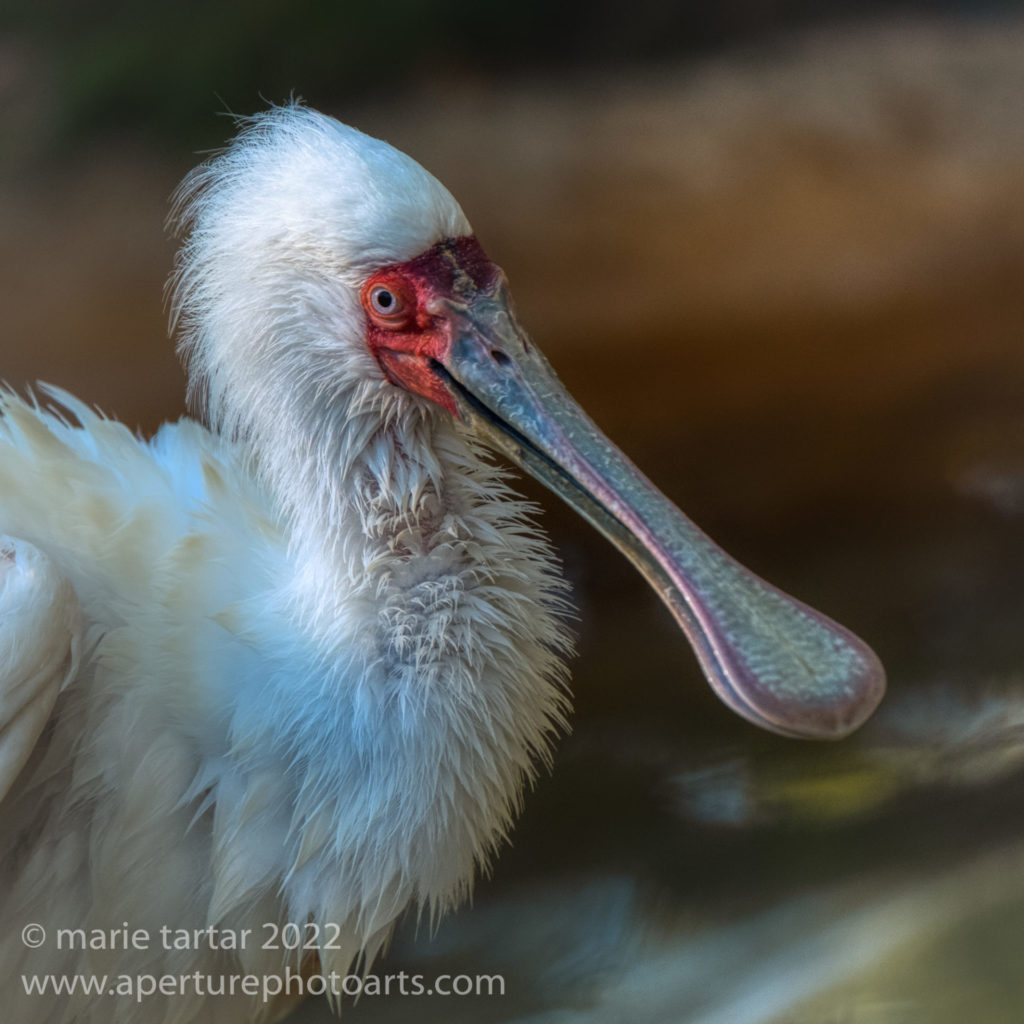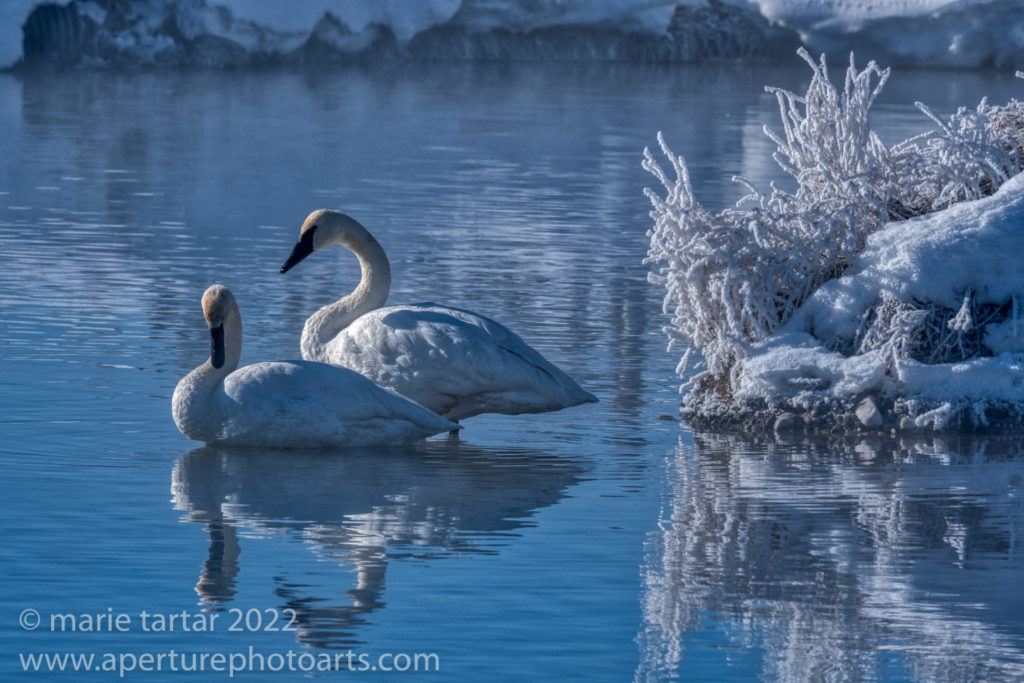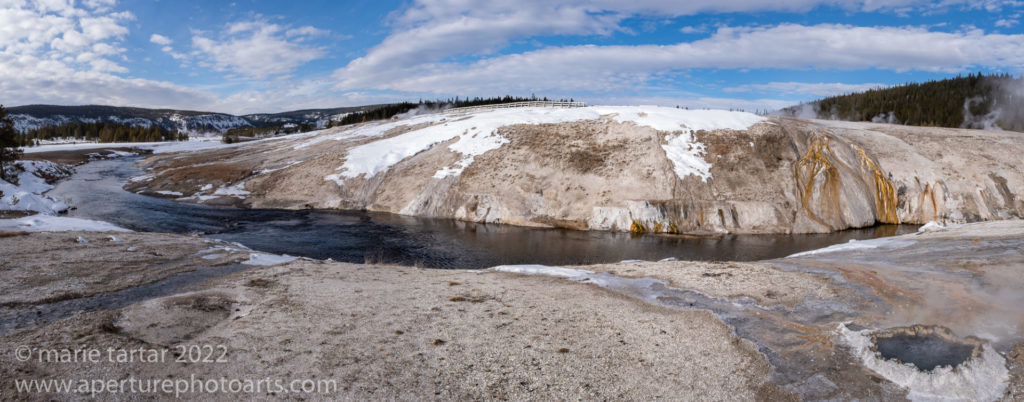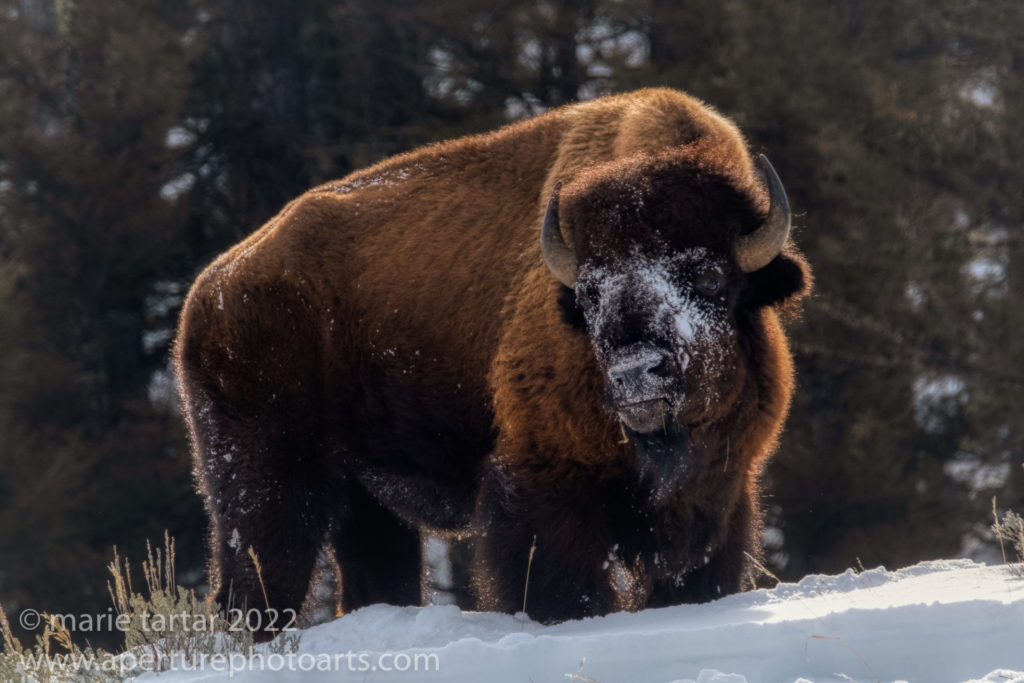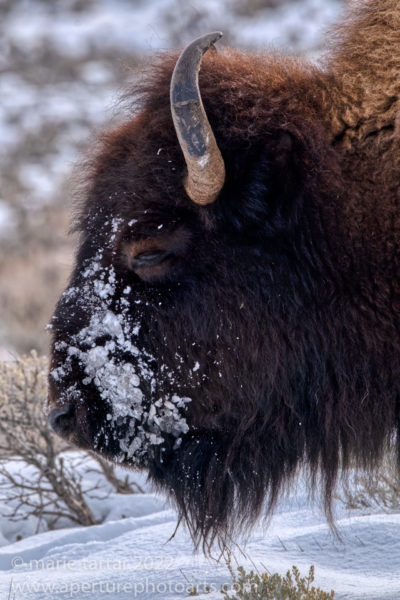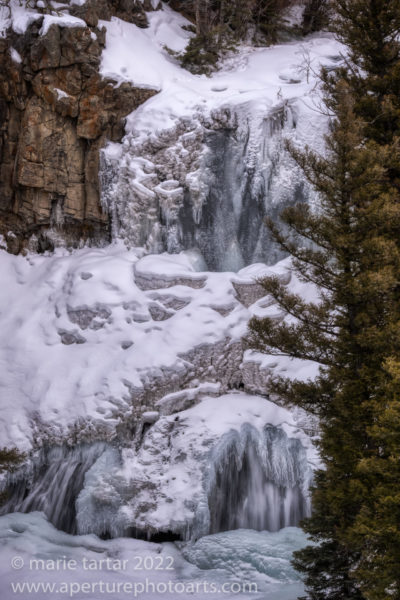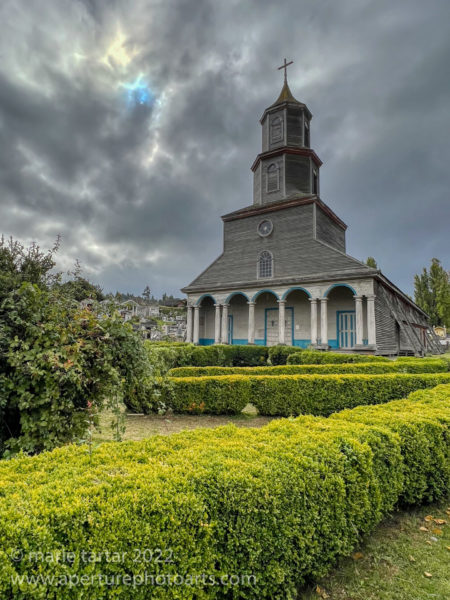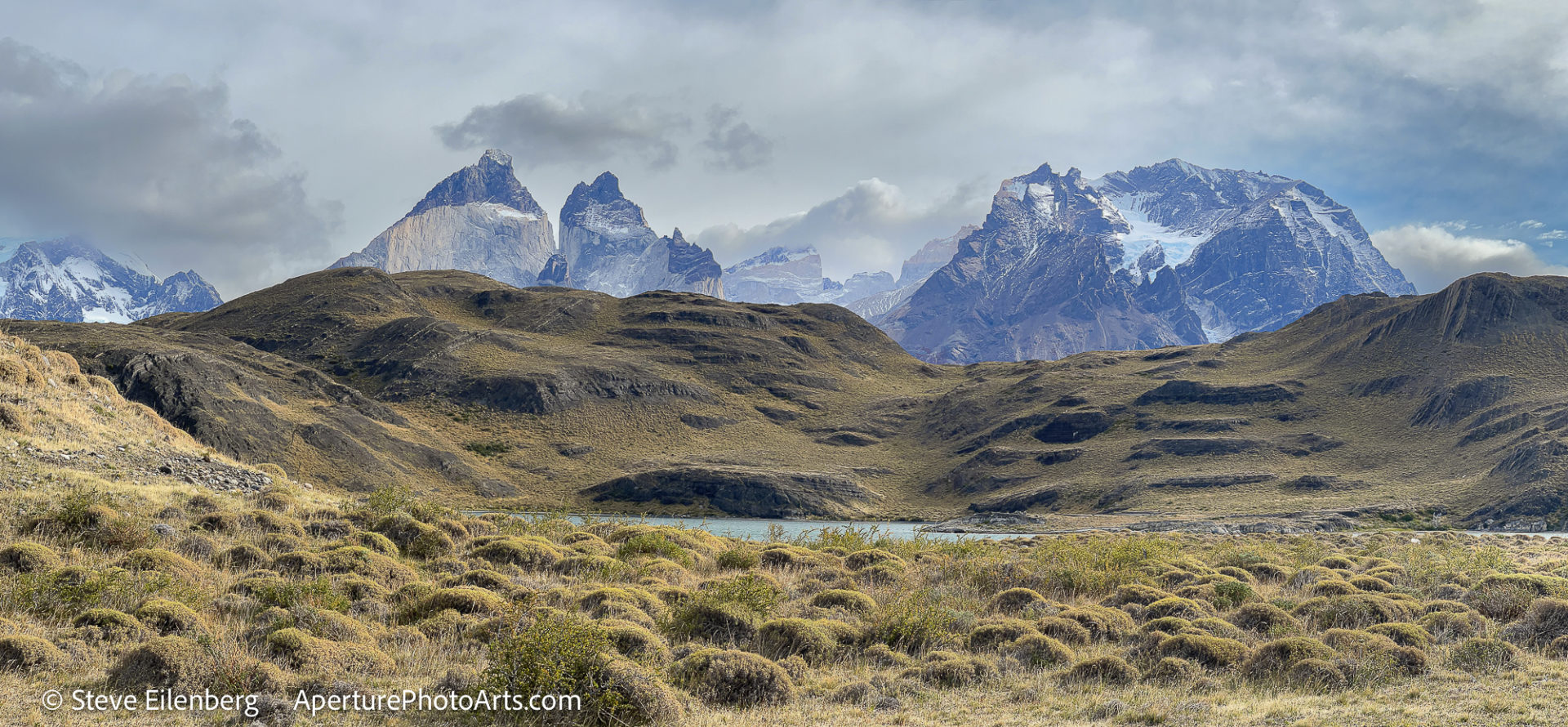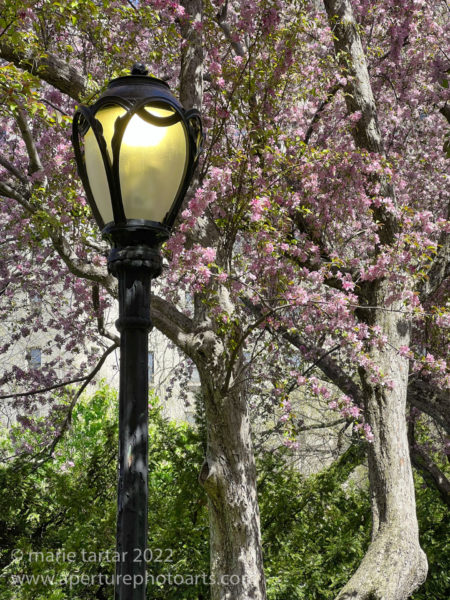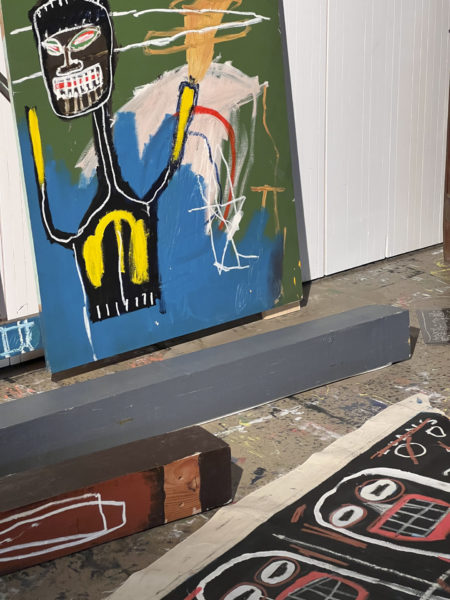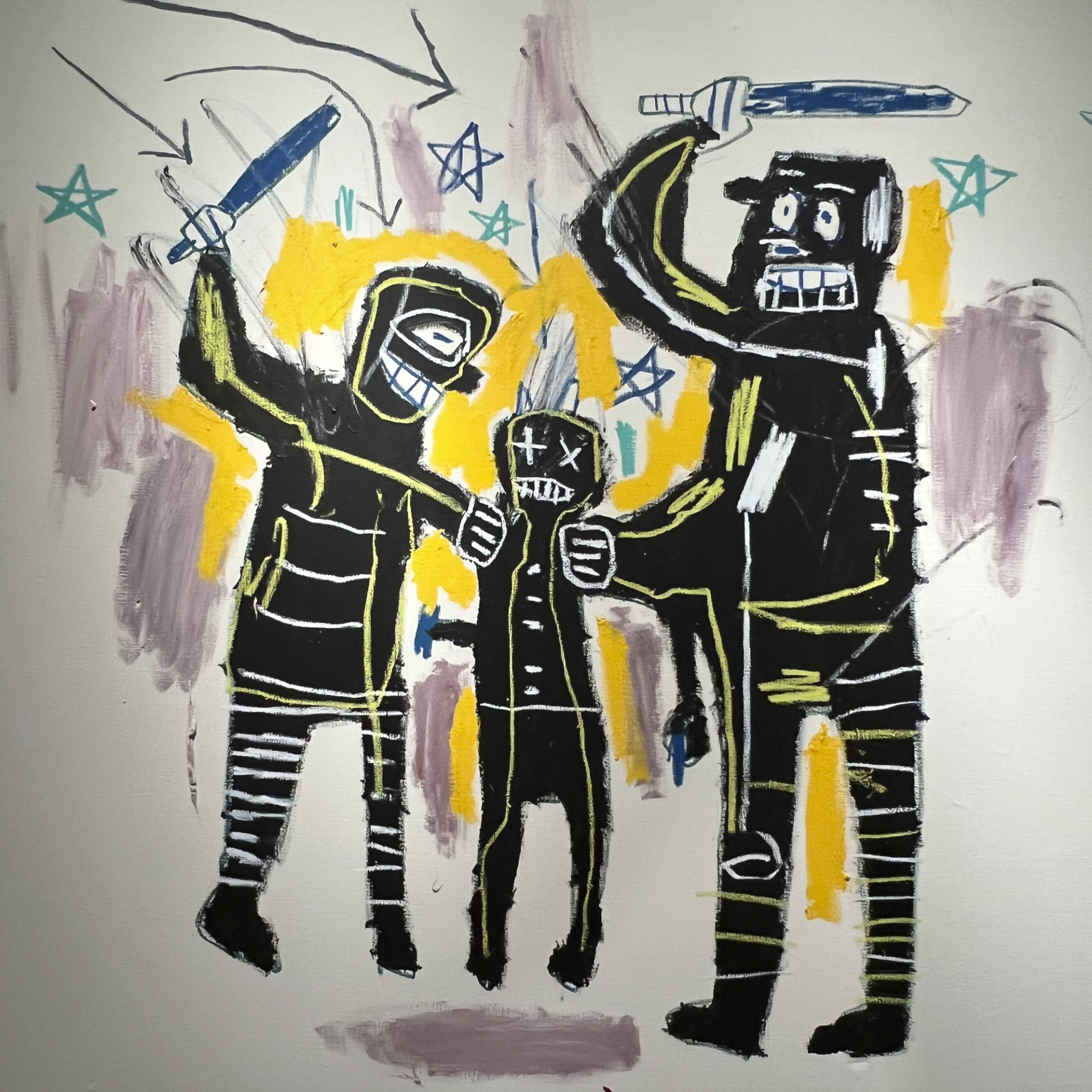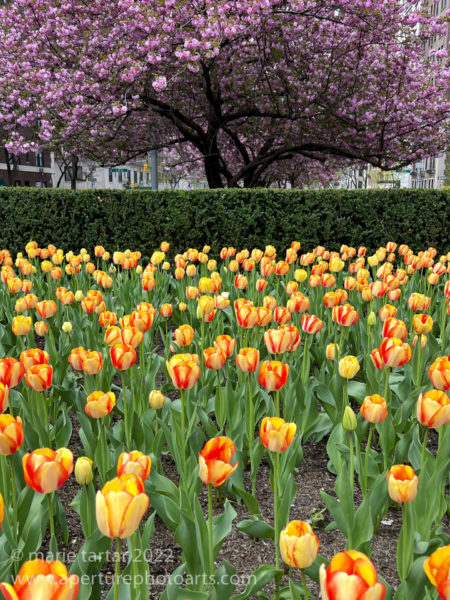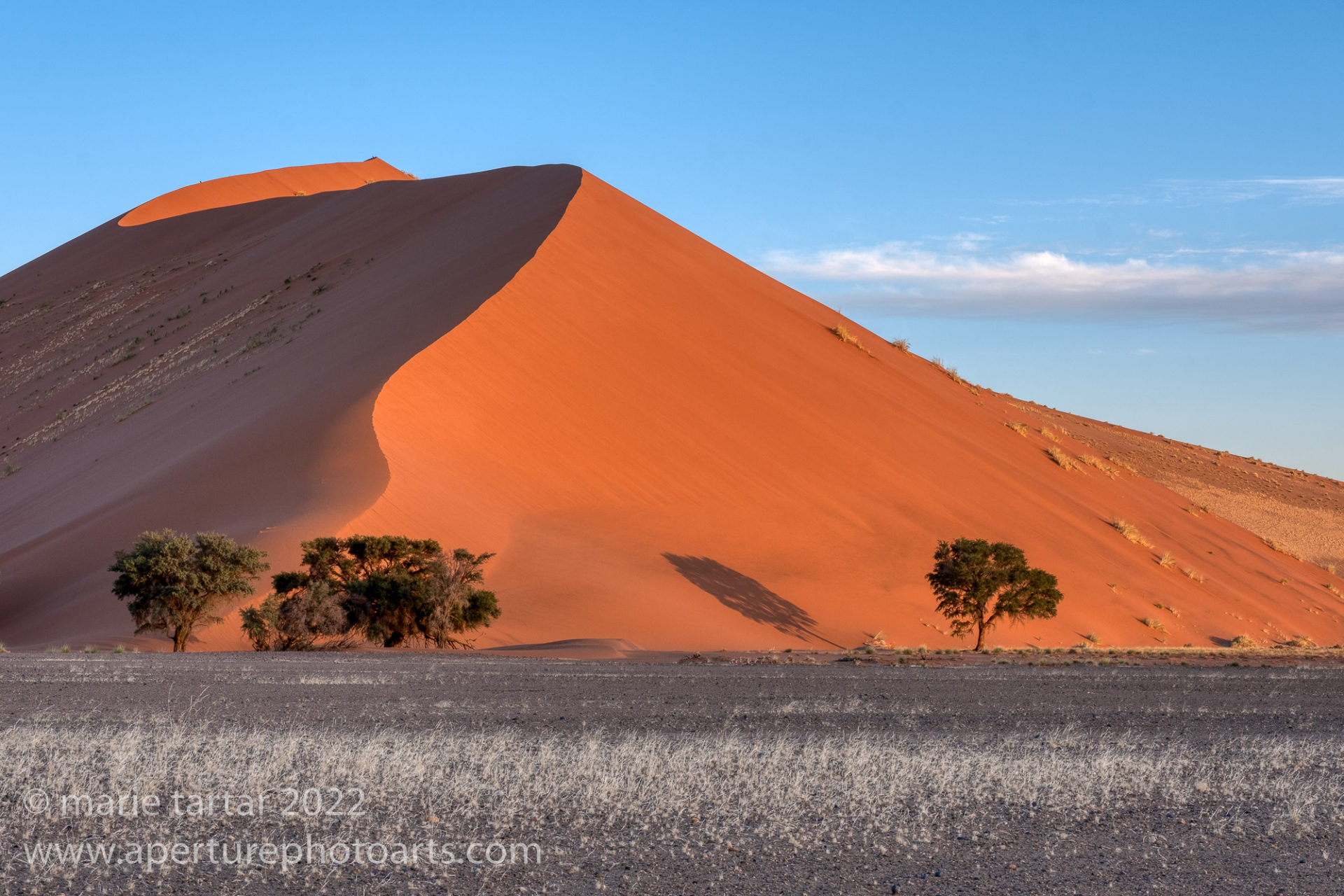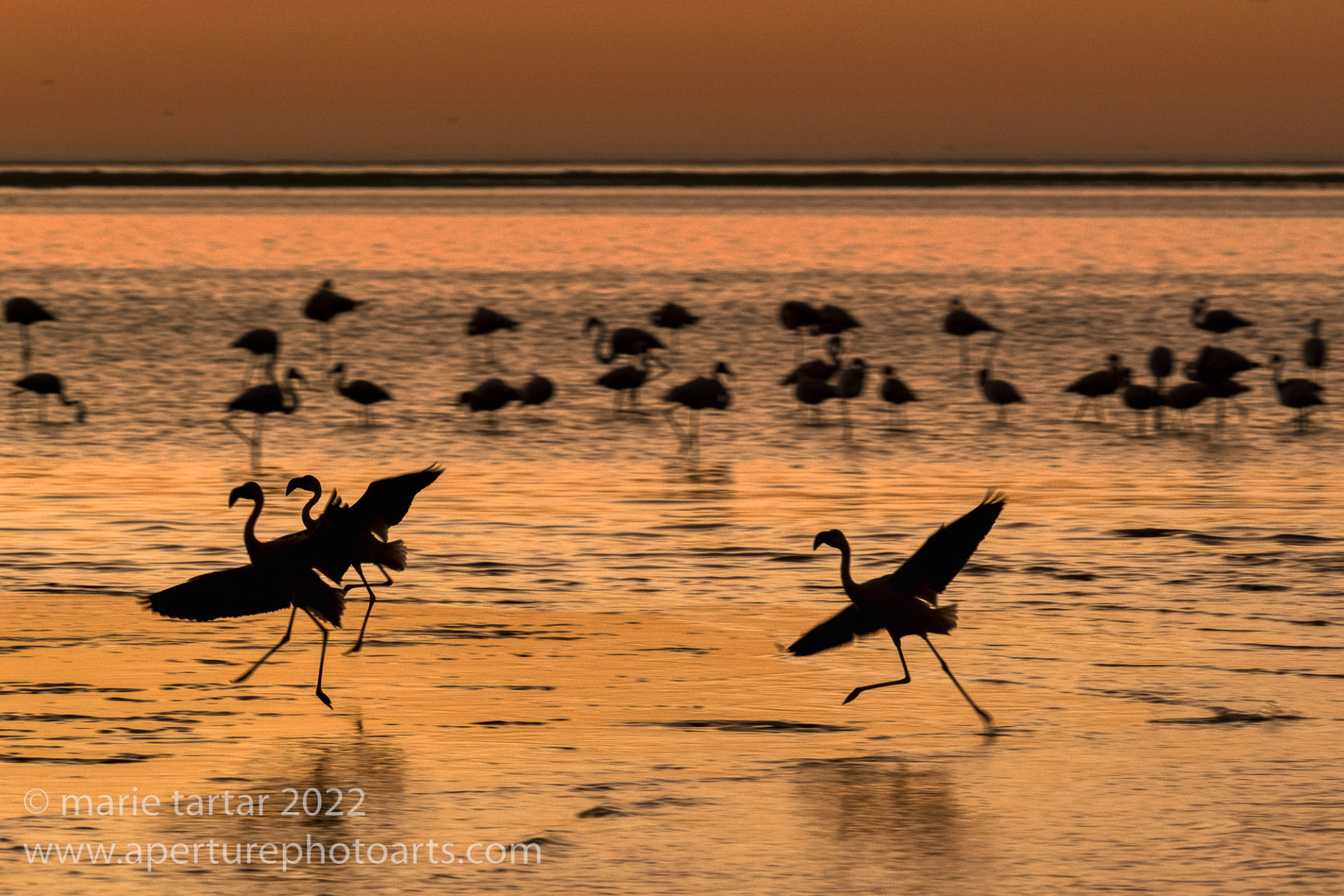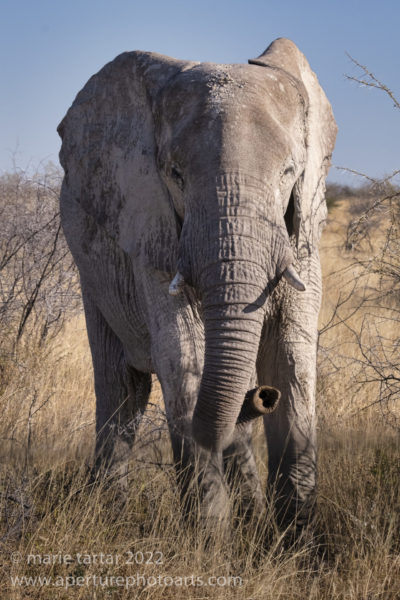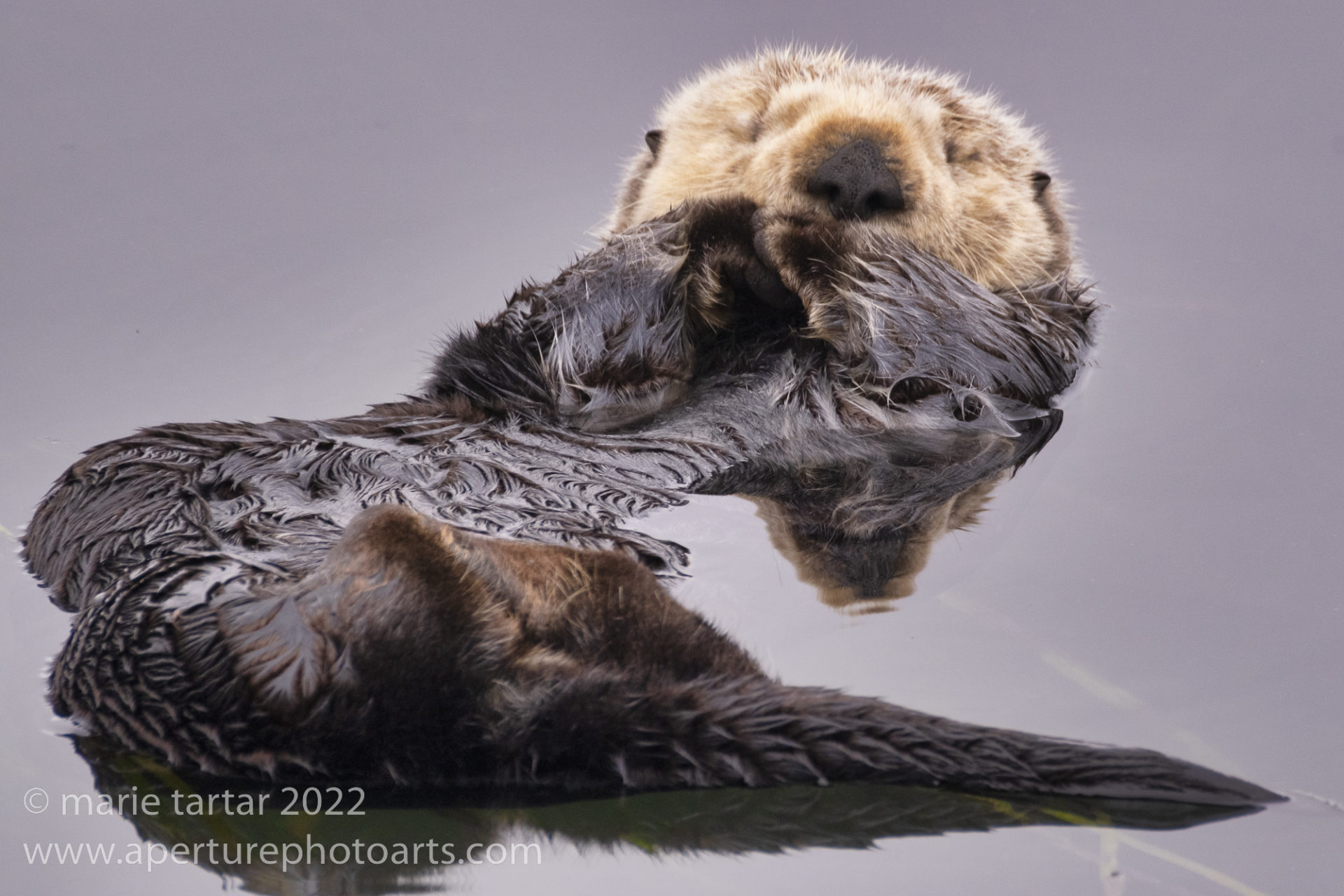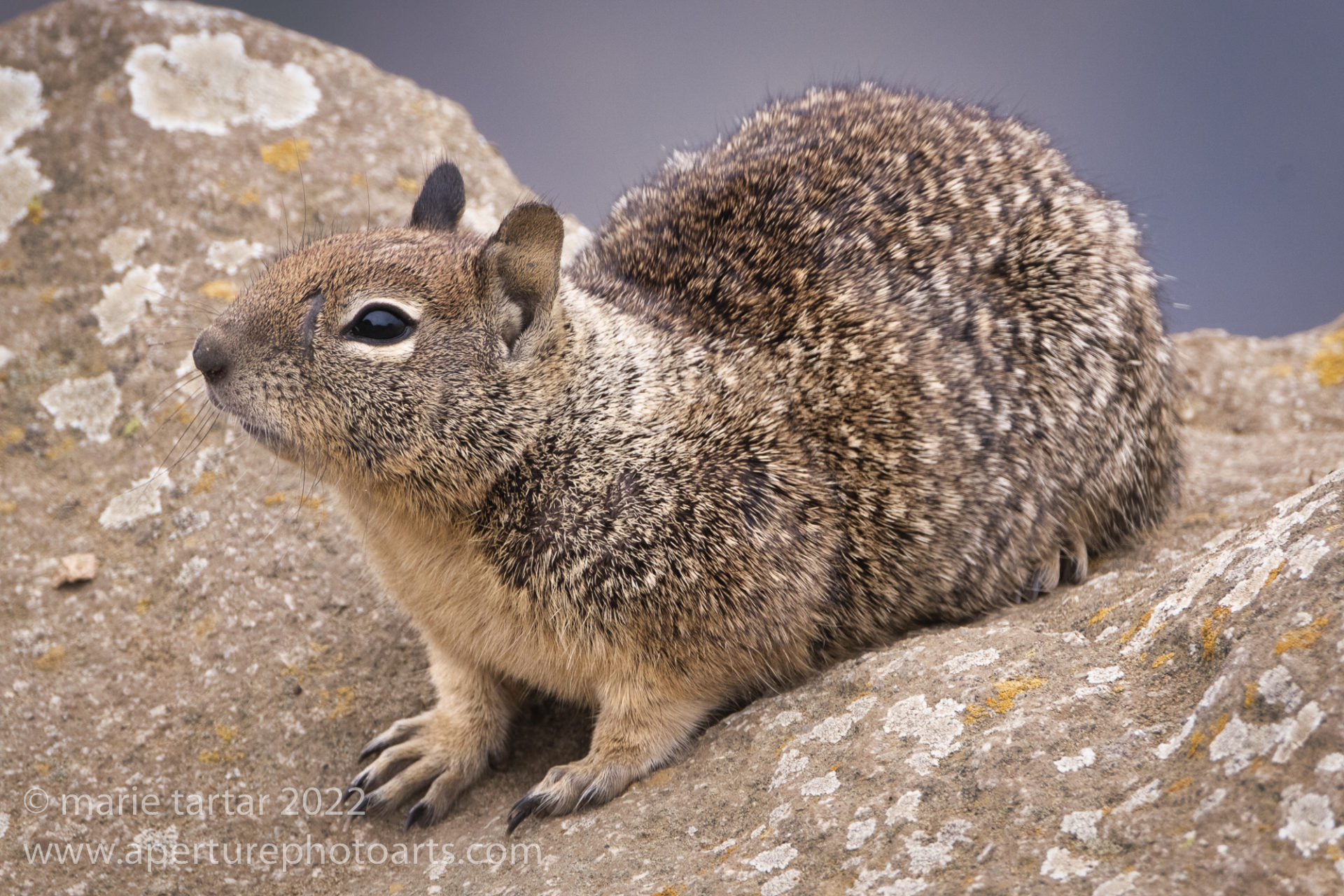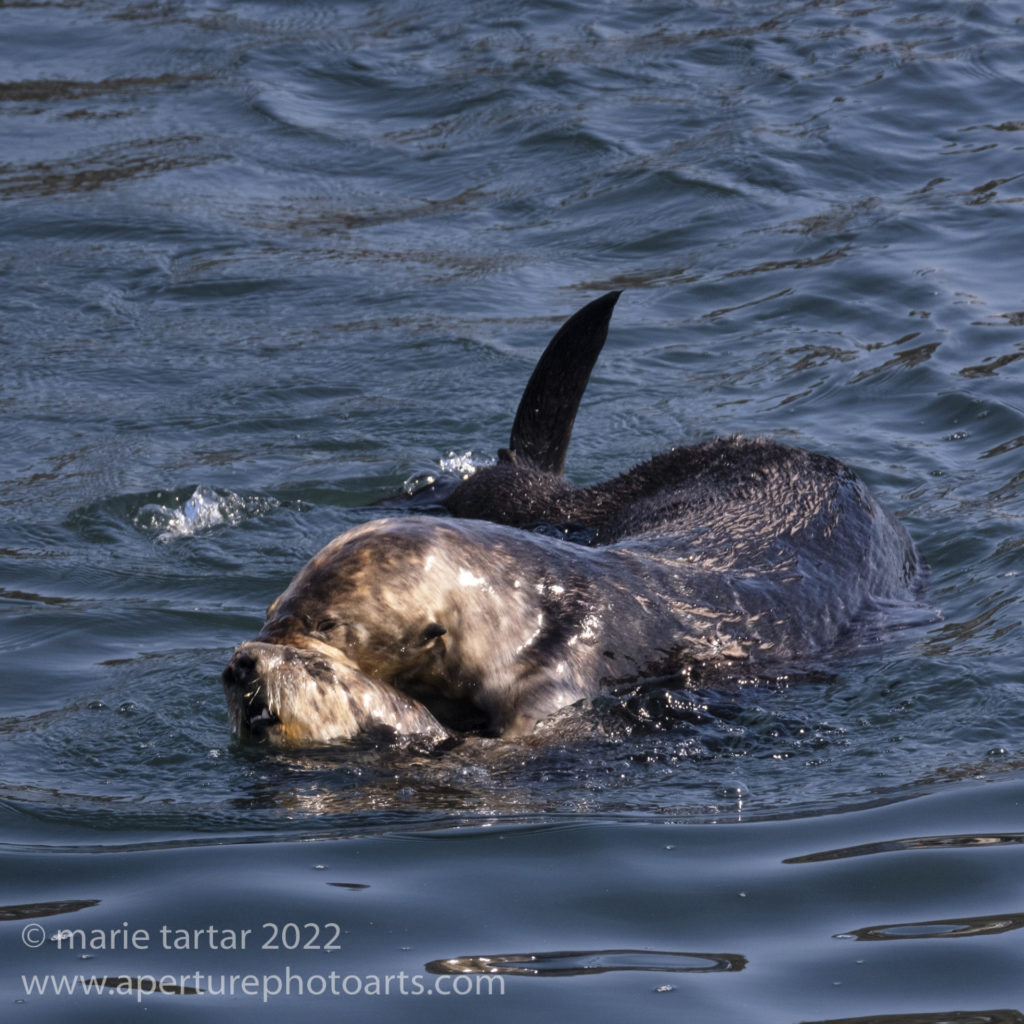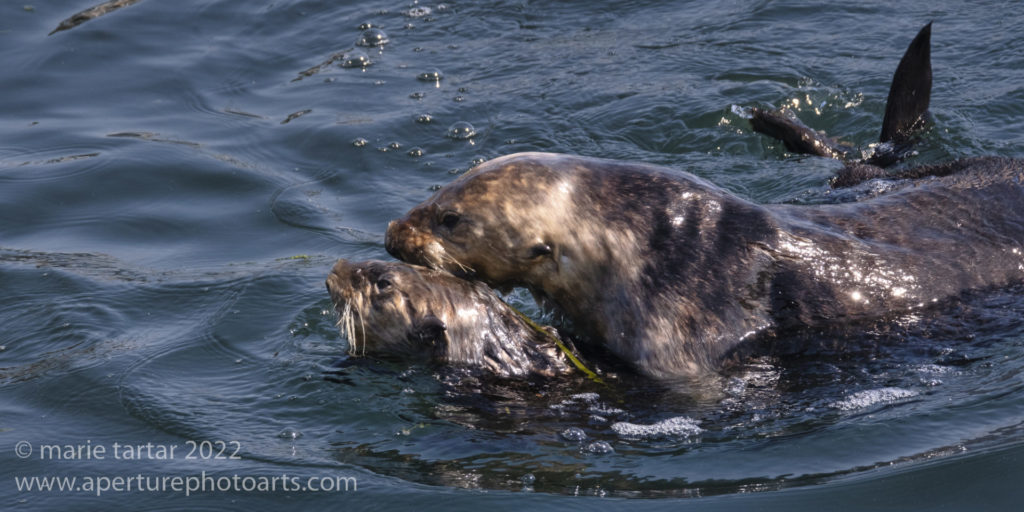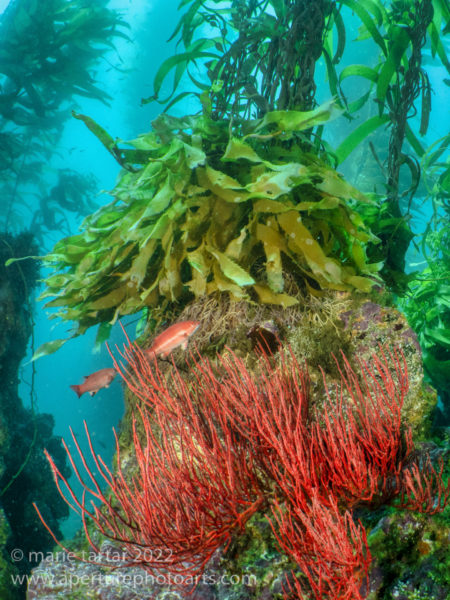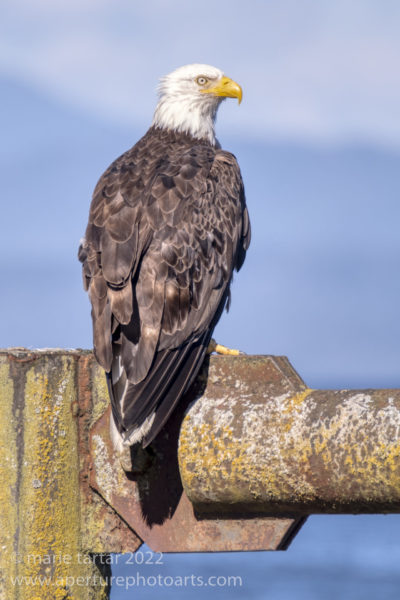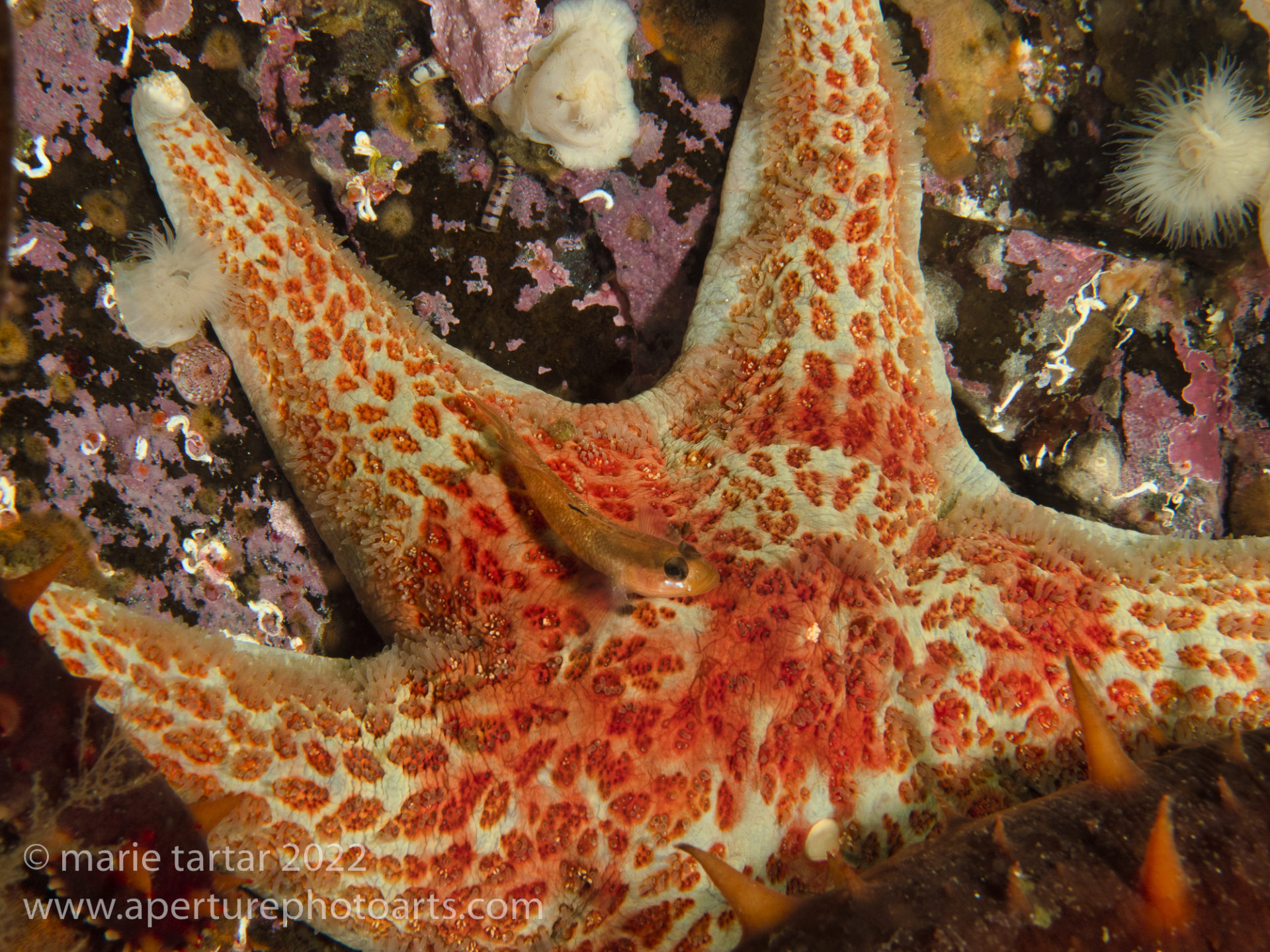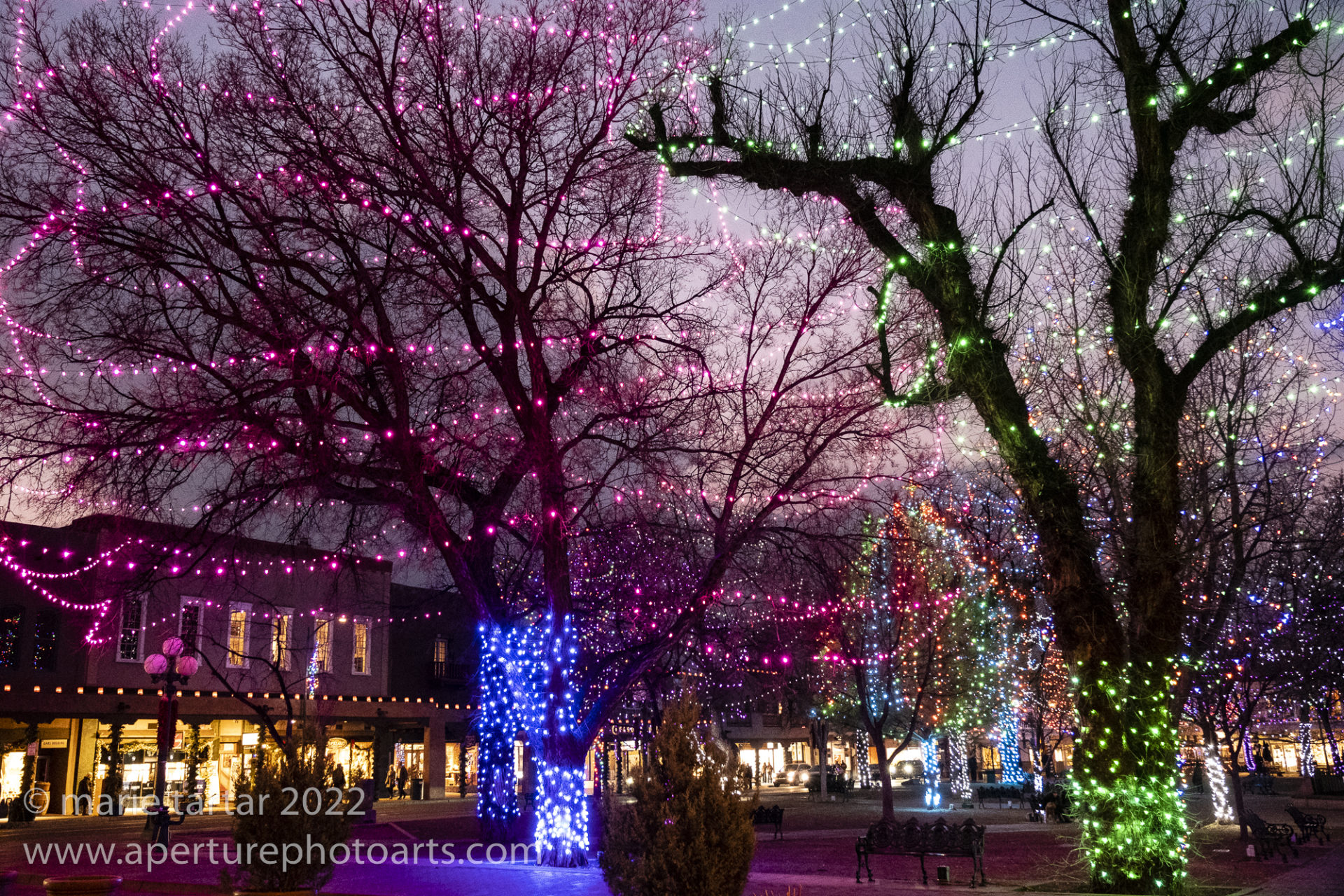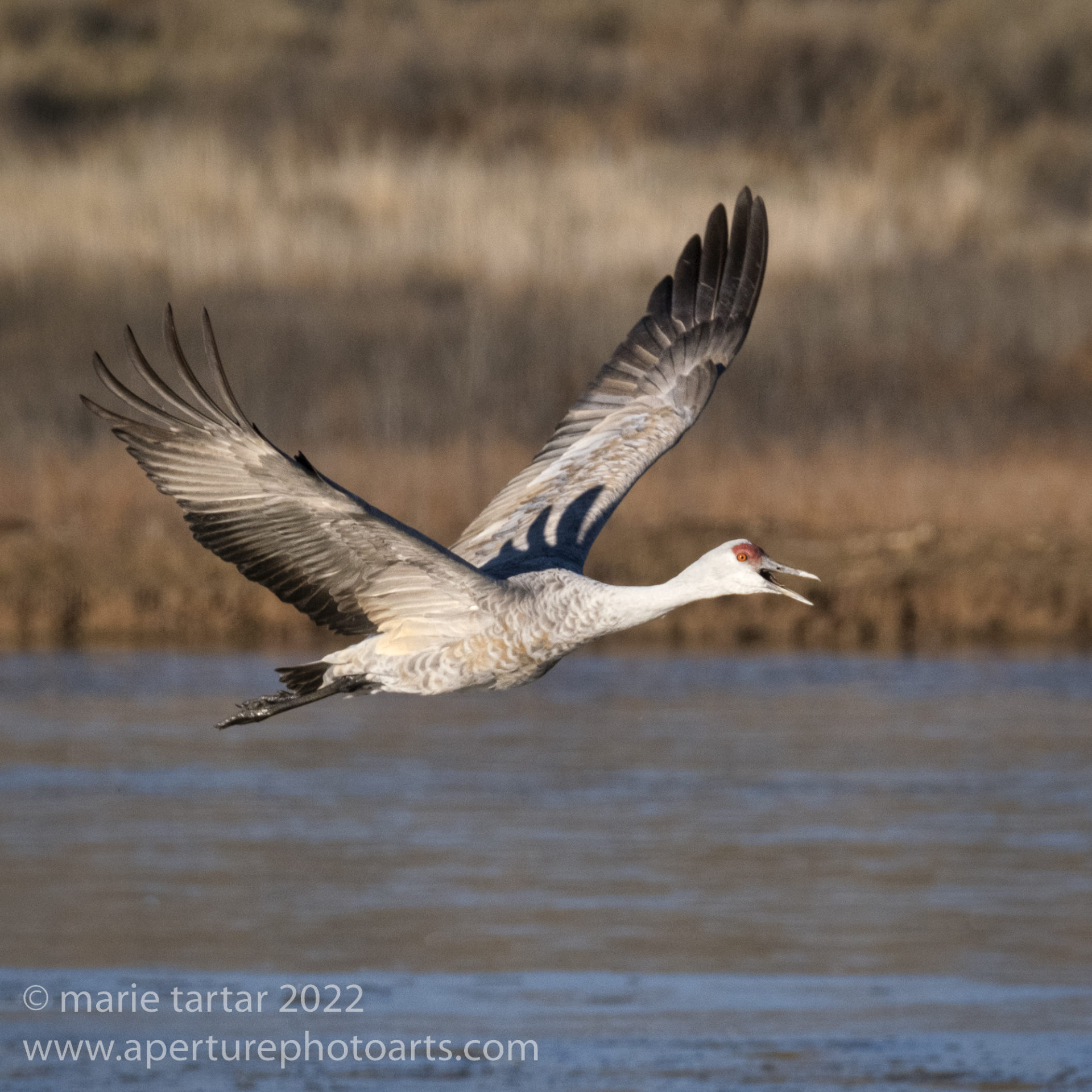
As 2022 unfurled, we adapted to the realities of coronavirus endemicity. This was the year of make up trips (not 1, not 2, not 3, but 4!) postponed from Pandemic Years 1 and 2. We actually did one trip in its originally scheduled place on the calendar (our October Baja dive trip was scheduled back in fall, 2019), a strange type of pandemic-era travel milestone itself. We didn’t throw coronavirus caution to the winds, although it seemed much of the rest of the world did, especially in the latter half of the year. At year’s end, we still had not contracted it, that we knew of, but did suffer through much of December with an unpleasantly prolonged version of the ubiquitous respiratory crud. The selection of this blog’s feature image? Trying to sum up 2022, pandemic year 3? In short, it FLEW by! Birds were again a recurrent focus of our photography, even after we resumed diving in the second half of the year, after a pandemic-induced hiatus of 2.5 years.

Nature’s artwork: an opalescent nudibranch on a kelp leaf sporting bryozoan patches (Queen Charlotte Strait, British Columbia, Canada)
Bests and worsts:
New favorite author: Nigerian Chimamande Ngozi Adiche, especially for Americanah (2013). Purple Hibiscus (2003) and Half of a Yellow Sun (2006) were also excellent.
Runner up for new favorite author: Yoko Ogawa from Japan ( The Housekeeper and the Professor (2003) and The Memory Police (1994)).
Most arresting read: The Trees (2021) by Percival Everett.
Number of pandemic/apocalypse themed books read this year: 3
Number of trips taken this year which were postponed from prior years due to the pandemic: 4 (almost through the backlog, one to go, postponed to summer 2024!)
International trips taken this year: 4 (we have the 3 pandemic postponements to thank for that statistic!)
Biggest mental health move made this year: Dropping down to 60% work status as of March.
Least fun expenditure: New gas line in San Diego.
Least fun expenditure, runners-up: not one, but two failed HVAC units (one in San Diego, one in Sedona).
Most fun expenditure: A pedal-assist gravel/road bike for me (Specialized Creo SL).
Most tense day: Wednesday, March 23, the day we fell prey to a flat tire scam in Chile.
Best theater (3-way tie): James Ijames Fat Ham, a contemporary spin on Hamlet, set in a backyard BBQ (Public Theater, NYC) vs. Freestyle Love Supreme at the Old Globe (joyous rap improvisation) vs. Kristina Wong, Sweatshop Overlord at La Jolla Playhouse, which beautifully incorporated the frenzy of the early pandemic. The performance artist found herself suddenly out of work in March 2020 with the outbreak of the pandemic and enlisted social media, friends and strangers to form a sewing army of mask makers.
Trips to Sedona: 3 (of 8 nights each in February (Sedona International Film Festival), August and October, for a total of 24 nights, few enough we decided to try renting the house out between stays).
Trips to New York City: 4 (April (8 nights), June (4 nights, jet lag recovery stay coming back from Namibia), September (4 nights, long weekend), November (8 nights), for a total of 24 nights).
Biggest logistical challenge, stretching from May-November: Getting Mama (with Joe’s invaluable aid) through two cataract surgeries. Including the initial optometrist visit prompting this, this required a total of 13 (!) trips to various Scripps Clinic locations, including initial ophthalmology consult, biometry, pre-operative history & physical in internal medicine, pre-operative Covid testing (2), cataract surgeries (2), post-operative visits (3) and post-cataract surgery refraction, PLUS a trip to Warby Parker for new post-cataract glasses, as well as a cardiology consult prompted by EKG findings noted in Internal Medicine.
January
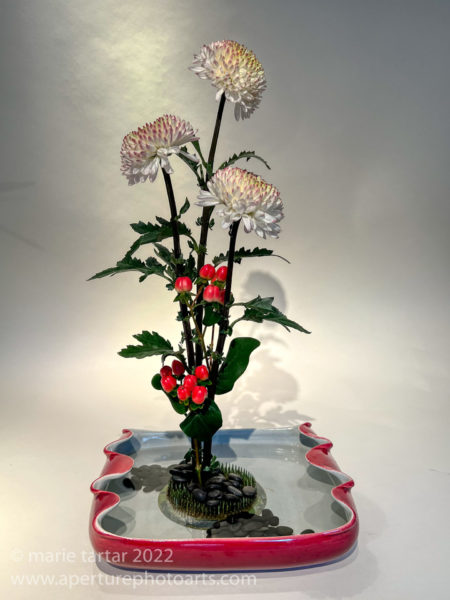
I finally made it back to ikebana class. This composition emphasizes verticality. Chrysanthemums are associated with Japanese New Year.
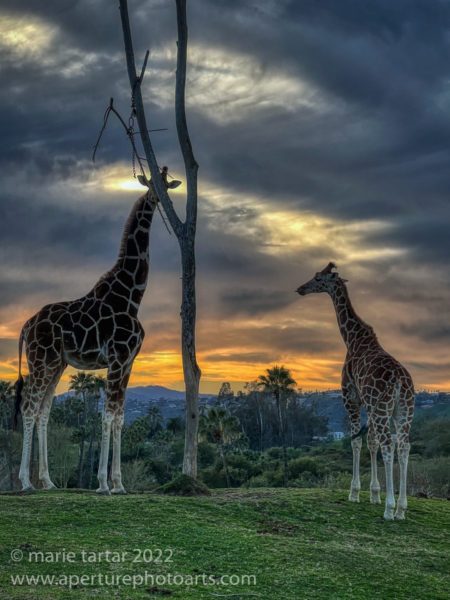
Joe and I took Mama to the San Diego Wild Animal Park in Escondido on a sunny and warm winter Wednesday afternoon off from work.
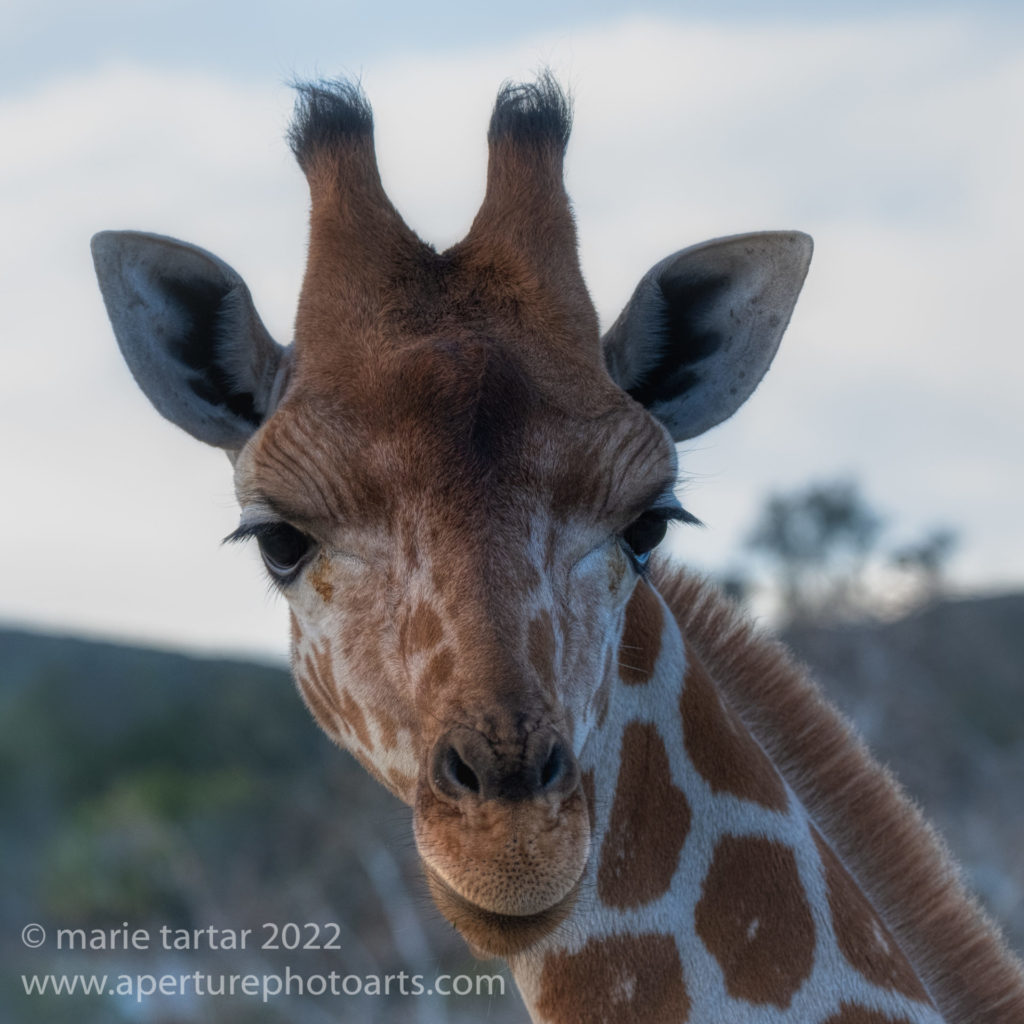
A close giraffe encounter at the San Diego Wild Animal Park in Escondido: I’ll never forget being licked by an astoundingly long black tongue of a giraffe at a rescue site in Nairobi.
Barely ahead of the library’s deadline, I finish a novel set during this global pandemic, as a group of friends evading the pestilence in the City, gathers at a country retreat in Gary Shteyngart’s Our Country Friends. The universe seemed to be insistently indicating I should reread Chekhov’s Uncle Vanya, which features prominently in this work, as well as in the Japanese film Drive My Car which we saw the month before. It was a good month for reading, including Paris food critic Alexander Lobrano’s My Place at the Table (recommended by our friend Patricia in Paris and perfect for keeping November’s Paris afterglow going), Louise Erdrich’s The Sentence (for my book club, another pandemic-set novel, this one taking place in a bookstore), Zone One (another post-apocalypse novel, continuing my Colson Whitehead reading jag) and Alexandra Fuller’s Cocktail Hour Under the Tree of Forgetfulness (tales from the author’s colorful childhood in Zambia, with an unforgettable mother).
February
We had a close Covid scare one week before our long scheduled, bucket list winter trip to the Yellowstone Basin. We dined on Nine-Ten’s outdoor heated patio with Miles and Tatiana on a Friday night after work. We noticed nothing amiss, but later learned Miles had abdominal discomfort toward the end of the evening and woke up with mild cold symptoms the next morning. He home tested himself and was negative. But he was scheduled for cataract surgery the following Monday and had to have a mandatory PCR test on Saturday afternoon, the results coming back at midnight. Our quiet Sunday morning was suddenly overshadowed by receiving an email from Miles with the ominous subject line “I have Covid”.
Fortunately, we were asymptomatic and so were Ralph and Gail, who dined with Miles and Tati the night before our dinner. Ralph and Gail did Detect tests on themselves and were negative. Tatiana remained asymptomatic and had a negative PCR test in the middle of the following week.
Our trip to Wyoming with Cathy and Gordon Illg of Adventure Photography was a great success. We had two wonderful guides, Dylan and Bobbie, and a compatible group, including a smattering of Californians (Peggy from San Luis Obispo and her friend Cheryl from nearby Atascadero and Bruce from Santa Barbara), as well as folks hailing from the East Coast (Wendy from the DC area and Jeff from central New Jersey) and the Midwest (Glynn living in Tennessee and Jan from Ohio) and the Southeast (Jan’s high school and later life beau, Chuck from Georgia).
We started in Jackson and wound our way north through the Grand Tetons into Yellowstone, switching vehicles as necessary, from normal vans to snow coaches to traverse Yellowstone and back again once we made it north to Montana. Our conditions were favorable as well, with a good base of snow and fresh snow while arriving into Yellowstone.
It was cold but not terribly windy or bitter.
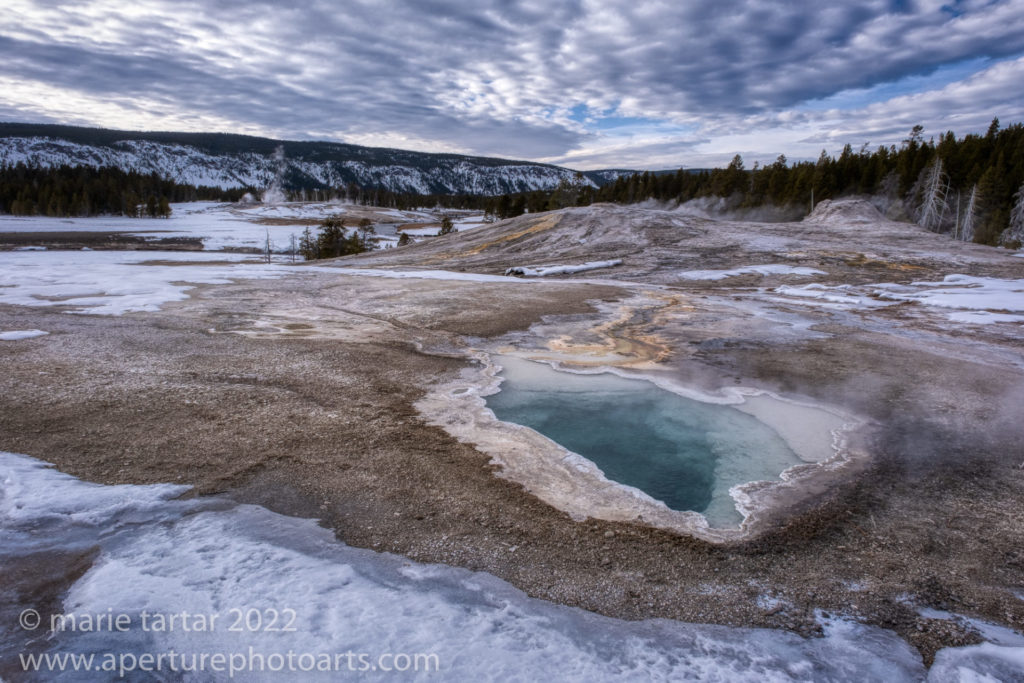
Valentine’s Day, 2022, featured a walk through the Geyser Basin of Yellowstone, including Heart Geyser (pictured).
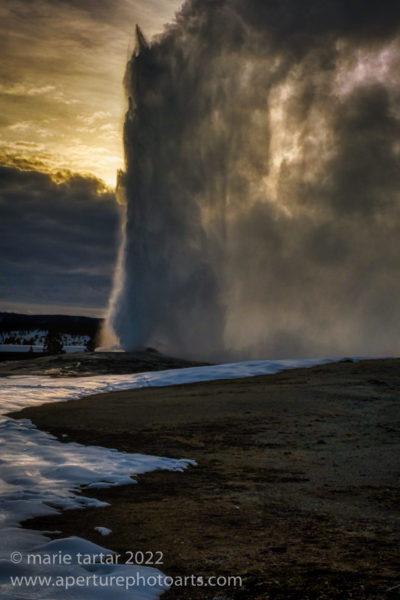
Old Faithful’s regularly scheduled eruption was delayed enough this evening that the sun dropped into the clouds, blunting the backlighting for which I was hoping.

A visit to Dan Hartman’s, near Silver Gate, Montana and the northeast corner of Yellowstone, included a nice bird shooting session in his forested front yard.
Our second week of vacation was equally entrancing. We hadn’t been sure until late in January that we’d have the whole week off to attend the Sedona International Film Festival, thanks to the ongoing merger adjustments and staffing issues at work. When it came through, I bought Gold Passes and arriving early to a MOPA collection selection event on the last Monday in January, hurriedly made selections for us via the Iphone. One pandemic-wrought improvement to the festival: the need for additional spacing among the attendees meant we could also select our seats in advance! This minimized queuing up and waiting to file into the theater and scurrying around trying to secure a good sightline. In addition to a fantastic line-up, there were more treats in store during the week.
We woke up mid-week to a gorgeous snowfall. Between films at the high school venue (SPAC), I tramped through fresh snow on the Scorpion Trail near the school, while Steve procured a quick Indian food meal from Whole Foods prepared food section. Later, we skipped our 4 pm film to hike together from the house on the Jim Thompson Trail, which was stunningly transformed.

A hike from the Sedona house, the Jim Thompson trail, utterly if briefly transformed by a blanket of snow.
We knew from past trips the snow would be very temporary and indeed, it was nearly gone by the next afternoon.
The second treat was an unexpected opening for the Photopills seminar with the Sedona Camera Club the second weekend of the festival. We had been signed up for the original August 2021 seminar, along with Greg, but Covid had intervened. At that point, Spain was behind in vaccination and Rafael Pons, one of the app’s developers and the featured instructor, wasn’t able to travel to the US (he lives in Majorca). When it was rescheduled to February, I didn’t jump on it immediately as we weren’t sure of having the time off. By the time we did know, it was full. I wrote and asked to be waitlisted if someone cancelled. It must have been meant to be, one of those Sedona moments, as it turns out we were 4 and 5 on the waitlist. The people ahead of me either didn’t respond or had made other plans. We had taken Tuesday morning off from films, so I was at the computer when the email came through and I jumped on it.
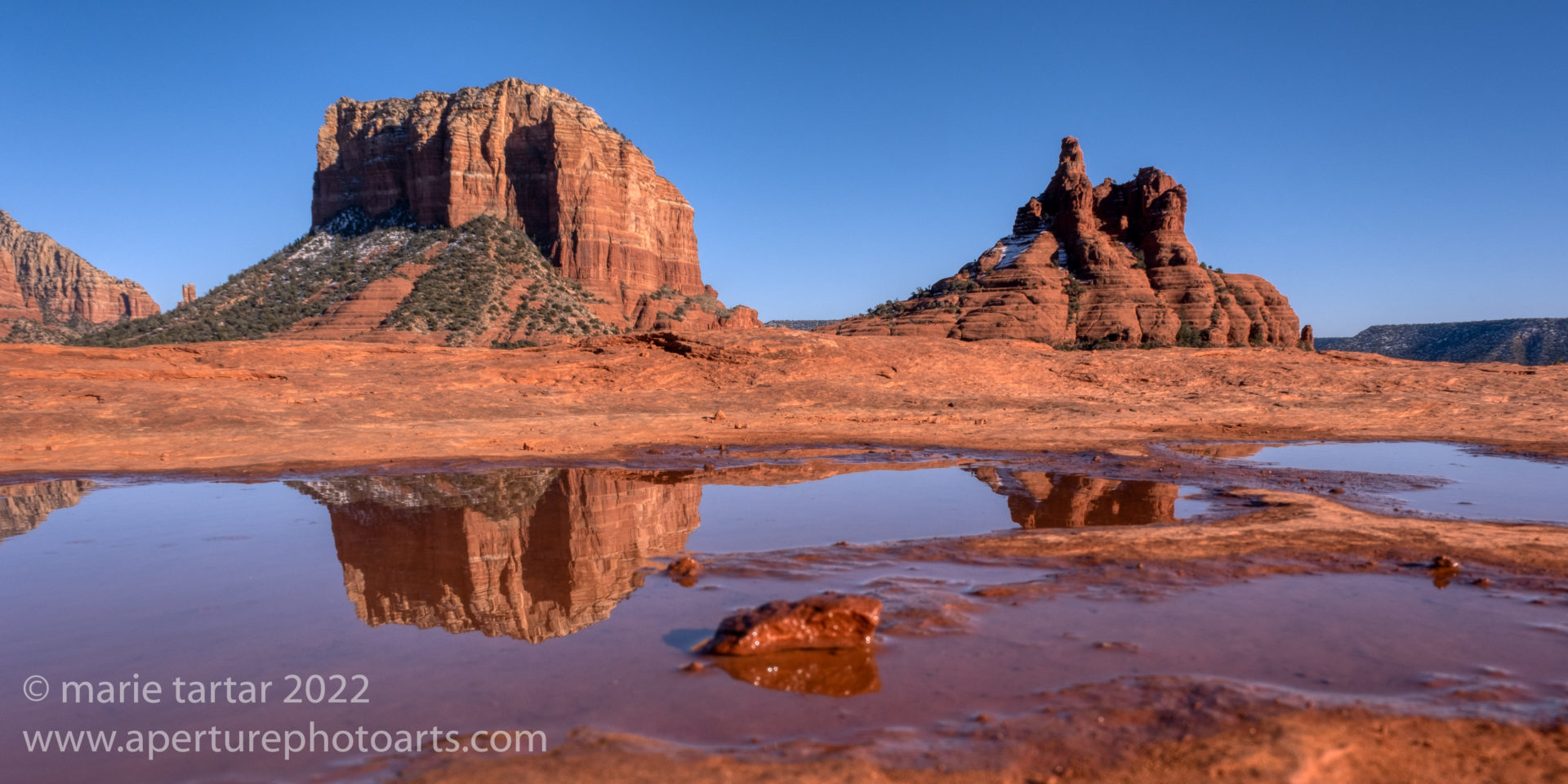
Courthouse Butte and Bell Rock, from Yavapai Vista. The “reflecting pool” was actually surprisingly small, formed from carefully positioned contents of a bottle of water.
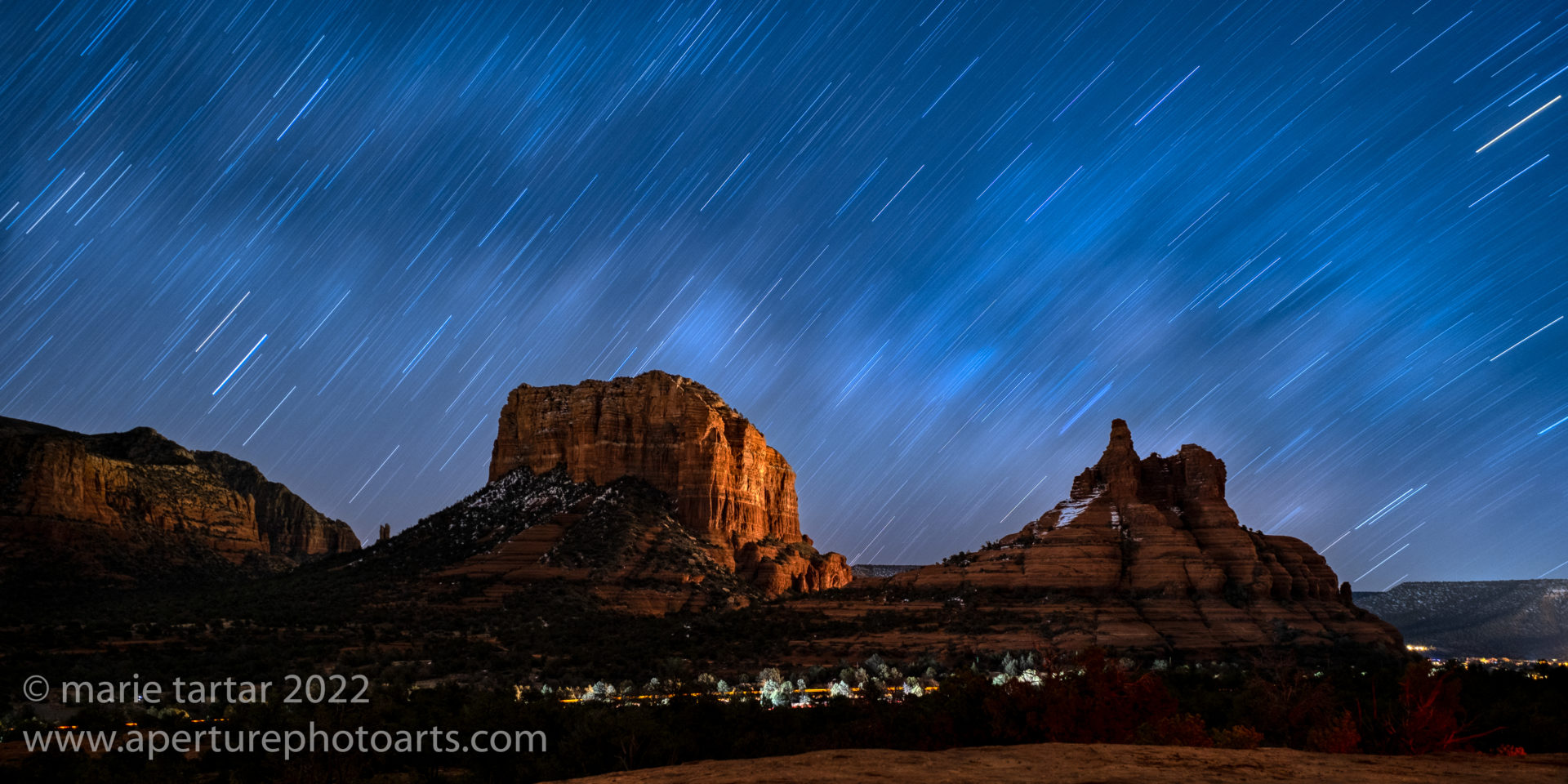
After scouting out our location on Yavapai Vista in the afternoon, the Photopills seminar group met up at 3 am, bundled up for 30 degree temperature, to shoot the Milky Way over Courthouse Butte and Bell Rock.
I continued my survey of Colson Whitehead’s oeuvre, listening to The Intuitionist (Whitehead’s 1999 debut novel, with a Black female elevator inspector coming under suspicion when an elevator she recently inspected is involved in a catastrophic fall) and The Noble Hustle (in which, Whitehead, an amateur poker player, is staked by a magazine to enter the World Series of Poker). A re-reading of George Orwell’s Animal Farm was remarkably prescient.
March
It was good we were so rested and refreshed from our 2 weeks of vacation, as our return home was trying. A few days before we left, SDG&E abruptly shut off our gas and it was up to us to ferret out the source of the gas leak. Steve directed the detective efforts from Wyoming, but after potential sources were identified and fixed, we still had a leak. It hadn’t been difficult to put up with no hot water or use of a cooktop for the few days before we left, but this was still dragging on our first week back. Luckily, I remembered the portable induction cooktop Greg had given us, so we brought that back with us from Sedona, which made cooking possible.
Eventually, it was determined that we needed a new gas line to the kitchen, although extending it beyond to the BBQ outside and even further to the outdoor fireplace would be problematic. This meant cutting into the drywall, sheets of plastic through the center of the house trying to contain the drywall dust and general disorder and disruption. Getting to the kitchen from our bedroom was now easier by exiting the garage and entering the front door.
We finally turned a construction corner on my birthday, a Saturday spent trying to ignore the construction noise, after I returned from a birthday breakfast at Parakeet Cafe with Susan and from having my hair done afterwards. The evening was a pleasant diversion, at Nancy and Gerry’s, catching up and feasting on take out from West End Bar & Grill in their neighborhood.
Rocky and his compatriots came to our rescue the following Sunday, patching up the mess. We returned home from seeing Trouble in Mind at the Old Globe with Clarissa and Mama, with a delicious dinner afterwards at Muzita Abyssinian Bistro afterwards. Clarissa had seen the Alice Childress 1955 play in New York in the fall, when it had been celebrated as long overdue to be seen on Broadway. It depicts an interracial cast mounting an anti-lynching play. The lead actress, Ramona Keller, was outstanding.
From an especially pleasant family gathering on Sunday emerged a disruptive and disturbing accident. Steve and I dropped Mama and Clarissa off at a downtown hotel after dinner, for a 2 night staycation Clarissa had planned to spend time with Mama away from Ohana. I rode my bike to work the next morning (we still didn’t have the gas issue resolved and so had no hot water). Emerging from the shower at the gym, I was surprised to see two calls from Clarissa within a few minutes of each other, only a few minutes after 8 am. This didn’t bode well. Mama had gotten up in the middle of the night to use the bathroom. The first time went fine. The second time, around 1:30 in the morning, she slipped trying to mount the slightly higher than usual, very soft bed. Clarissa heard a loud thud. Mama was on the floor, in a lot of pain from her left chest wall. Clarissa couldn’t get her back up on the bed but made her as comfortable as she could on the floor, where she slept for a few hours before awakening and again needing to go to the bathroom. Clarissa helped her, but the transfer took almost an hour, Mama was in so much pain. Hearing this, I thought she probably had rib fractures and maybe a humerus fracture. My over the phone diagnosis was close: later evaluations showed multiple rib fractures, some segmental and a clavicle fracture. The first question was-did we need an ambulance or could she come to Urgent Care in a car? She didn’t seem to have a head injury or trouble breathing. I suggested Clarissa see if the front desk had a wheelchair and to call Jason to pick them up and bring them to Green. I was reading PET scans next door to Urgent Care that day. As they were en route, I called Urgent Care to give them a head’s up. I was surprised to learn that more than one rib fracture would be grounds for admission, because of Mama’s age (almost 86).
The chest x-ray and humerus films showed a displaced clavicle fracture and multiple rib fractures, some displaced. The evaluation extended to head and cervical spine CT, but didn’t show other injuries. I was again surprised that the consensus was that Mama should be admitted to the trauma hospital, Scripps Memorial La Jolla, down the road. Clarissa rode in the ambulance with Mama when she was transported over there. Body CT scans and an evaluation by the trauma surgeon turned up no additional or internal injuries. She was admitted to ICU for observation and pain control.
The next morning, she was stable and transferred to a trauma step down unit. I had swapped work assignments-twice- the day before, as all of this transpired in order to be on the same campus. Four days later, on the day I was expecting she would be released to a skilled nursing facility, she had a 13-beat run of V-tach (ventricular tachycardia, a fatal heart rhythm if unchecked), necessitating more observation.
After a week in the hospital, Mama was released to a skilled nursing facility, Torrey Pines Senior Living, early in the week prior to our scheduled departure for two weeks in Chile. She was there for two weeks, recovering steadily and undergoing physical and occupational therapy. Clarissa was still in town and oversaw her transfer there. Carlton was persuaded to come out the following week with Clarissa back in New York and me in Chile and oversaw her release back to Ohana 2. On my return from Chile, almost exactly a month after her fall, Mama was remarkably on the mend.
Our trip to Chile was eventful, to say the least, bookended by near-disasters and definitely marked by being caught up and falling prey to a flat tire scam.
Thanks to an Airtag buried deep in Greg’s heavily laden camera backpack, we were able to recover almost all of our stolen gear and after an unexpected trip to Santiago in the middle of our trip for temporary passports, were even able to finish our trip on a high note, returning to gorgeous Patagonia.
This, like our winter Yellowstone trip, was a pandemic-postponed trip, minus the eclipse of December 2020 around which the original version of this trip was planned.
Our trip to Yellowstone the month before led me to one of this month’s reads, Nate Blakeslee’s American Wolf. In addition, I followed up a read of Lisa See’s Shanghai Girls with its sequel, Dreams of Joy.
April
Back home, the process of life reconstruction began in earnest. Thankfully, my first week back was a short one, with Thursday and Friday off. I put photocopies of our driver’s licenses in the cars and hoped we wouldn’t be stopped. Thursday morning saw me gathering up documents and arriving before opening at the Poway DMV, not far from Ohana 2. I was pleasantly amazed by the remarkably efficient, pandemic-reorganized process-I was in and out with a temporary license and successful application for a Real ID within 40 minutes, even without an appointment. My next stop was the post office, sending off a packet with our temporary passports, checks and applications for replacement permanent passports. I spent the rest of the morning visiting Mama at Ohana 2, where I was pleased to see how well she was recovering.
Three full weeks after losing my 3 month old I-phone 13 in our flat tire scam robbery in Chile, I finally managed to jump through enough Apple Care and AIG (insurance) hoops to rejoin the connected human race with a new phone. What a relief! Two weeks after I sent off our applications for new passports, the replacements arrived. They were waiting for us on our return from New York, along with a pile of other packages, veritable Christmas in April. There was an ethereal sculptural ceramic birthday present from Greg, the electronic astrophotography tripod head I’d ordered ages ago from Kickstarter, a replacement credit card.
Our New York week was pleasantly action-packed. Spring was unfolding from day to day, with tulips on Park Avenue and florid trees in bloom in Central Park.

We had never noticed this sculpture, despite passing through Central Park regularly. It turns out it was installed in August 2020, when the pandemic kept us away from New York for over a year. It’s entitled Women’s Rights Pioneers Monument and depicts Sojourner Truth, Susan B Anthony and Elizabeth Cady Stanton. Truth was born into slavery but after escaping, devoted her life to abolishing slavery and promoting the rights of women. In 1828., she successfully sued a white man to recover a son sold into slavery. Susan B. Anthony and Elizabeth Cady Stanton opposed slavery and advocated for the rights of women for 5 decades, both dying before women were finally granted the right to vote in 1920.
 After our non-stop flight on Saturday was unceremoniously cancelled the night before, we had to scramble to make alternative arrangements. After JetBlue said they could fly us out on Sunday (no good, we were meeting Sarah and Aaron for brunch and had tickets to MJ the Musical matinee) and American said they could get us there on Tuesday (!), we took our first Mint flight, a red-eye, on Saturday night. The lie-flat seats definitely took the sting out of the overnight transit. We enjoyed trying Wayan, a French-Indonesian downtown restaurant by Cedric Vongerichten, with Sarah and Aaron and made our performance in time.
After our non-stop flight on Saturday was unceremoniously cancelled the night before, we had to scramble to make alternative arrangements. After JetBlue said they could fly us out on Sunday (no good, we were meeting Sarah and Aaron for brunch and had tickets to MJ the Musical matinee) and American said they could get us there on Tuesday (!), we took our first Mint flight, a red-eye, on Saturday night. The lie-flat seats definitely took the sting out of the overnight transit. We enjoyed trying Wayan, a French-Indonesian downtown restaurant by Cedric Vongerichten, with Sarah and Aaron and made our performance in time.
MJ the Musical was lively enough that we had no trouble staying awake. Through our friend Gail, a lead producer, I had read the Lynn Nottage script and considered investing, but the entry price was steep ($50 K) and we were uncertain how the unresolved controversies shrouding MJ’s life might affect the reaction to the show. It seems the show’s focus on Michael Jackson’s creative process, set in an LA studio during preparations for his 1992 Dangerous tour, was a good one, as the show is a hit.

We had very good seats for MJ The Musical. You would have thought Michael Jackson had been reincarnated, judging by the audience reactions, with cries of “We love you, Micheal!” Myles Foster rocks it as Michael Jackson and went on to win a Best Actor in a Musical Tony Award.
The week unfolded with an interesting mix of cultural offerings, from more Broadway to film to opera. We met up with Sarah and Aaron again on Tuesday for a casual LES vegan Chinese bite at Fat Choy’s (including a double order of the mushroom sloppy). Afterwards, I sprinted via transit to a performance of For Colored Girls Who Have Considered Suicide (which closed within the month), while they hung out at a Korean cocktail bar. (Sadly, Fat Choy’s would close at year’s end.)
The timely French film Happening was launched in the US on Wednesday night, with us, director Audrey Diwal and star Anamaria Vartolomei in attendance, with it as the opening night feature presentation of the New Directors New Films festival at MOMA. This affecting story, based on an autobiographical French novel by Annie Ernaux (who later this year won the Nobel Prize for literature), takes place in 1960s provincial France, where abortion is illegal and promising college student Anne can see her whole future derailed by an untimely and unwanted pregnancy. Its official US release in early May coincided with the leaked Supreme Court brief indicating Roe v. Wade would subsequently be overturned.
Mid-week, we headed downtown to see a David Adjaye designed show, Jean-Michel Basquiat: King Pleasure, an exhibition organized by the Basquiat’s two sisters of family holdings of the artist’s work, with recreations of his childhood home, studio, and even the Palladium night club, for which Basquiat created two massive, 41 feet long paintings.
Basquiat, the graffiti artist wunderkind who burst onto the art world stage in the 1980s, is a fascinating figure who died of a heroin overdose at the age of 27.

A recreation of a VIP lounge from the 1980s night club, the Palladium, for which Basquiat created two 41 foot paintings, from Jean-Michel Basquiat: King Pleasure.
The following day, we had the pleasure of meeting Dominique Jean-Louis, co-curator of the Black Dolls show at the New York Historical Society, who took us through the exhibition. Back in 2015, Steve was involved with an earlier version of this show at the Mingei. The dolls, drawn from the collection of Deborah Neff, are mostly hand-made from scraps of fabric and were predominantly created by African-American women, many anonymous, sometimes for their own children and sometimes for their white charges. One group of dolls was made by a handyman named Leo Moss from Macon, Georgia. At the request of then Mingei curator Christine Knoke, Steve examined the Leo Moss dolls with x-ray and CT scans, making some interesting observations about their fabrication, which he wrote up in this terrific blog post. Some of his images were displayed in the original Mingei show with the dolls and now were on display again in New York, including being featured in this illuminating talk by Dominique. Dominique and co-curator, Margaret K. Hofer, vice president and museum director, supplemented the doll collection with fascinating archival material, including vintage photographs of black and white children clutching their black dolls, advertisements and other ephemera, really expanding the scope of the show to more deeply explore issues of race and identity.
The rest of a too short week was rounded out by Madama Butterfly by Puccini at the Metropolitan Opera, with Clarissa, preceded by a tasty meal at Robert, the restaurant atop MAD (Museum of Art and Design) with a stunning view of Central Park.
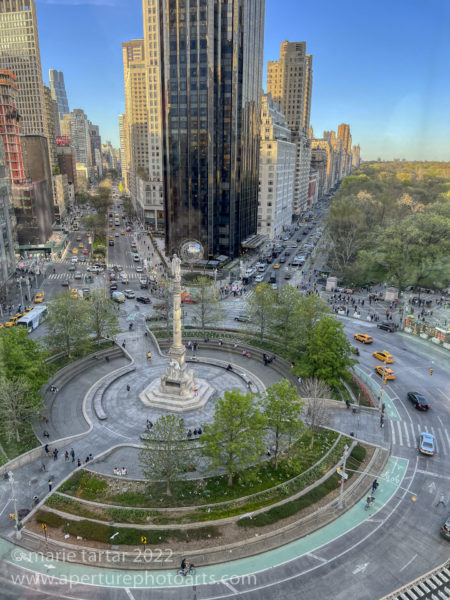
Columbus Circle and a slice of Central park, as seen from Robert, the attractive and excellent restaurant atop MAD (Museum of Art and Design).
We finally made it to see the Frick Madison, the temporary Marcel Breuer home of the Frick collection, while the historic home is renovated. We capped off our week with a searing evening at the theater seeing How I Learned to Drive by Paula Vogel, which reunited its original stars, Mary Louise Parker and David Moses, as niece and uncle in an uncomfortably close relationship.
May-June
An exciting development: the pedal-assist Specialized carbon Creo SL I had been awaiting for months came in. I now am the owner of a bicycle worth twice as much as my 22-year old Audi S4 (still running great with only 116,000 miles!).
My reading included English and Spanish audiobook versions of Isabel Allende’s Inés of my Soul (Inés del Alma Mía). Jimena, our guide in the Atacama Desert in 2019, had recommended this fictionalized account of the life of Inés de Suaréz, who lived with Pedro de Valdivia, founder of colonial Santiago, and was a vital and instrumental founding member of the struggling nascent colony.
The rest of the month’s reading was exploring the work of a contemporary Japanese author, Yoko Ogawa. I immensely enjoyed The Housekeeper and the Professor, a charming tale of a mathematician with an 80-minute memory, who is cared for by a single mother housekeeper with a 10-year old son. I liked it so much, I immediately started another book by Ogawa, The Memory Police, a dystopian tale in which whole categories of things (like birds) are disappeared from the collective memory of a populace.
Our cavalcade of make-up trips postponed by the pandemic continued, beginning over Memorial Day weekend, when we flew to Namibia, by way of Germany, for a trip originally planned as a 60th birthday trip for me in 2020.
We had a small and congenial group of 7, led by professional photographer Martin Bailey, native of England and long term resident of Tokyo. We had experienced local knowledge in our Namibian guide and driver, Forster of Wildlife Safaris. In addition to Steve, me and of course, Greg, our group was enriched by Jon, retired from Shell and hailing from northern England, and Jan, a retired IT exec who grew up in South Africa, worked in Australia and now lives in Switzerland. We had a great time with this group, traveling to all corners of Namibia over 2 weeks in a sand beige Toyota safari van with a pop-top roof.

Giant dolorite boulders in haphazard stacks dot the landscape at the Giant’s Playground, with an occasional scattered quiver tree.
From quiver trees and unusual geologic formations to desolate abandoned desert diamond mining towns to the towering red sand dunes and sculptural tree skeletons of Sossusvlei, the first week of this trip was over the top in terms of variety and photographic richness.
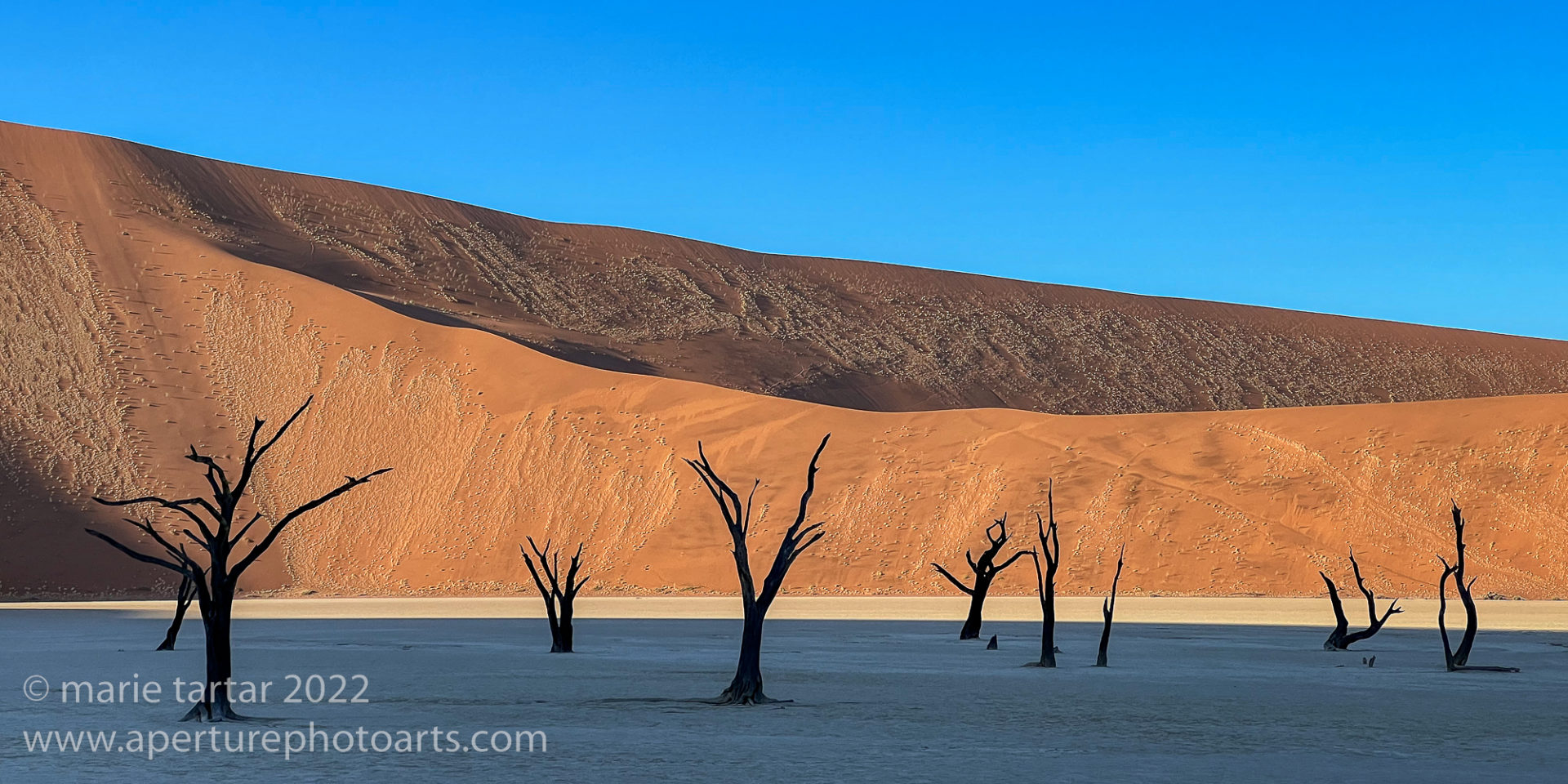
Acacia tree skeletons in a clay pan, ringed by towering red sand dunes, Deadvlei (Sossusvlei) is a photography dream destination.
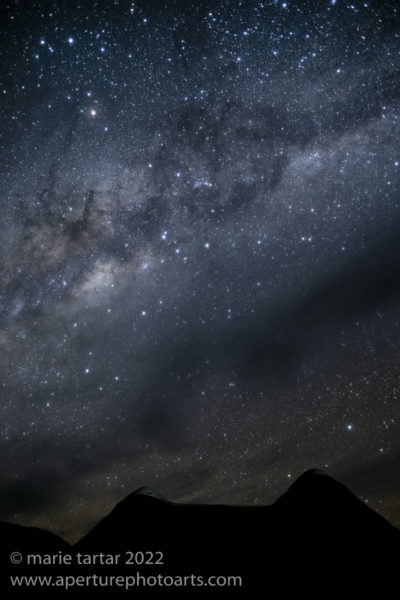
The night sky at Sossusvlei was a revelation! The “mountains” are actually the roofs of our traditional thatch-roofed accommodations.
There were yet more treats in store for the second week.
After recharging by the sea at Walvis Bay, training our lenses on abundant flamingos and pelicans, we headed north along the Skeleton Coast toward Palmwag and the land of the Himba people and finished our sojourn in Namibia with four magical days at Etosha National Park on safari, dividing our time between two marvelous lodges, one on the western border (Ongava) and the other on the eastern (Onguma). Although we’ve had better spotted cat encounters in Kenya and South Africa, our rhinoceros encounters were our best ever, with amazing elephant, giraffe and bird sightings along the way.
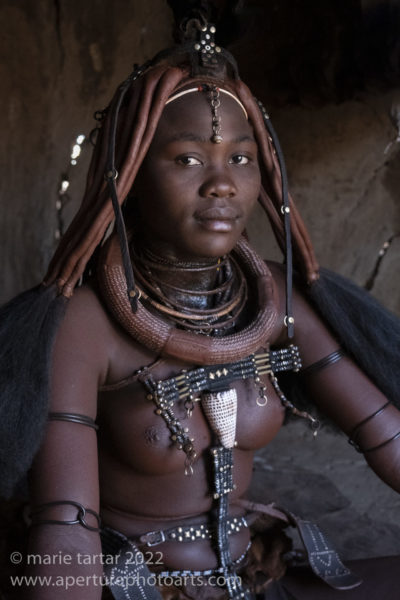
The Himba people are semi-nomadic but have managed to preserve (for the most part) their traditional culture.
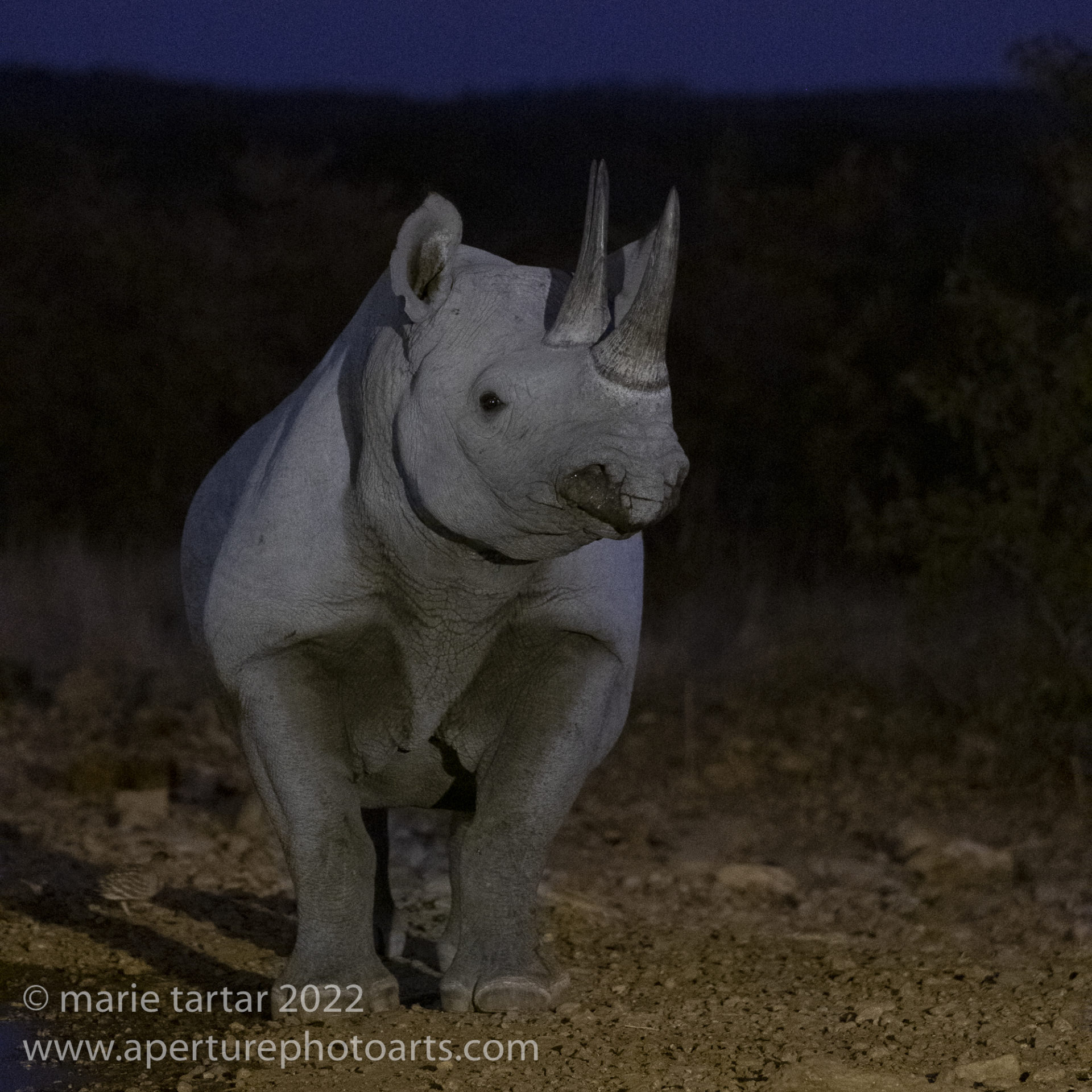
Watering hole blinds at Ongava, our Etosha-adjacent lodge, provided even more opportunities to observe and photograph rhinoceros, even after returning from safari drives.
I managed a surprising amount of reading (largely via Airpods listening to audiobooks) on this trip, between long flights, layovers and stints in the vehicle. Much was Africa-focused, including Noviolet Bulawayo’s brilliant animal allegory of Zimbabwe and its political struggles Glory and Paradise by Abdulrazak Gurnah. I also enjoyed Charles Yu’s satirical and funny Interior Chinatown: A Novel.
We arranged our return from Africa through New York, where we spent a jet lag recovery long weekend before heading back to the West Coast. We managed four theatrical performances in three days, starting with A Strange Loop. I had considered this as a potential investment, but ended up passing on it. A Strange Loop drew an enthusiastic and expressive audience. It had recently won the Tony for Best New Musical. I enjoyed it but struggled a little with jetlag despite the energy of the performers, led by Jaquel Spivey as Usher, a Lion King usher and aspiring musical writer working on a self-referential musical centered on a black, gay, overweight musical writer much like himself. He is taunted by doubts and his inner voices are brought to life by 6 Thoughts, who play roles ranging from his religious and skeptical parents to his Daily Self-Loathing. Two of the Thoughts were nominated for Tony awards (L. Morgan Lee and John-Andrew Morrison), as was Spivey in his Broadway debut lead role.
I struggled a little staying awake the next day at Dreaming Zenzile at New York Theatre Workshop (a co-production with National Black Theatre), despite the power of the story and performances, drawn from the life of South African singer and activist Miriam Makeba, portrayed by singer and songwriter Somi Kakoma, who grew up in Illinois as the child of Ugandan and Rwandan immigrants.
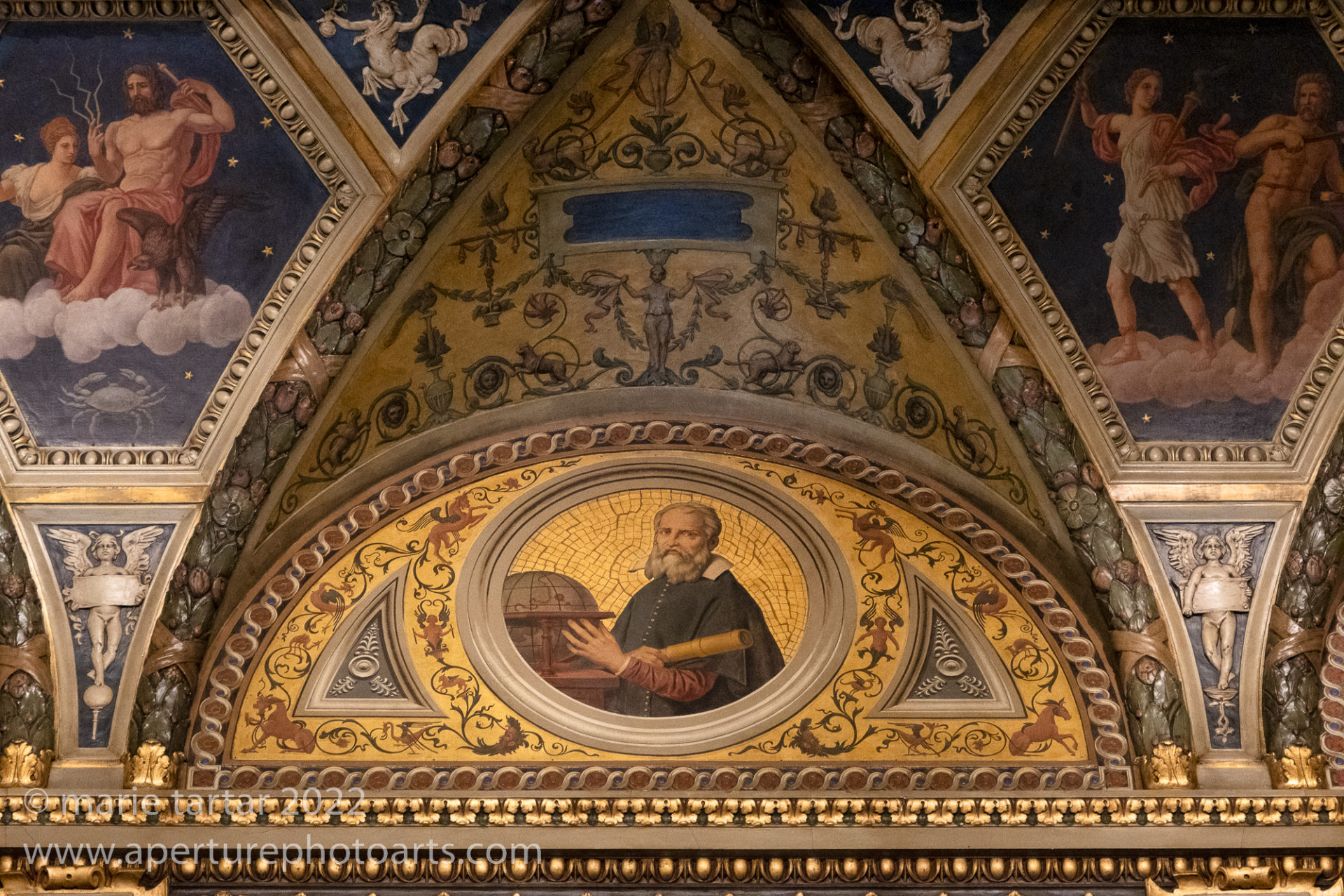
The ceiling of the Library room, in J. Pierpont Morgan’s former residence, is spectacularly embellished by muses and luminaries of various disciplines; this looks like Galileo to me.
We packed a lot into our final full day, starting our Saturday with our first visit to the Morgan Library, followed by a theatrical double header. I’d read the prior day about the recent refurbishment of the exterior and landscaping of a side garden of the former home and collections of J. Pierpont Morgan.
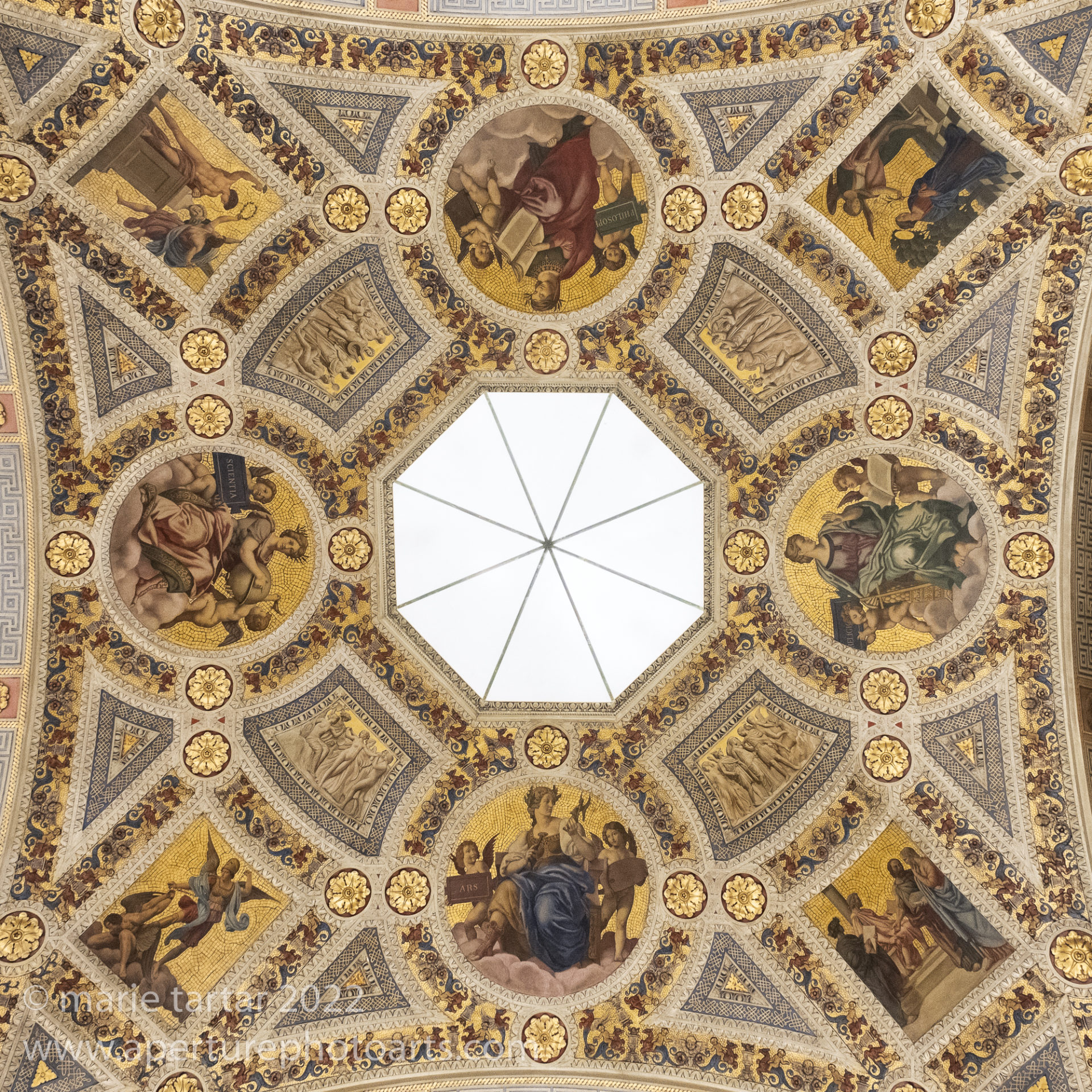
Another spectacular overhead view, from the Rotunda connecting the Library room to J. Pierpont Morgan’s former private study.
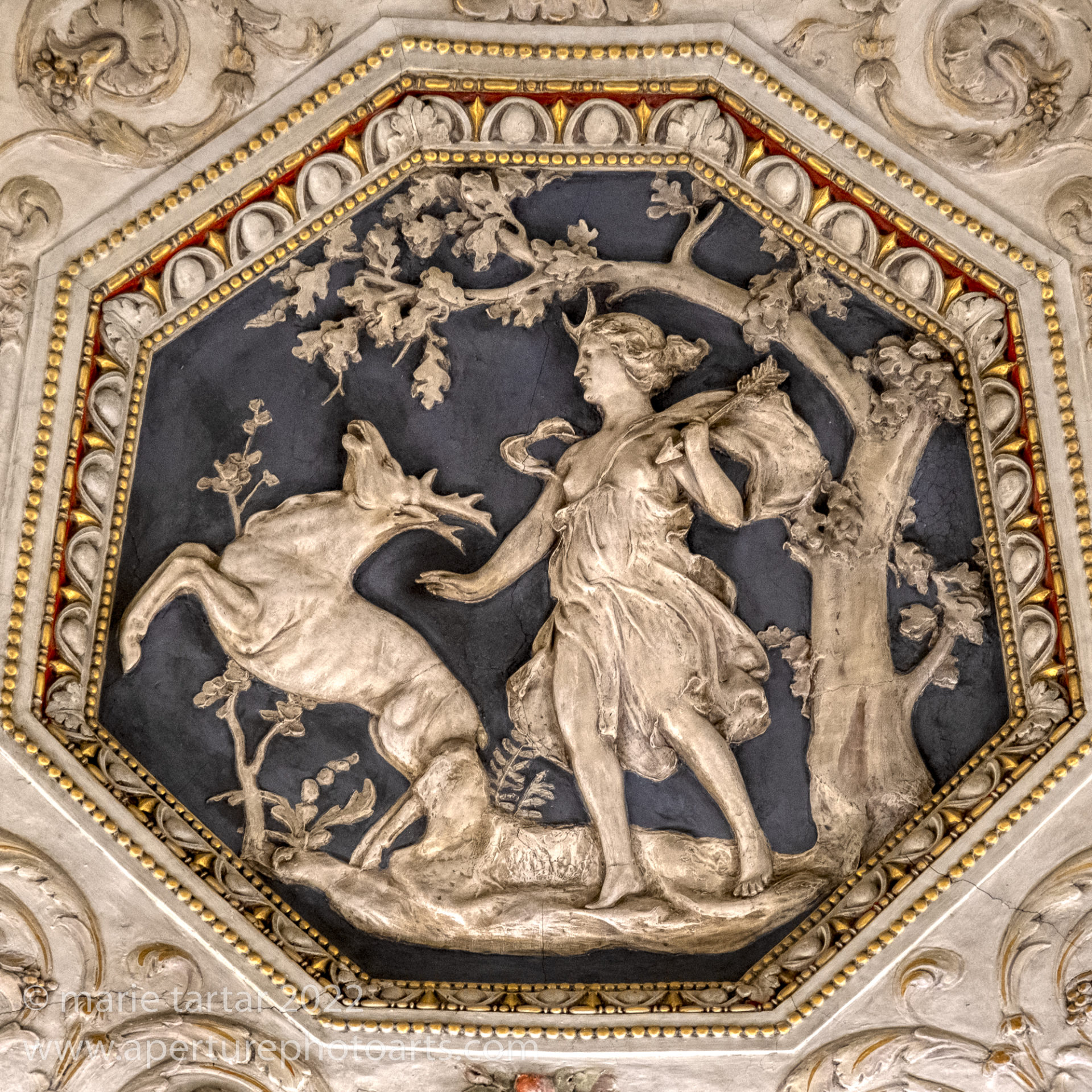
Eye-candy decorations abound at the Morgan Library, including hexagonal reliefs based on earlier work of Raphael; this appears to depict Diana the Huntress.
There was just time for a quick fallafel lunch at Taim en route to a matinee at the Linda Gross Atlantic Theater to see The Bedwetter, based on Sarah Silverman’s autobiographical book, The Bedwetter: Stories of Courage, Redemption and Pee. The show was preparing to open just as everything shut down in March 2020. Musical composer Adam Schlesinger died of Covid within the same month. Zoe Glick played exuberant and irrepressible 10 year old Sarah, whose parents (Cassie Levy and Darren Goldstein) are divorcing and whose older and prettier sister (Emily Zimmerman) really doesn’t want to jeopardize her own social standing at a new school by acknowledging her. Nana (Bebe Neuwirth), Sarah’s loving grandmother, enjoys too many Manhattans, which Sarah is trained to mix to perfection.
We managed a quick visit to the Museum of Chinese in America (frustrating, with confusing signage, impeding delving into the impactful ephemera on display), prior to a quick dinner of asparagus, tagliatelle and shaved brussels sprout salad at La Pecora Bianca. Fat Ham (another Co-production with National Black Theatre) at the Public Theater by James Ijames was recently awarded the Pulitzer Prize. Juicy (Marcel Spears) sees the ghost of his father while preparing for a BBQ to celebrate the recent marrriage of his mother (Nikki Crawford) to his father’s brother (Billy Eugene Jones), only 1 week after his father was killed in prison. His father’s ghost tells him he was murdered by his brother and Juicy must avenge him, comic shades of Hamlet. This was the theatrical highlight of this visit-we both found it hilarious and touching, and even stayed for the talk-back.
We rounded out this long weekend doing a Sunday morning bird-watching walk in Central Park.
Usually, we don’t have any significant glass with us to photograph birds in New York, but coming back from Namibia, we were armed with long lenses and teleconverters.
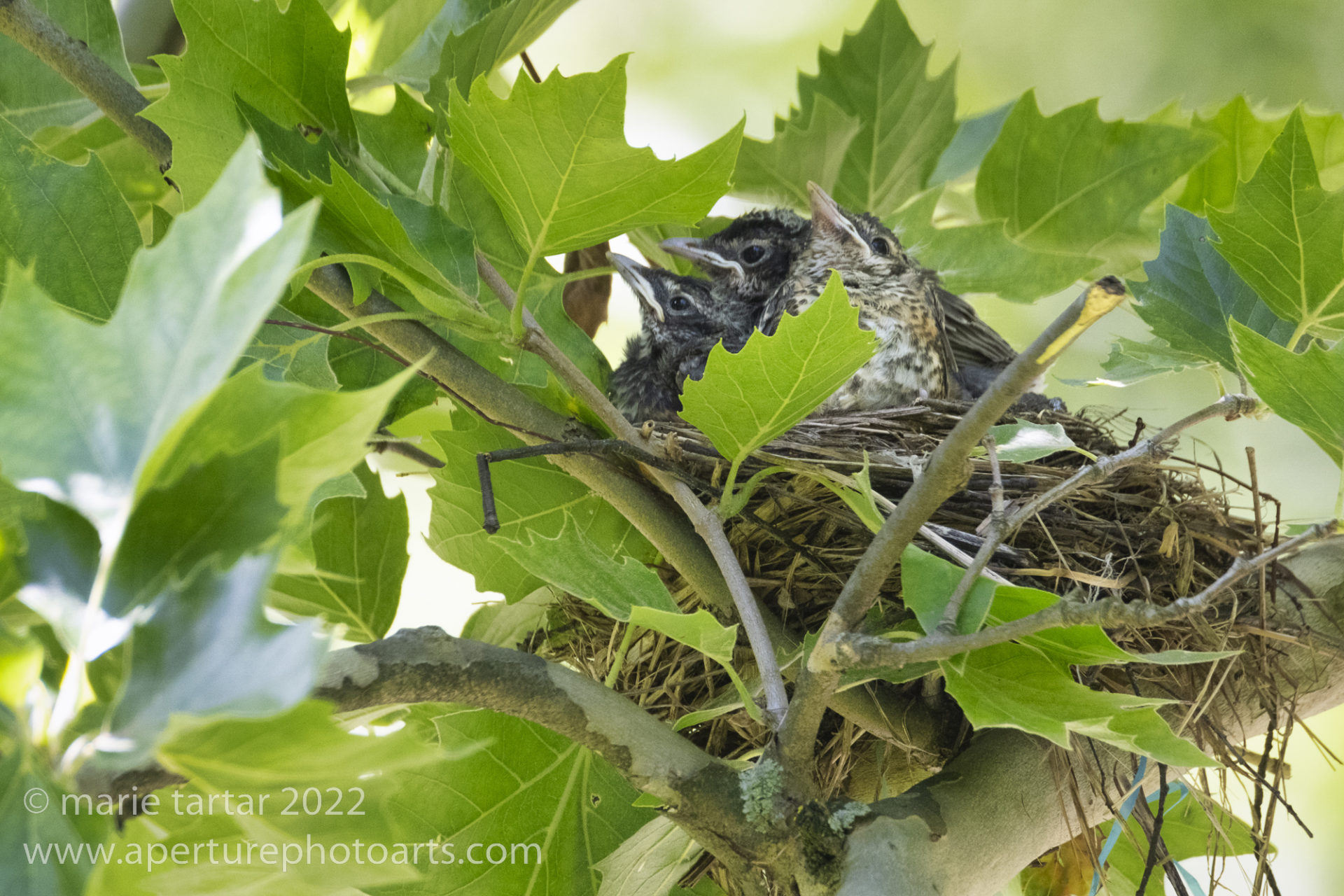
A trio of robin chicks waits expectantly for a parent to return with food, overhead in Central Park.
We met up with Sandra and a group of 20+ people at the Loeb Boathouse in Central Park at 9:30 am and over the course of the morning, sighted a great horned owl (way up in a tree), nesting robins and even a sleeping raccoon, perched high up in the crotch of a tree.
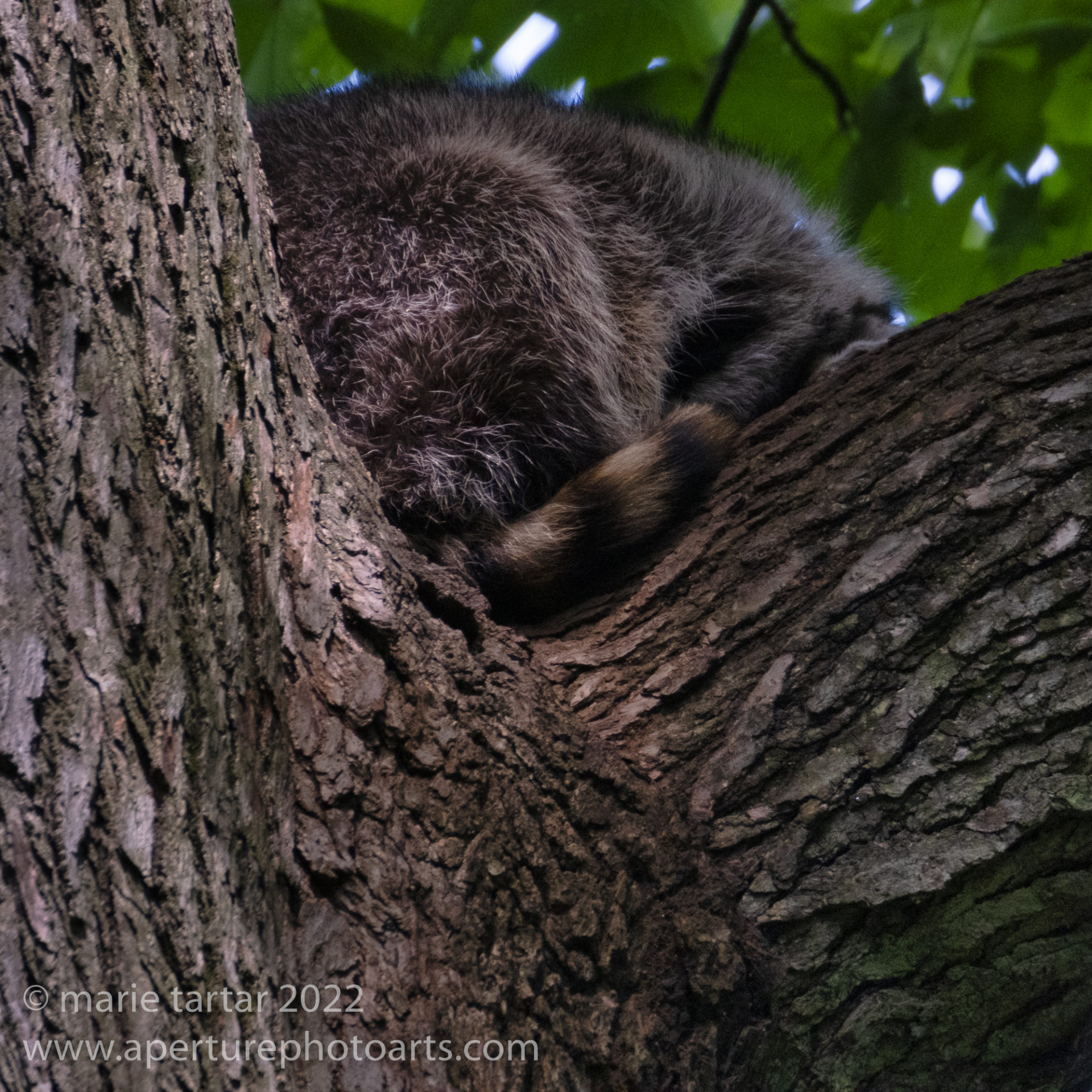
Safely tucked into the crotch of a towering tree, a raccoon can catch up on sleep, even in the middle of Central Park.
We learned that many turtles in the Park’s ponds are an invasive species, red-eared sliders, often abandoned pets.

I was dismayed to learn these residents of Central Park probably are abandoned pets (red-eared slider).
Africa was much on my mind in my reading, continuing with Americanah (2013) by Nigerian novelist Chimamanda Ngozi Adichie. Americanah is Nigerian’s term for their countrymen who return to the country after extended stays in the US. I admired the writing and ear for dialogue so much that after finishing it, I immediately started another book by the same author, Purple Hibiscus, Adichie’s debut novel from 2003. It also takes place in Nigeria, in a privileged household where teenagers Kambili and Jaja are terrorized by their domineering and corporal and hyper-religious father. The final selection of this African-themed reading/listening binge was a title I somehow had never read, Alan Paton’s Cry, the Beloved Country I think my beloved humanities professor in college, Dr. Swaim, recommended this to me back then. It is a classic from 1948 , both heartbreaking and hopeful, set in 1940s South Africa. An older rural Zulu pastor, Stephen Khumalo, journeys to Johannesburg in response to a letter from a priest saying his sister Gertrude is ill. Khumalo has seen his brother John and his own son Absalom effectively disappear when they left for Johannesburg, from which he receives no news of them. In tracking down his son, he is aided by priests who befriend him. The ways of the city and the country are contrasted, with the hardships of life for blacks in Johannesburg amply displayed.
July
July started with our 33rd wedding anniversary. We considered going out but decided to stay home and watch a movie. Steve prepared a delicious lobster risotto and we broke open a bottle of 2004 vintage champagne. I wanted to rewatch The Gods Must Be Crazy (since portions were filmed in Namibia) but we couldn’t readily locate it, so we watched Todd Hayne’s The Velvet Underground, which made the New York Times Top Ten Films of 2021 lists .
The theatrical highlight of the month was definitely Freestyle Love Supreme at the Old Globe. Not having interacted with any other people during a Saturday at home, I couldn’t throw my hand up at Freestyle Love Supreme at the Old Globe to tell what I did that day, for the performers (Andrew Bancroft aka Jelly Donut, Anessa Folds (Young Nees), Kaila Mullady (Kaiser Rözé), Morgan Reilly (Hummingbird)) to incorporate into a spontaneous, improvised rap story. This 90 minutes was so much fun! Steve loved it too. We had exchanged our seats and lucked into a fantastic, unobstructed pair. The performers solicited stories and words as take-offs for riffs. Joe in the audience related how as a 3 year old, he’d been tricked by his 7 year old brother into eating his newborn infant brother’s umbilical cord stump, telling him it was a raisin. The cast had a field day with this!
My Africa focused reading continued, with Mark and Delia Owens’ first book, Cry of the Kalihari, an account of their 7 years as wildlife researchers in the unforgiving desert, camping and living with (while studying) brown hyenas and lions. I also read Islands of Abandonment: Life in the Post-Human Landscape by Cal Flyn for an upcoming bookclub meeting, a cautiously optimistic assessment of nature’s power to heal human-scarred landscapes. Our book club met in person this month, for the first time in a year and the second time since the pandemic began, at Steph’s perfect midday venue, a long table outside on a shaded front patio. There was uniform admiration among the 8 attendees (Barbarella, Steph, Sheila, Mary, Pat, Frances and Ann) for this session’s selection, Nobel prize winner Abdulrazak Gurnah’s Paradise. To try to keep Steph’s delicious food (gazpacho, chickpea and cucumber salad, green salad, potato salad and strawberry shortcake) and Barbarella’s gorgeous chocolates off my mid-section, I rode my bike there and back, exploring the new bike path Steph mentioned to me between Manchester and Birmingham on the return.
A personal cycling era ended this month: my cherry red Klein, which I used for commuting to and from work for 16 years until displaced in my affections by my Specialized pedal assist Creo, was bought after work by Aldo, who drove up from Chula Vista with $500 cash in response to Steve’s post in Offer Up.
Mid-month, we began tackling the onerous task of reviewing our dive gear and preparedness for resuming diving, including in cold water. This required backing out the car to make multiple piles of give-away items, separating out tropical gear from cold water items and back-up pieces of gear. We could have saved a ton of money if we had forfeited our deposits for the British Columbia God’s Pocket trip (postponed 2 years by the pandemic), as doing the trip required (besides paying for the rest of the trip and the airfare to Canada) buying Steve a new drysuit, boots and underwear, replacing the shot seals on my drysuit, new gloves and hoods for both of us, having our tanks inspected (for the Channel islands, where we did a preparatory trip, to make sure our skills and equipment were up to date, since it had been 3 years since our last foray in drysuits). Also in the mix of dive-related errands were two runs to La Mesa by Steve for new prescription diving masks for the aging eyes.
Joe, Mama and I did an aquarium excursion, to see the new section devoted to the smallest penguins, blue penguins, native to New Zealand.
We tiptoed into The Lot in La Jolla to see a mid-day show of Jordan Peele’s new comedic horror film, Nope. As hoped, it was nearly empty. Covid cases were again rising and everywhere I turn, people around us were coming down with it in Pandemic Summer 3, so we were still skulking around, trying to avoid people. The film was an enjoyable amalgam of sly social commentary and inventive horror, with a Black cowboy on the fringes of Hollywood as the hero (Daniel Kaluuya). This character brought to mind the protagonist of The Sellout (Paul Beatty). OJ’s (Otis, Jr) calm, laconic demeanor contrasted with his energetic, flightier sister (Keke Palmer). Strange happenings on their horse farm bring the siblings together to fight an unusual presence.
August-September
The summer of preparation for cold water diving continued throughout August, right up to our departure at the end of August to head up the coast to Santa Barbara, from which we would board the Vision for a 5 day live-aboard trip over Labor Day to the Channel Islands, a dress rehearsal for our September British Columbia dive trip. This would give us a chance to reacquaint ourselves with our gear and reassure ourselves we still knew how to assemble our underwater cameras, how to dive and how to maneuver the tricky air bubble of a drysuit.
The only relaxing week was a week off in Sedona, which was pleasantly passed seeking out cool summer pastimes, including climbing down into a subterranean lava cave in Flagstaff, which stays a constant cool temperature in the 40s.
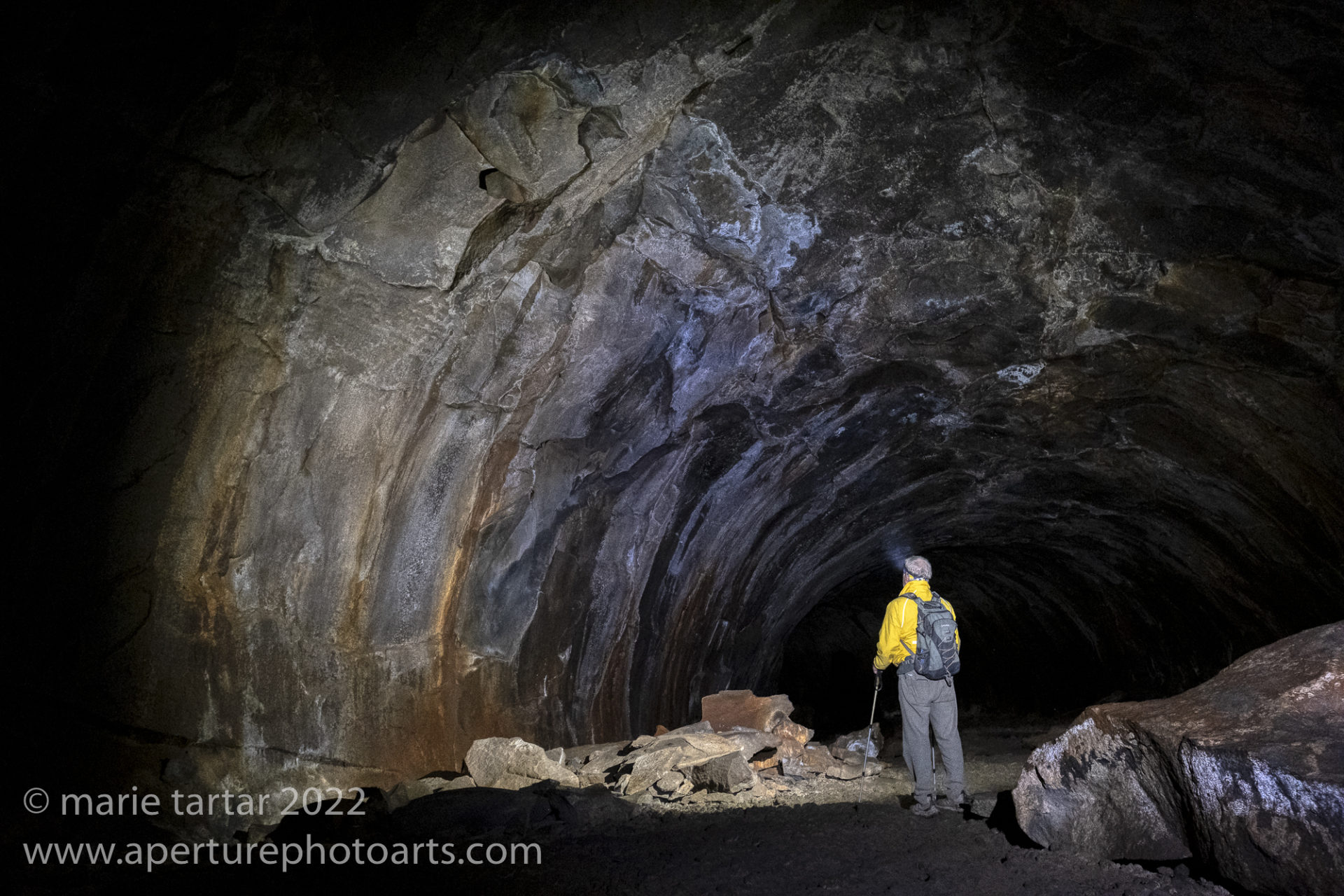
Beating the heat in Sedona in August: the perfect time to explore a subterranean lava river cave in Flagstaff, where it is always a chilly 42 degrees F all year round.
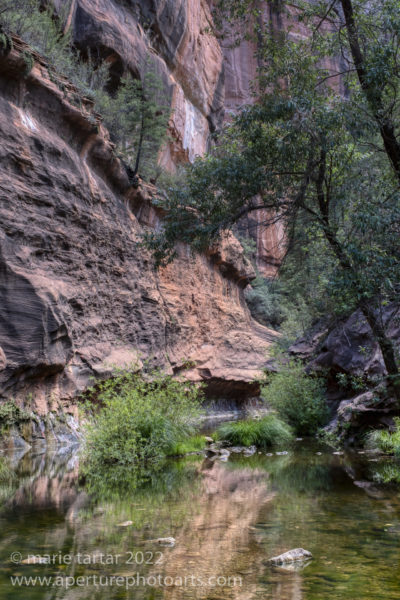
Another beat the heat summer option in Sedona, an every season favorite hike, the West Fork of Oak Creek.
Six months had passed since our Sedona Film Festival trip in late February. We arrived to find a small leak in the roof and that one of the two air conditioning units had failed. We reluctantly decided it might be better to have a more continuous human presence in the house and to try renting out the house on a monthly basis between stays. Thus, we spent significant time thinning our closets and preparing the house to be rented via Vacasa.
Our Channel Islands dive trip fell into the middle of 2 weeks off, so we used the opportunity to do a pre-trip up the coast as far north as the southern end of Big Sur. It had been 18 years since our last trip to Big Sur! After dropping our dive gear off in Santa Barbara, we made our way 2 hours north to Morro Bay, where we overnighted on the cool, foggy coast at the tiny (8 room ) Anderson Inn. Although they were scarce on our arrival, we spent a delightful next morning photographing sea otters at wonderfully close range.
Our next two nights brought more delights, staying in a well appointed and located casita in walking distance of Paso Robles’ charming downtown. This was a great base for exploring Paso for the first time, spending one delightful weekend evening meandering through the Bruce Munro light installation, Sensorio.
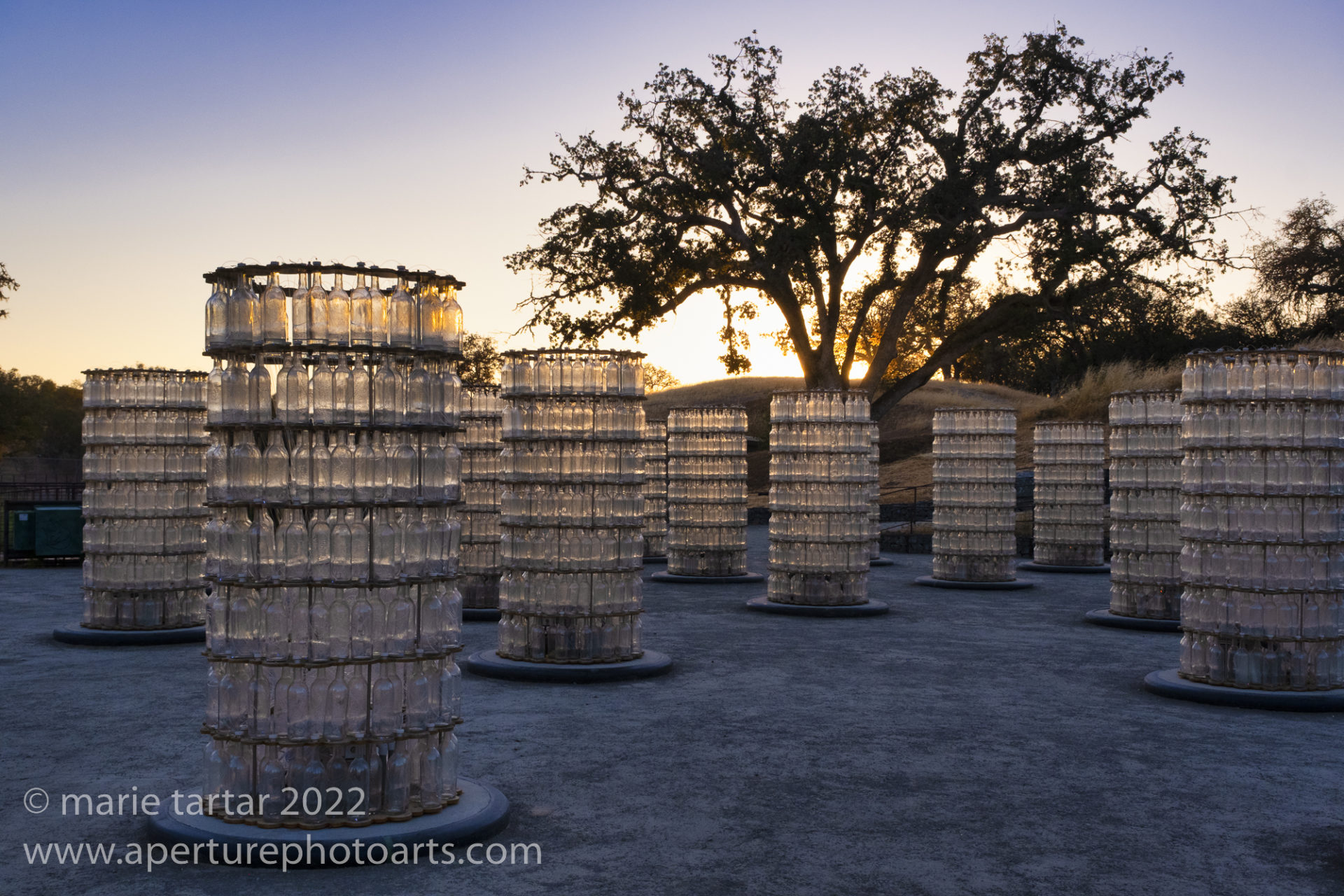
Waiting for the sun to set at Sensorio, a large light installation by Bruce Munro. Paso Robles being in wine country, wine bottles were employed to build these light sculptures. The Light Towers were inaugurated in 2021, one benefit of dilly-dallying on seeing this installation.
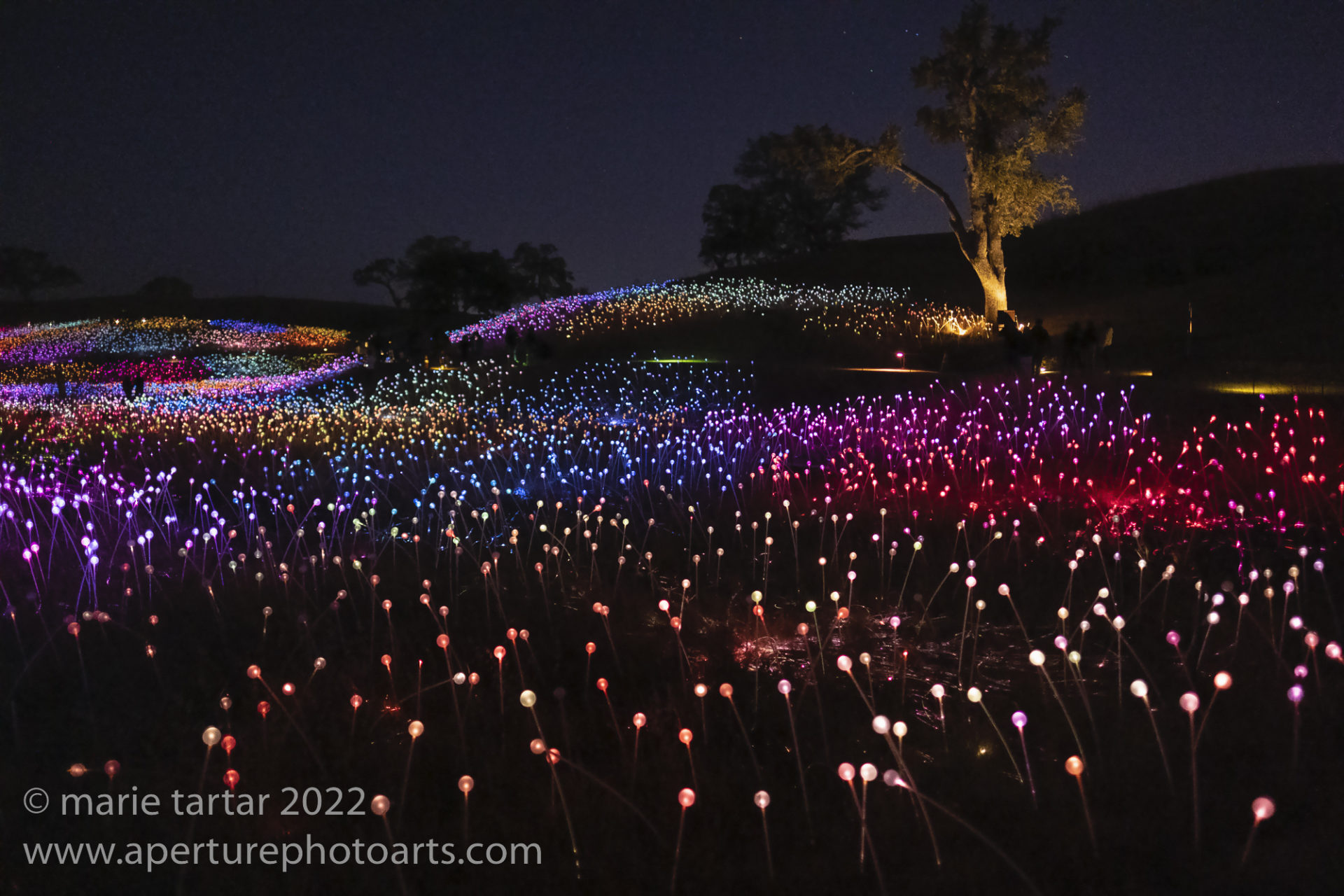
The gentle hills of Paso Robles accentuated by innumerable fiber optic lights at Sensorio. The Field of Lights opened in 2019 as the original 15 acre installation.
Another day was spent wine tasting and enjoyable an excellent lunch and views at Daou Vineyards. We concluded this pre-trip by staying 2 idyllic nights in a yurt enclave near Gorda in Big Sur called Treebones, which has 2 excellent restaurants, including a tiny, 8 seat, 2 seating per night sushi bar, where we had a fabulous omakase meal.
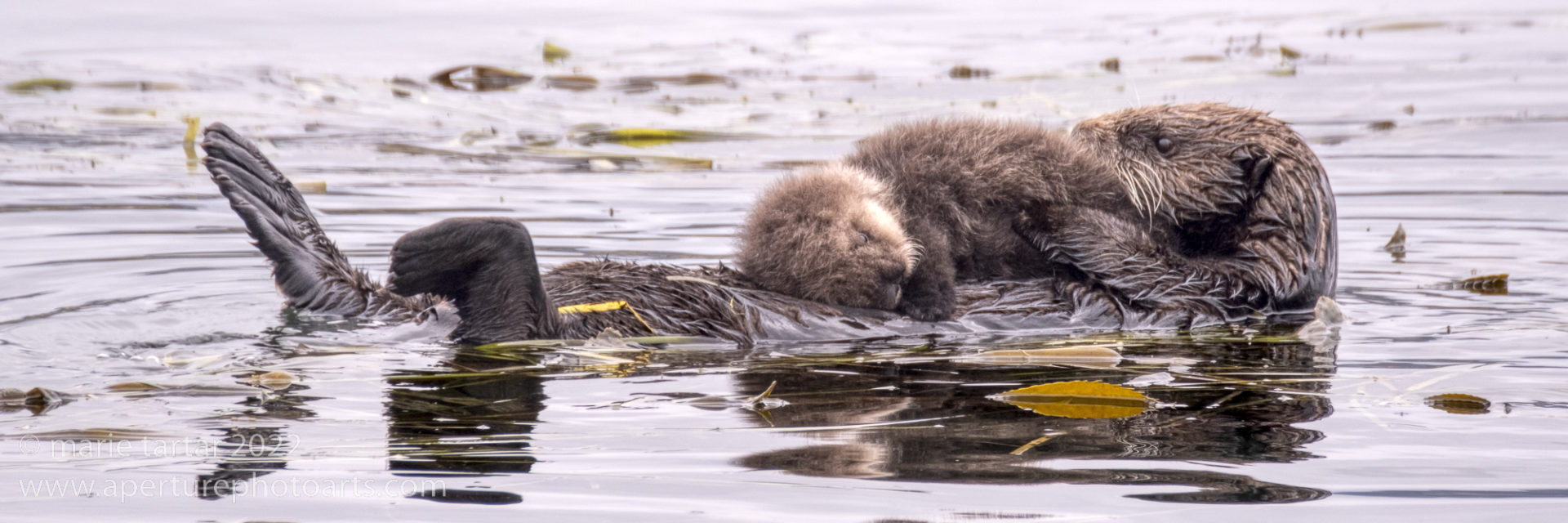
Sea otter parent with sleeping baby on abdomen. Otters wrap themselves up with kelp stalks to help anchor their positions in the water. We enjoyed our time in Morro Bay with the sea otters so much that we stopped there again on our way back down the coast to Santa Barbara.

Sea otter parent and baby. The parent continuously grooms the baby’s extremely dense fur, which early in life, traps too much air for the baby to dive.
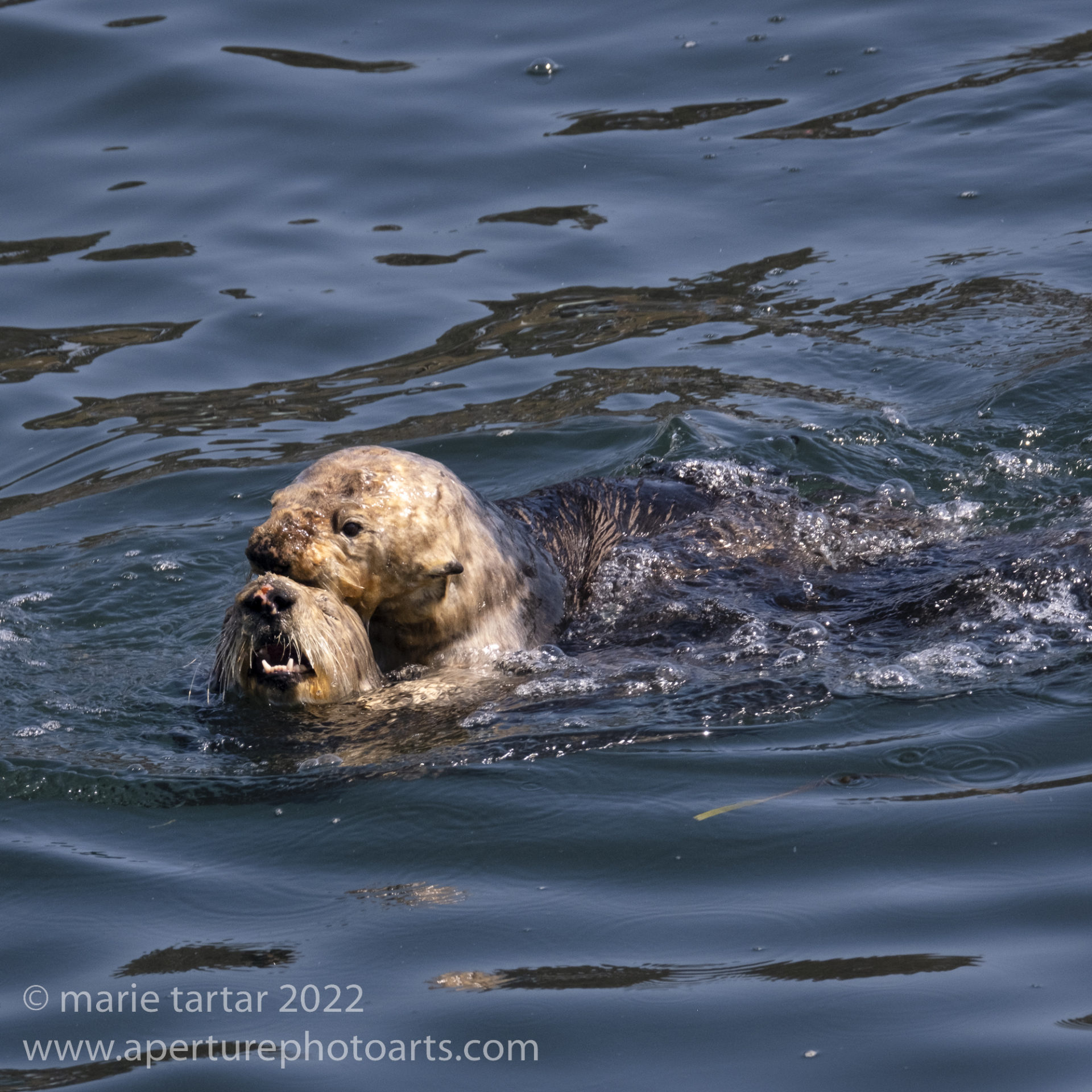
Just as we were heading back to the car to continue our drive south to Santa Barbara for the dive trip, a pair of sea otters tumbling over and over like a pair of well oiled wrestlers caught my attention: they were mating! Mating between sea otters looks intense, borderline violent. The pink on the nose of the female (below) might be an injury inflicted by the male (behind) as he bites the nose or head to grasp the female.
Greg flew in to join us in Santa Barbara for our 5 day Channel Islands trip with Adventure Sports in Santa Cruz. He was in the same boat as us, too long since his last stint diving in a drysuit. Watching him suit up was hilarious, as he bore a strong resemblance to one of those blow up figures that gestures wildly to attract attention to car washes. Orange kitchen gloves attached to his sleeves render him quite helpless while donning the suit. This trip was mostly a success, although not without its issues. I experienced a drysuit flood due to failure of one of my companions to completely close my zipper and of me to check it. My TankPod would not communicate with my wrist-mount Suunto dive computer. Steve noticed his new-to-him Waterproof suit, although it had passed a pressure test, had one wrist seal that looked vulnerable. This meant we had to arrange to get new seals onto the suit with a very short turn-around before British Columbia. He also managed to lose more hearing, inadvertently setting off a momentarily blast of his airhorn directly in one ear, while trying to doff his rig. Mostly, we accomplished our goals of confirming we still knew how to dive in drysuits, build our underwater cameras without flooding them and that we were mostly comfortable with our newly updated gear.
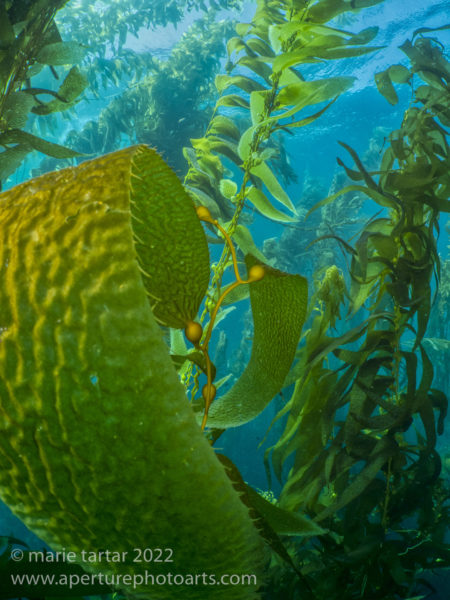
San Clemente: The kelp forest on a sunny summer day is magic! Especially precious as kelp forests are vastly reduced in recent years, a phenomenon a pair of French film makers on board our boat were investigating.

Steve had his own private black sea bass to himself for a dive at San Clemente, Channel islands. Steve claims “He just kept coming around!”.
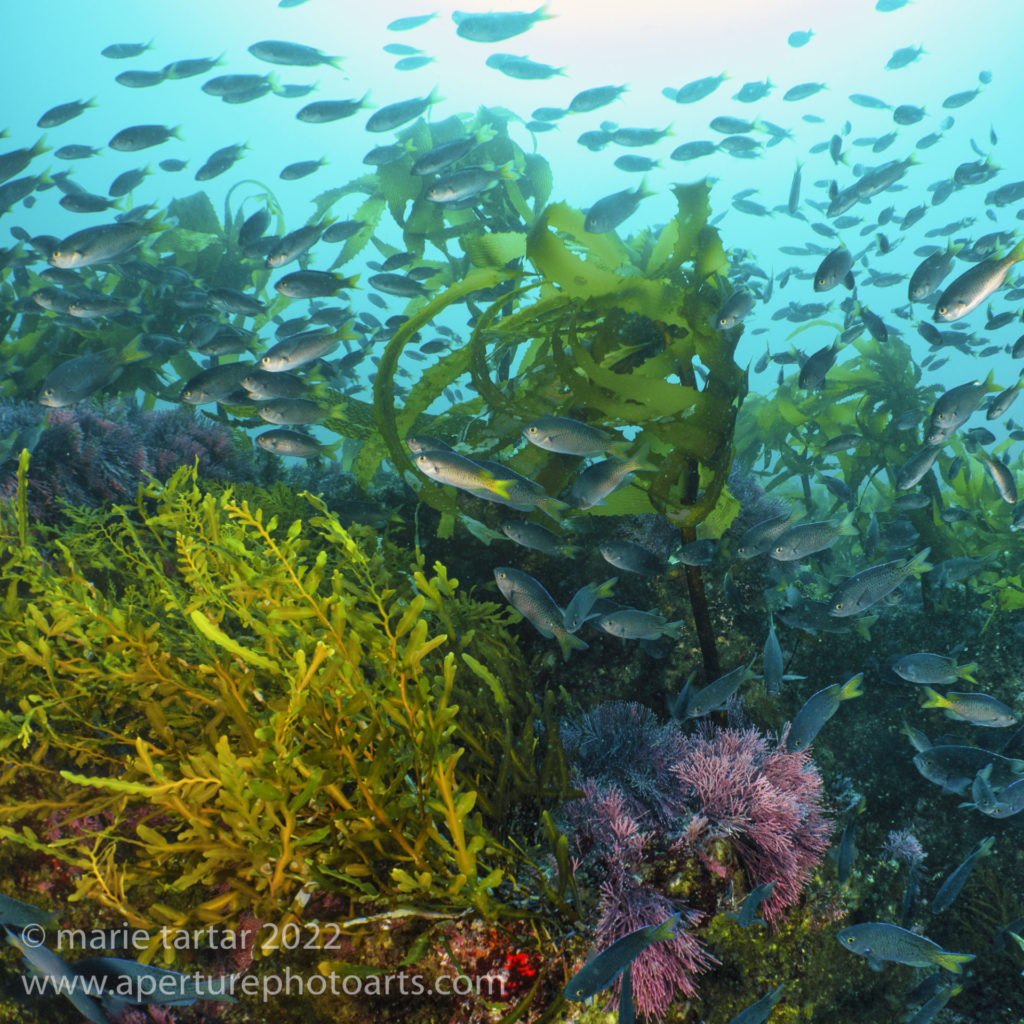
We motored all night to reach remote Cortez Bank, which is completely submerged and unprotected. This was our first time to make it there. It was fishy but I would have preferred another day at San Clemente.
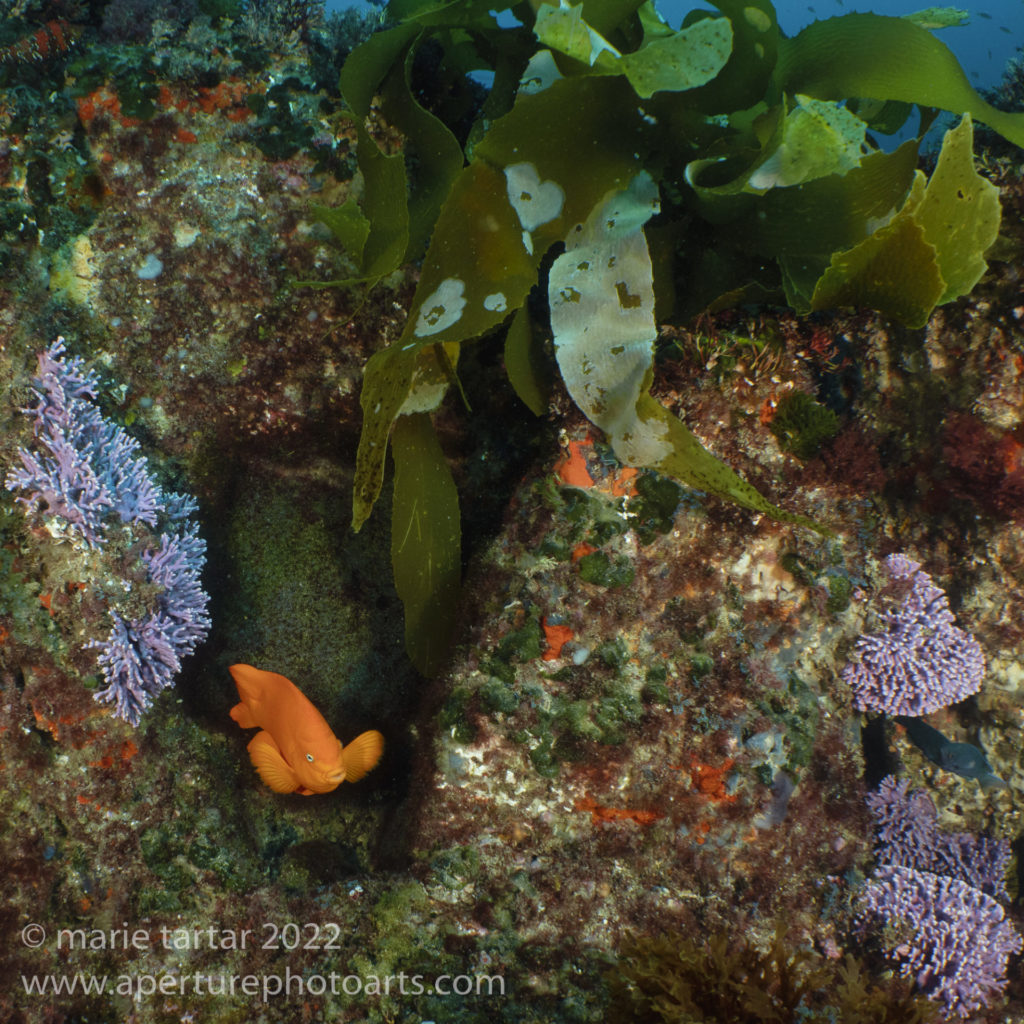
We spent the 4th day of our Channel Islands live-aboard trip on the Vision at Catalina, including 2 dives at Farnsworth Bank, a submerged pinnacle on the backside of Catalina with abundant purple hydrocoral. Here a garibaldi nurtures a patch of algea (brown behind) in hopes a female will lay a clutch of eggs there.

Our last dive day was freezing cold, with green water and limited visibility, at Santa Cruz. A cluster of brittle stars is seen at the base of a red gorgonian.
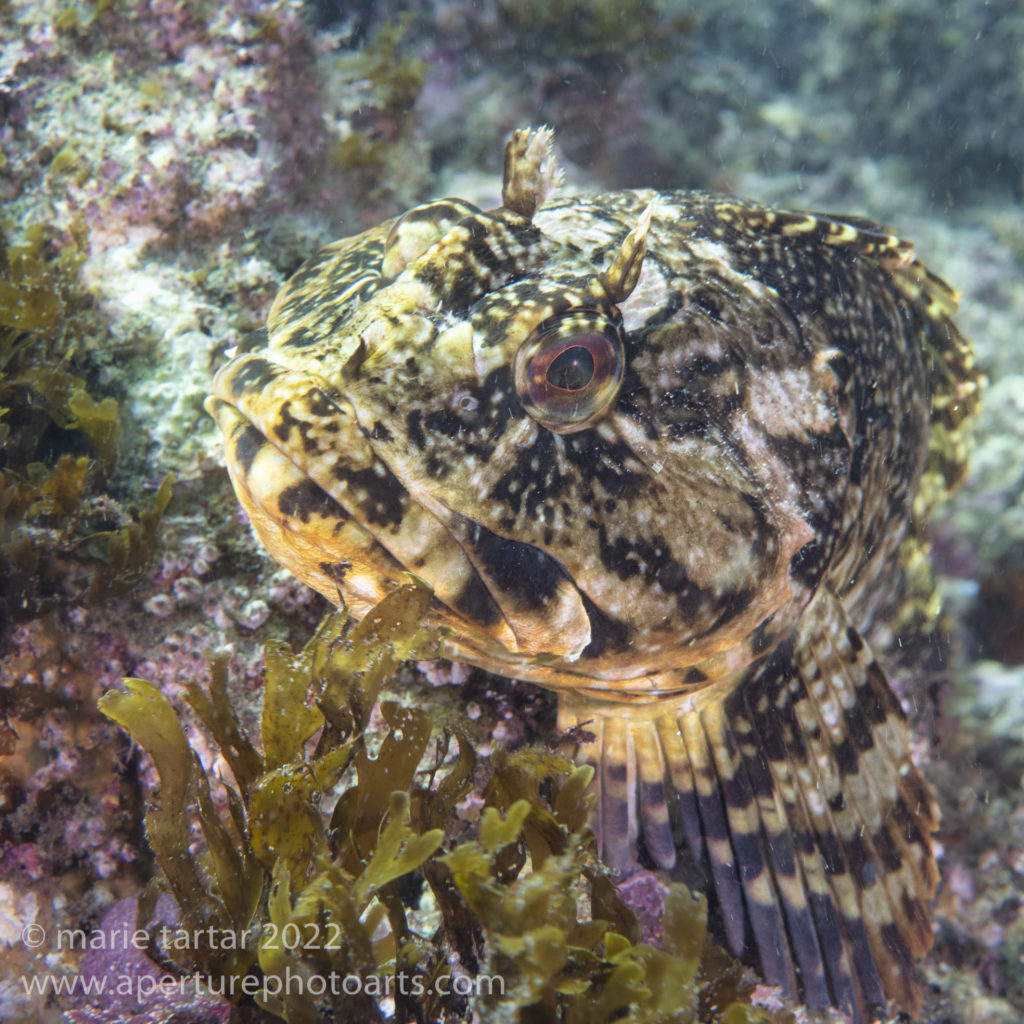
Low visibility at Santa Cruz prompted me to switch to shooting macro. This is a cabezon. The name derives from Spanish, meaning “big headed” .
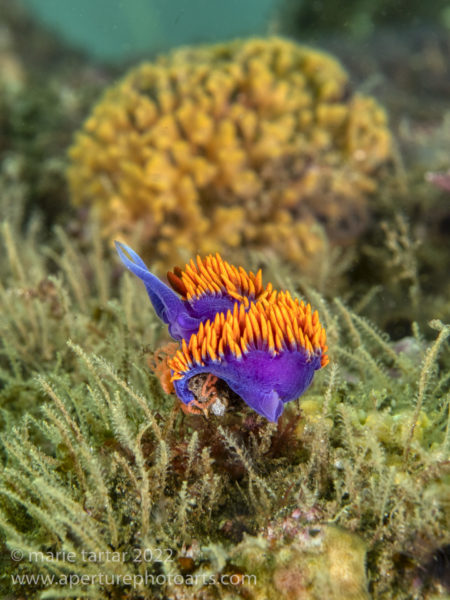
The current kept the Spanish shawl nudibranchs folded up but it was wonderful to see them again (Santa Cruz Island, Channel Islands).
The final third leg of our two weeks off was a long weekend in New York. We drove back from Santa Barbara Tuesday night and flew out the next day. New York was delightfully cool, while San Diego and southern California were in the midst of a heatwave. We finally made it to the McKittrick Hotel, scene of the long-running, immersive theater production of Sleep No More. It was an atmospheric, athletic experience, running after actors in the dark, charging up and down stairs trying to keep up. The timely extension of Sondheim’s Into the Woods gave us a chance to see a really charming and critically-lauded production. A Saturday matinee was enjoyably passed seeing a 2-actor musical Joey produced, Los Otros, starring Cesar Samayoa (longtime cast member of Come From Away, since the beginning) and Luba Mason as southern Californians whose seemingly widely divergent lives overlap over the decades. It was a good thing we walked all the way to Soho from Hell’s Kitchen to meet Sarah and Aaron for dinner at a new Thai restaurant, Wan Wan, because somehow, we managed to squeeze in dessert afterwards from nearby Rice to Riches, the incredibly decadent rice pudding emporium.
Greg flew into New York on Friday to attend a memorial service for a former Sothebys curator friend and we met up afterwards for a marvelous lunch at the bar in MOMA’s The Modern. The prior day, Steve and I had been blown away by a comprehensive survey at ICP (International Center of Photography) of the work of William Klein, a New Yorker who lived and worked in Paris. Back in November of 2014, on a trip to Paris with MOPA for Paris Photo, we met a representative of Hackleberry in London, which had just published a book of formative, experimental abstract light and shadow photos of Klein’s, created in 1952 and printed in 2014. The book was $2000 and included a choice of one of 6 prints. We were very taken by this work but somehow never decided how many or which of the prints we wanted and back at home, life swept on and we never decided. This work was prominently featured in the show we admired at ICP and I found myself wondering if there might be copies still available. While still in the museum, I did an internet search on my phone, which suggested there was a copy available-in New York-at the well known Howard Greenberg Gallery. I called and confirmed that yes, they had one copy (and the price had dropped from 2014!). Could they text me an image of which print was included with their copy of the book? They could and it proved to be my favorite, which was blown up huge in the gallery devoted to this phase of his work. I decided this was meant to be and that it would be perfect for Steve’s upcoming 65th birthday. I arranged for them to hold it and said we’d come by the next day. Greg accompanied us to the gallery on 57th Street, which had a small show up of Klein’s work from Africa.
In a strange coincidence, Klein died in Paris the very next day.
We had a short turn-around between our trio of California trips and departure for British Columbia: 4 working days. We had great memories of our two prior live-aboard dive trips on the Sea Venture to this area, as well as a camping and kayaking trip, all back in the 1990s. The dive scene has dramatically changed since then. There are no more live-aboard boats plying these waters, where once there had been 7! We’d been hearing about a land-based, off the grid resort, God’s Pocket, for years and had been scheduled on this Alex Mustard workshop for 3 years. The pandemic pushed it back 2 years. The resort isn’t luxurious, but it has a certain rustic charm and the essential elements are there in abundance: fantastic food, hot water and a well organized dive operation. It did take a little getting used to the “tannin” color of water swirling in the toilet and coming out of the tap.
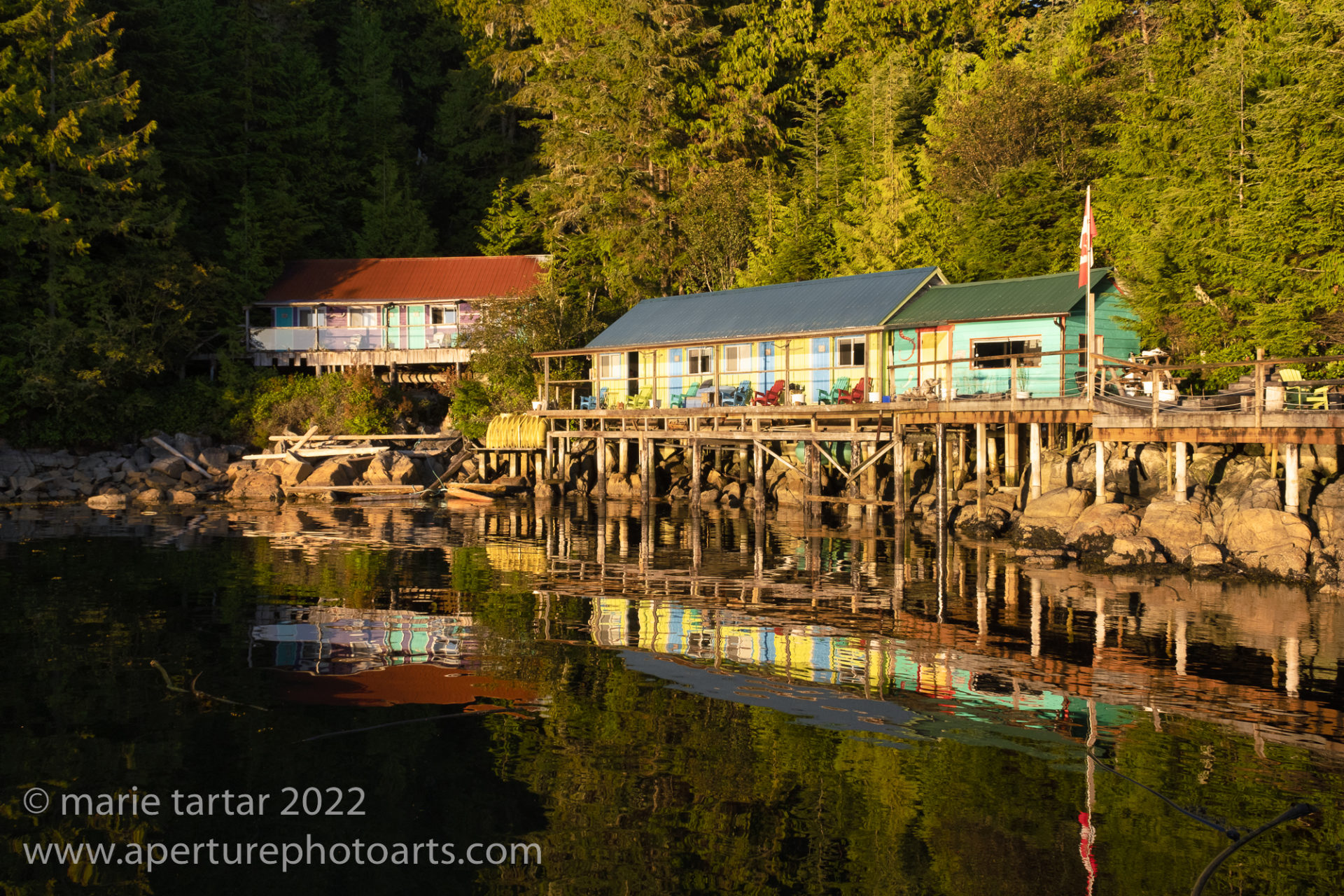
God’s Pocket Resort is tucked into a peaceful cove on Hurst Island, about an hour by boat from Pt Hardy in northern Vancouver Island. It has had a variety of incarnations over the past century: fishing lodge, post office, a general store, a fuel dock and a shipyard.
I vividly remember Captain Al Spilde on our earlier trips saying “Don’t move, don’t try to help, it’s faster if I do it” as he unbuckled our BCDs and stripped our fins off us after each dive. Then he poured hot water into our gloves to start the defrosting process. The Hurst Isle, the boat Captain Chris piloted on this trip, has a fantastic improvement to this process: a hydraulic elevator! Our dive guide, Bryan, would send it down when we reached the boat. When it stopped moving, we’d shuffle onto the platform, fins and all and hang on, then be hoisted up to the boat, shuffle forward a couple of steps and proffer one foot at a time (like a horse being shod) to be divested of our fins. Genius!
For a short trip (5 diving days), this was photographically ridiculously productive! That reflects the richness of the waters there. Here are some favorites:
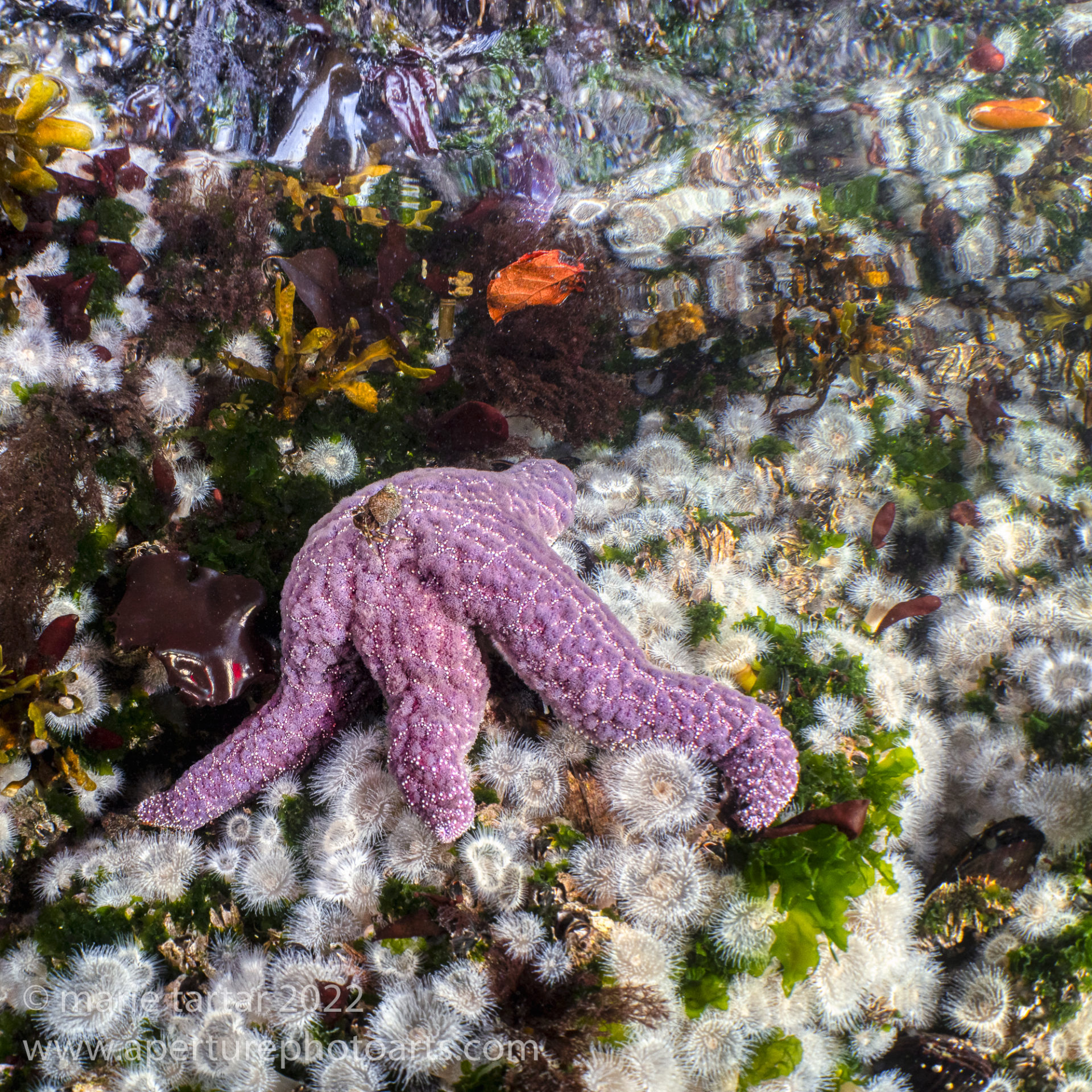
In the shallows, a plethora of invertebrate life reflects up to the surface. Every surface is covered with innumerable reasons to don thick thermal undergarments, a drysuit, lots of weight, a thick hood and gloves and venture into water temperatures of 48-50 degrees F.
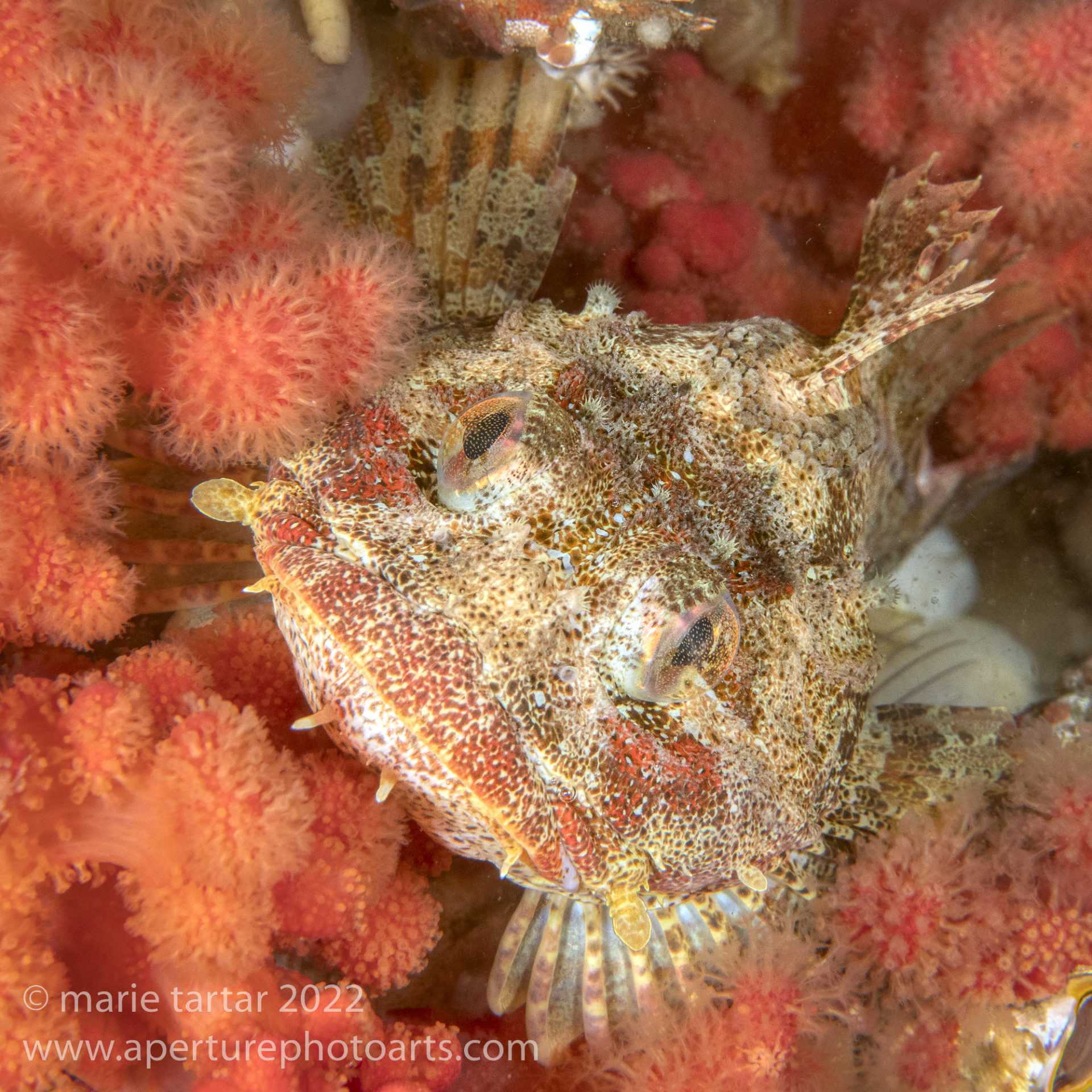
One of the marquee residents of Queen Charlotte Strait, the red Irish lord, a type of sculpin and a photographer favorite.

A pair of opalescent nudibranchs (Hermissenda crassicornis) engage on a kelp frond in Queen Charlotte Strait, British Columbia.

Our two prior trips to dive in British Columbia were in April; a pleasant surprise of going in September were large numbers of hooded nudibranchs (Melibe leonina).

Brooding anemone, near Hurst island, Queen Charlotte Strait, British Columbia, north Vancouver Island
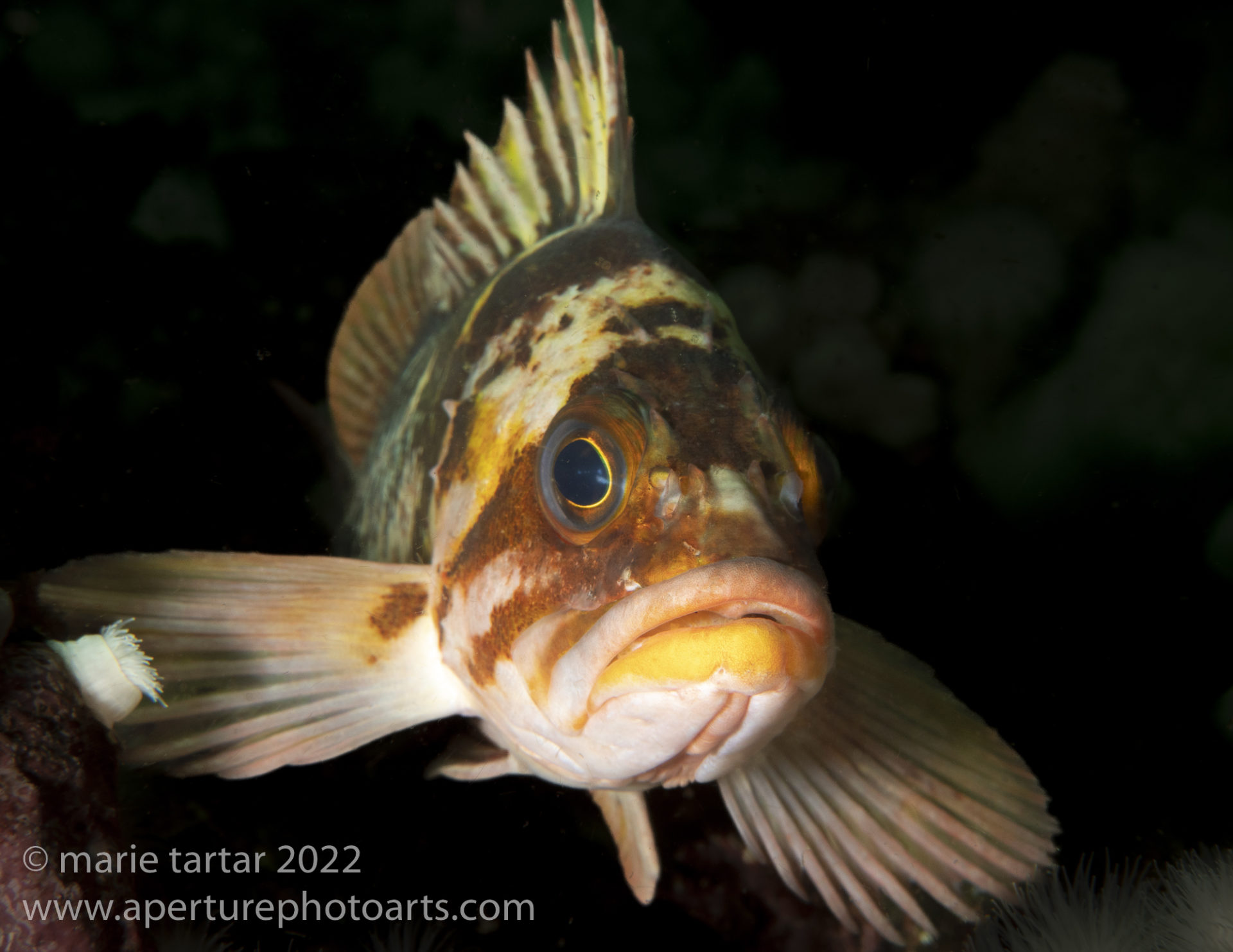
Copper rockfish (Sebastes caurinus), Queen Charlotte Strait, north Vancouver Island, British Columbia
October
This month started off with a one woman bravura show Kristina Wong, Sweatshop Overlord, which had me laughing and crying almost continually and brought back so many crazed early pandemic memories. The performance artist found herself suddenly out of work in March 2020 with the outbreak of the pandemic and enlisted social media, friends and strangers to become an army of sewing mask makers. Steve gave up his ticket to Joe, who also was totally engaged.
My reading was dominated by an 18 hour long caustically funny New York family drama which I loved, The Latecomer by Jean Hanff Korelitz. The Oppenheimer triplets, conceived through infertility interventions, can’t stand each other or their parents and are only too ready to be rid of each other when they reach college age.
I finally finished watching the 6th and last season of Better Call Saul, which was brilliant, compelling and dark. Needing an antidote to all that intrigue, I investigated Amy’s suggestion of a Korean comedy series Extraordinary Attorney Woo. I was captivated and charmed from the beginning by this beguiling autistic savant lawyer Woo Young-woo, played by Park Eun-bin.
Meanwhile, October 2 was the last performance on Broadway of the little post 9-11 show that could, Come From Away, after a 5 year run. I wish we could have been in New York to mark the close, as we had attended the opening back in March 2017. I had so believed in that show that I doubled down, investing twice as much as I ever have in a Broadway show, which was a decision which definitely paid off.
Steve and I both loved What We Talk About When We Talk About Anne Frank by Nathan Englander at the Old Globe. Crackling dialogue and sparks fly between two Jewish couples of vastly different outlooks and degrees of religiosity. They are united by the wives being childhood into high school best friends who drifted apart (or did one abandon the other?) when one becomes Hasidic, moves to Israel and has 10 children and the other moves to Florida and becomes more secular.
The big accomplishment of early October was getting Mama through cataract surgery number 1. My friend Joe was invaluable in transporting Mama to and from the surgery, as well as to the post-op check. At work, we made the transition to reading mammograms off of PACS (previously, we used vendor specific dedicated work stations).

From little to big, we saw an incredible variety of life diving the length of Baja from south to north.
In the middle of the month, we hit a milestone, taking a trip during its originally scheduled time slot! This traverse of Baja’s Sea of Cortez/Gulf of California, organized by Lynn Morton on the Rocio del Mar, from south near San Jose del Cabo to north at Bahia de Los Angeles, had been scheduled way back in the before times, the fall of 2019. Our one way itinerary was interesting and varied and since our disembarkation point was Puerto Penasco, from which we would be transported by van to Phoenix, we tacked on another week off to relax in Sedona.
On our first morning in Sedona, we suffered through workmen shouting to each other, trying to rewire the thermostat. I whiled away some time roughly calculating how many dives we have done, at least during the period since starting this blog in late 2013. I came up with about 300 documented dives from 2014-2020, or roughly 50 dives/year. We didn’t dive during the first two years of the pandemic, but since resuming diving in August, we logged another 60 dives between the Channel Islands over Labor Day, British Columbia in September and our just concluded Baja dive trip. Figuring 50 dives/year from 1992-2013, that would be about 1000 dives, plus 300, plus 60 or at least 1360 dives (probably an underestimate).
Later, we hiked from the house to Marie’s Mesa. While we were there, we used Photopills to see what would be happening with the Milky Way and the Cibola Mitten formation. As the moon wouldn’t be interfering, we decided to hike back out there after dark by headlamp to shoot.
More enjoyable days were passed hiking Wilson Canyon and catching up with Barb and Jeff over lunch, huddled in jackets on the back patio at Indian Gardens. Another day we drove to Boynton Canyon, hoping to find the “secret” Indian ruins our neighbor Tom showed us years ago. We timed our walk and after 55 minutes, started looking for the path to take us to the hidden cliff ruins. We wasted time following a rocky wash, but eventually found the right path, with a wider opening that we remembered, now marked with a large arrow formed by downed branches. A large alligator juniper after a small rise in the path, after the wash nearly touches the main trail, were additional markers for the correct path.
It turns out this is no longer a secret. We passed at least 10-12 people, mostly couples, en route to the ruins. It turns out the ruins are only part of the attraction of this alternate route. A formation known as the Subway is nearby and Instagram has made it a destination.
Another wonderful day filled with fall color was spent at a long-time favorite, West Fork of Oak Creek. Even armed only with I-phones, we still managed to spend 5 hours (the guidebooks say it takes 3 hours out and back but that’s assuming one doesn’t stop around every bend for photographs).
We also watched films, both at Harkins (Amsterdam) and at home, as we continued screening narrative features for the film festival (Sedona International or SIFF). The best of these was Farewell Mr. Haffman. It takes place in occupied Paris beginning in 1941. The Jews are being rounded up. Jewish jeweler Haffman sends his family to safety just in time, intending to follow them after making arrangements to temporarily sell his business to his employee, Mr. Mercier. This is a tense and absorbing wartime drama, starring Daniel Auteuil as M. Haffman and Gilles Lellouche as his employee Mercier. Sara Giraudeau plays Mercier’s wife. The lives of these characters become increasingly intertwined and complicated by the arrangements they make under the noses of the Nazis.
November
A week in New York and Thanksgiving were the high points of November. New York was a delightful balancing act of shows (two plays, two musicals), meals, museums and movies. On the plane, I finished reading the script of Tom Stoppard’s Leopoldstadt, which we saw a few days later. Leopoldstadt was met with a stunned silence from the audience at the final curtain. Mayde had mentioned there were many characters, making it a little hard for her to follow and that she thought reading the script in advance would help. Indeed, there were many characters, multiple generations of two intertwined Jewish families in Vienna, beginning in 1899, through the post-WW II years, whose fortunes and fates are indelibly altered by the rise of the Nazis.
Suzan-Lori Parks’ Topdog/Underdog made for an intense afternoon at the Golden Theater, with two brothers named Lincoln (Corey Hawkins) and Booth (Yahya Abdul-Mateen II). Both are struggling for survival, with Booth “boosting” whatever he wants from stores and Lincoln paid by an arcade to dress up in whiteface as Honest Abe Lincoln in order for patrons to shoot him. Booth wants Lincoln to teach him the finer points of 3-card monty, off which Lincoln has sworn.
Our film viewing included a SIFF candidate, an excellent film set in the Outer Hebrides of Scotland during WW I. Based on novel by John MacKay, it spotlights the consequences of rape and pregnancy in a small religious village, The Road Dance stars lovely Hermione Corfield as Kirsty, a young girl in love with Murdo (Will Fletcher), who is called up for military service along with other boys in the remote village. A road dance to send off the boys changes Kirsty’s life forever.
On the 5th Avenue bus south, we saw the Paris Theater was showing Alejandro González Iñárritu’s new film, Bardo (or False Chronicle of a Handful of Truths) and decided to pop over for an afternoon showing. It is a nearly hallucinogenic, wildly imaginative and visually stunning tale of an exalted journalist and documentary Mexican filmmaker (played by Daniel Giménez Cacho, who apparently strongly resembles Iñárritu himself) who is about to receive a major award in the US, where he has lived for decades and raised his family (wife Lucia (Griselda Siciliani), son Lorenzo (Iker Sánchez Solano) and daughter). Both Steve and I were struck by the surrealist parallels between this work and the artwork we had just seen of Meret Oppenheim’s at MOMA. I don’t know what the odds are of seeing two films in as many days with scenes of a dead baby in the sea, but we managed it. Another scene recalled our recent Namibia experience of houses filling with sand.
We saw the Meret Oppenheim retrospective on member Monday at MOMA. No food or drink of any kind are allowed in now, presumably due to recent protest incidents involving artworks. Sculptor Ken Capps had put this show on Steve’s radar when he was out at his foundation photographing his sculpture park on Palomar Mountain. How little we knew of her work, we didn’t even know the artist was a woman until seeing this show. This evidently would have suited her , as a central tenet of her work is that all people have male and female components. The surrealists adopted her as a young artist when she gained early fame with a fur-lined teacup. Her oeuvre reflects her life-long fixation on dreams and the subconscious.
We indulged in many good meals during the week, including Red Barn, a dumpling and Chinese food restaurant, with Sarah and Aaron. We’d been once before to their West Village location, years ago, also with Sarah and Aaron. Aaron highly endorsed the pastrami eggroll, which we had to agree was delicious. We also enjoyed shrimp and snow pea dumplings, 3-vegetable dumplings, dumplings with vegetables and peanuts, fried rice with duck and cauliflower and sauteed green beams and brussels sprouts.
The culinary extravaganza of the week was dinner at 11 Madison Park, in the bar. The vegan, 6 course meal is a pricy $195/person, but was a real experience and included many more tastes than 6 courses. We launched with a savory starter sumac “tea” with ginger and lemongrass, which seemed to us more like a very flavorful vegetable broth than a tea. The finale was a sesame and chocolate pretzel dessert finale, dangling from a silvery stand and that was after a trio of desserts featuring apples, including an apple ice cream drizzled with birch syrup, an apple wedge with a cinnamon inset (resembling a hardboiled egg) served on ice and an apple doughnut served on hot rocks. This was accompanied by an Eric Bordelet Poiré pear cider from Normandy.. The first real course was a matsutake mushroom rice porridge. The rice had been crushed to form tiny particles rather than grains. As Steve elected the wine pairing, it was served with a French champagne (Robert Moncuit Les Grands Blancs de Blancs).
The second course, Tonburi, was really 3 tastes in one, with a little mound of Japanese cedar seeds (the tonburi, also known as land or field caviar) flanked by a potato and turnip puree mound and a turnip and horseradish puree. From Steve’s wine pairing, this was the offering I liked the best, a 2018 white blend from the Western cape of South Africa (A.A. Badenhorst, Kalmoesfontein).
The third tofu dish incorporated collard greens, radish and cumin and was served with a 2021 Massican Annia white wine. This is a rare vintner in Napa that produces only white wine.
The bok choy fourth course was steamed with seaweed and topped with shavings of white truffle and was served with a 2019 Benanti Etna Rosso Sicilian red wine.
The fifth course was my favorite, a skewer of maitake mushroom (hen of the woods), grilled with maple and juniper. This was served with a 2011 Bordeaux from Cháteau Gloria in Saint-Julien.
It was meal (and a bill) to remember!
Mid-week saw us munching on tacos from Los Tacos No. 1 in Times Square before a matinee of Funny Girl. I had seen the Barbra Streisand film for the first time on a plane a few months before and Mayde and Phoebe had endorsed the production with Lea Michele. Man, can she can belt! Even Steve, who doesn’t like musicals, seemed enthralled.
Afterwards, we walked to Vatan (3rd Avenue and 29th Street) for a fixed price Indian vegetarian meal and catch-up with Lenny and Arleene.
Our final show of the week was Phantom of the Opera, spurred by the announced closure of the show after 35 years! That closure was pushed back some months after others like us, who assumed the show would run forever, scrambled for tickets. We had a chance to check out the Drama Bookstore before meeting up with Mel and Gail at a new addition to the Midtown dining scene, Urban Hawker, where we sampled llasa soup, rambutan salad, and pancit from different vendors.
Reading Thrust by Lidia Yuknavitch for my bookclub a few months before made me want finally to see the Statue of Liberty in person. A fictionalized version of sculptor Auguste Bartholdi appears as a character in this wildly imaginative book, as well as a group of four friends who live together and work on assembling the behemoth colossus.
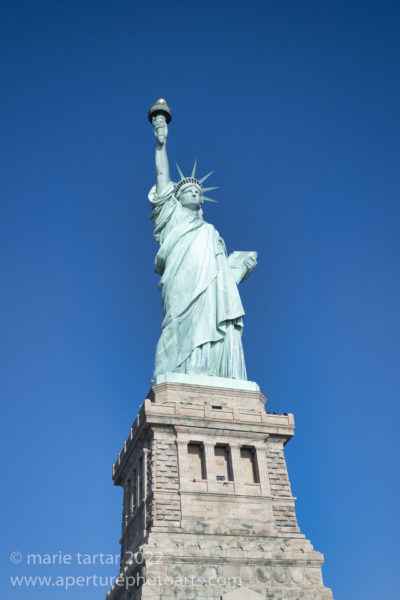
The most iconic and reproduced sculpture in the world: Liberty. What an amazing story of how she came to be.
This made us get up early for us on a crisp sunny cold Friday, leaving apartment just after 8 am, to ride the express 4 train to the southern tip of Manhattan, disembarking at Bowling Green for a short walk to Castle Clinton, the immigration station for the state of New York before immigration became federalized in 1890. There we had an unpleasant surprise-somehow, I had booked our tickets for Crown access for Wednesday and there was no recourse but to buy a new set of tickets. Crown access was sold out but we could climb the pedestal, designed by architect Richard Morris Hunt. We did the 215 step climb instead of taking the elevator and found ourselves alone in the staircase.
Our entry also included Ellis Island, where we looked for Eilenbergs, but did not find them. The first Ellis Island station , which opened in 1892, was only open 5 years before burning down in 1897, taking immigration records with it, a possible explanation. The fireproof French Renaissance structure we visited opened in 1890, was abandoned in 1954 and was restored as a museum in 1990.
Laura and Gary came over for an a quick apero before we walked to Drunken Monkey for dinner outside. We usually see them at the Sedona International Film Festival every February, but they have been spending extended periods of time in NY, helping out their daughter, whose husband has advanced colon cancer.
On a cold but sunny, pleasant Saturday, we walked briskly across Central Park to Lincoln Center to see the film Decision to Leave, a detective and psychological thriller pitting a Korean detective against an attractive Chinese woman, suspected of killing her abusive husband, to whom he is attracted.
We ran into Cal and Stella on Park Avenue on our way there. On the way back, we ducked into the American Folk Art Museum and were pleasantly delighted by the Morris Hirshfield Rediscovered show. He was a tailor and women’s slippers manufacturer who became a painter after retiring. His naive, so called “primitive” renditions of animals and female nudes were embraced by the Surrealists in the 1940s. A chance encounter with a pair of his early paintings by the gallerist Sidney Janis and Janis’ promotion of his work led to a remarkable degree of art world recognition during his short career as a painter, including a solo show at MOMA.
On our departure Sunday, we slipped over to the Jewish Museum to see their show New York: 1962-64, which proved to be quite captivating. During those years, the Jewish Museum’s then curator Alan Solomon was quite prescient in presenting a trio of shows of “New Art” that captured the zeitgeist of that time, which was marked by the civil rights movement and the assassination of JFK. Solomon organized Robert Rauschenberg’s first solo show in 1963 and Jasper John’s the next year.
Our experiment in using mass transit to teleport ourselves to JFK for our flight home was less successful. Two hours, door to door, thanks to having to regroup after embarking to avoid a closed section. My flight home was enriched by Mrs. Harris Goes to Paris, an adorable film set in England in the 1950s. A WW II widow played by Leslie Manville is a housekeeper who finds herself enamored of a Dior frock she sees in one of her employer’s wardrobes. She determines to procure herself one, despite its 500 quid price.
Later in the month, we had to up our Thanksgiving game and cook, which we accomplished with Blue Apron’s help. We hosted my first cousin once removed, Nina (daughter of my cousin Toshiko) and Nina’s Japanese roommate, Saki, for Thanksgiving weekend. They were nearing the end of a semester abroad at Cal State Northridge. Joe brought Mama over and we enjoyed a Blue Apron version of a traditional Thanksgiving, including turkey, cheesy potatoes, and homemade cranberry sauce.
December
In late October, we received an irresistible invitation from our Bay area diving buddy, Skip. We were debating whether to block off the time we had off in December to prevent the house in Sedona from being rented, but had made no firm plans. Skip said he and Phil, a San Diego dive buddy, were meeting up in New Mexico for a long weekend of bird photography at Bosque del Apache. Skip would be spending a few days in advance at his house in Santa Fe-did we want to join them? The timing was perfect, so we decided to fly into Albuquerque on a Tuesday (Dec 6), met up with Skip at his house to enjoy re-acquainting ourselves with Santa Fe for a couple of days before heading south to Bosque on Friday with our camera bags and tripods and meeting up with Phil, Walt and Barb, also veterans of many “Skip trips” over the years. By my count, we did at least 6 dive trips with Phil and Skip over the years (Baja 2017, Cocos 2007, Galapagos 2006, Thailand 2005, Socorro 2004, Guadalupe 2003, Channel Islands, somewhere in there). Skip had not travelled at all during the pandemic, so this was his inaugural trip. We’d only been to Bosque once, with Nancy and Gerry, in December 2020, the first year of the pandemic.
Bosque del Apache is a well recognized birding destination, especially notable for huge numbers of birds and the sunrise “blast-off” of a mass of birds each morning, prompting photographers to bundle up against near-freezing temperatures in the pre-dawn darkness. Coincidentally, Nancy and Gerry preceded us to Bosque a few days ahead of us. We were surprised to learn from them that they didn’t really experience the blast-offs we had experienced on our prior trip. That was also our experience the first two mornings. On our final morning, we were rewarded with two: one north of the Flight Deck and the other at the crane pond north of Bosque. That Monday morning (Dec 12) was notable for being windier than the preceding mornings, which perhaps was the difference.
Driving back and forth from Bosque to Fite Ranch, where we stayed, and between Albuquerque, Santa Fe and Bosque, gave us time to finish a Greg book recommendation, a very funny, well read, comedic goth riff on a vampire tale, You Suck by Christopher Moore.
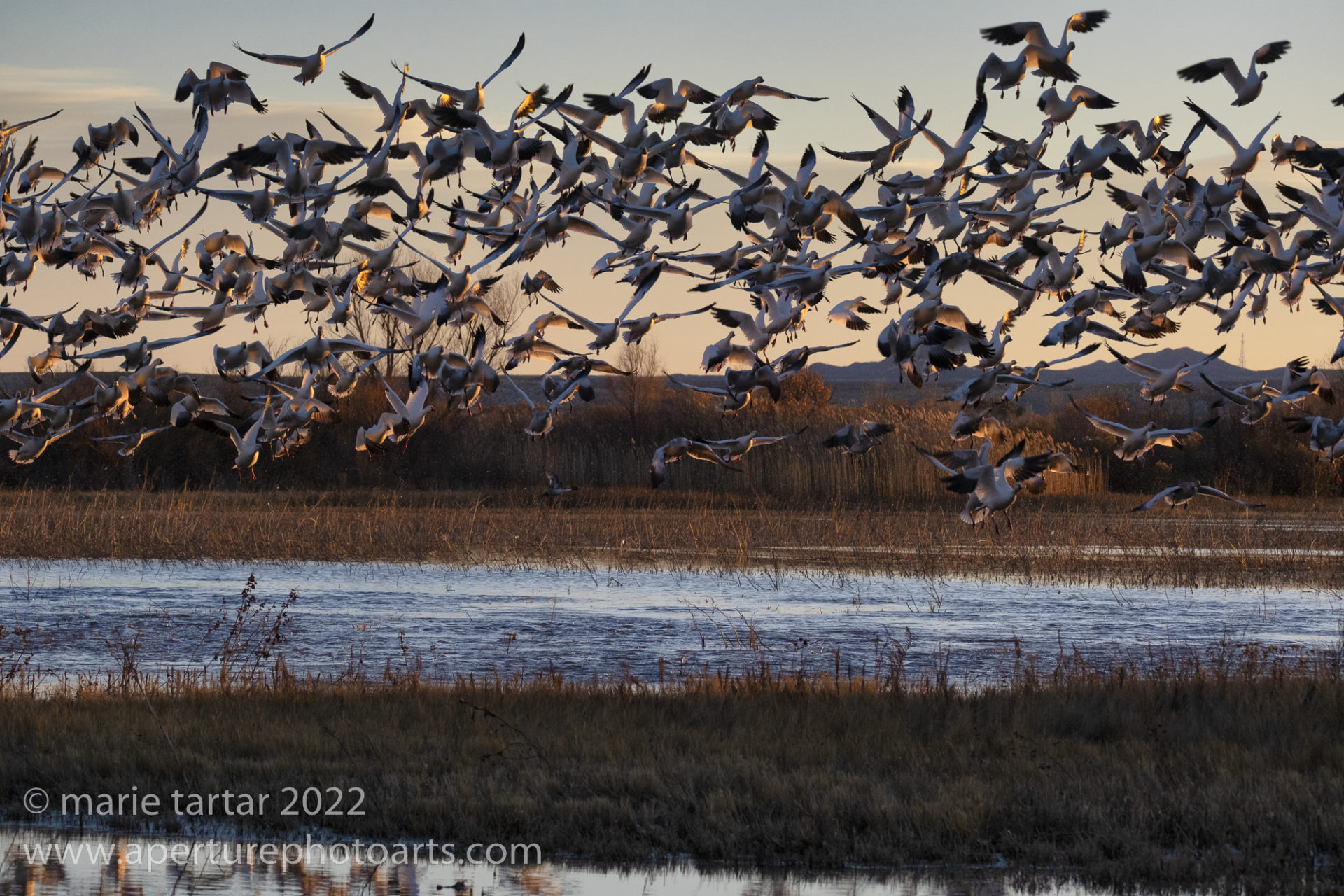
Bosque del Apache, New Mexico: Finally, a real blast-off, a veritable wall of geese (snow and Ross’), ascending in unison in an explosive cacophony of wings.

A surprise second blast-off, at the crane pond north of Bosque del Apache. First a few, then groups, then many geese took off.
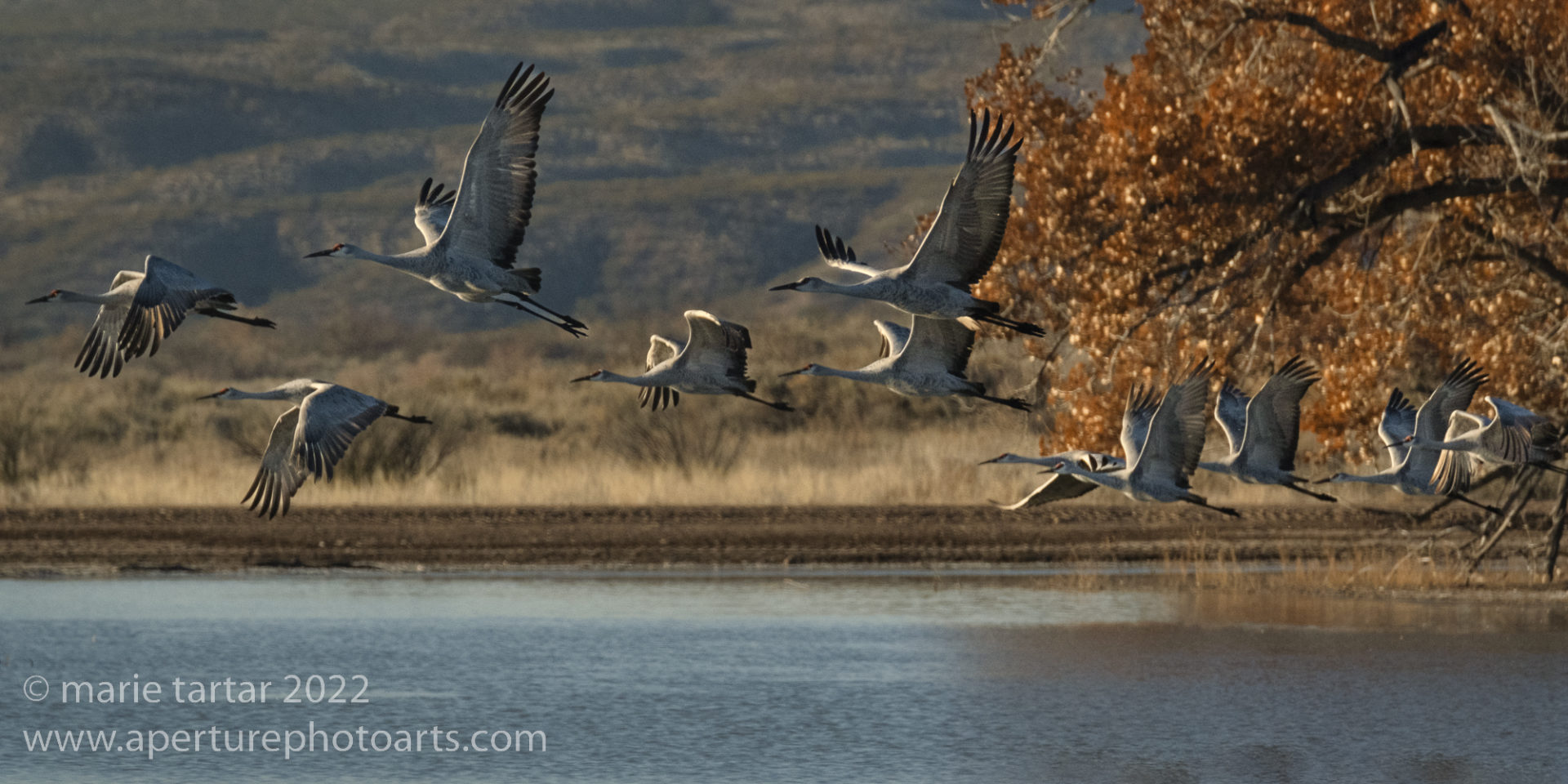
Sandhill cranes aggregate in the crane ponds outside Bosque del Apache. The ponds’ size and number vary by year depending on the the rain.
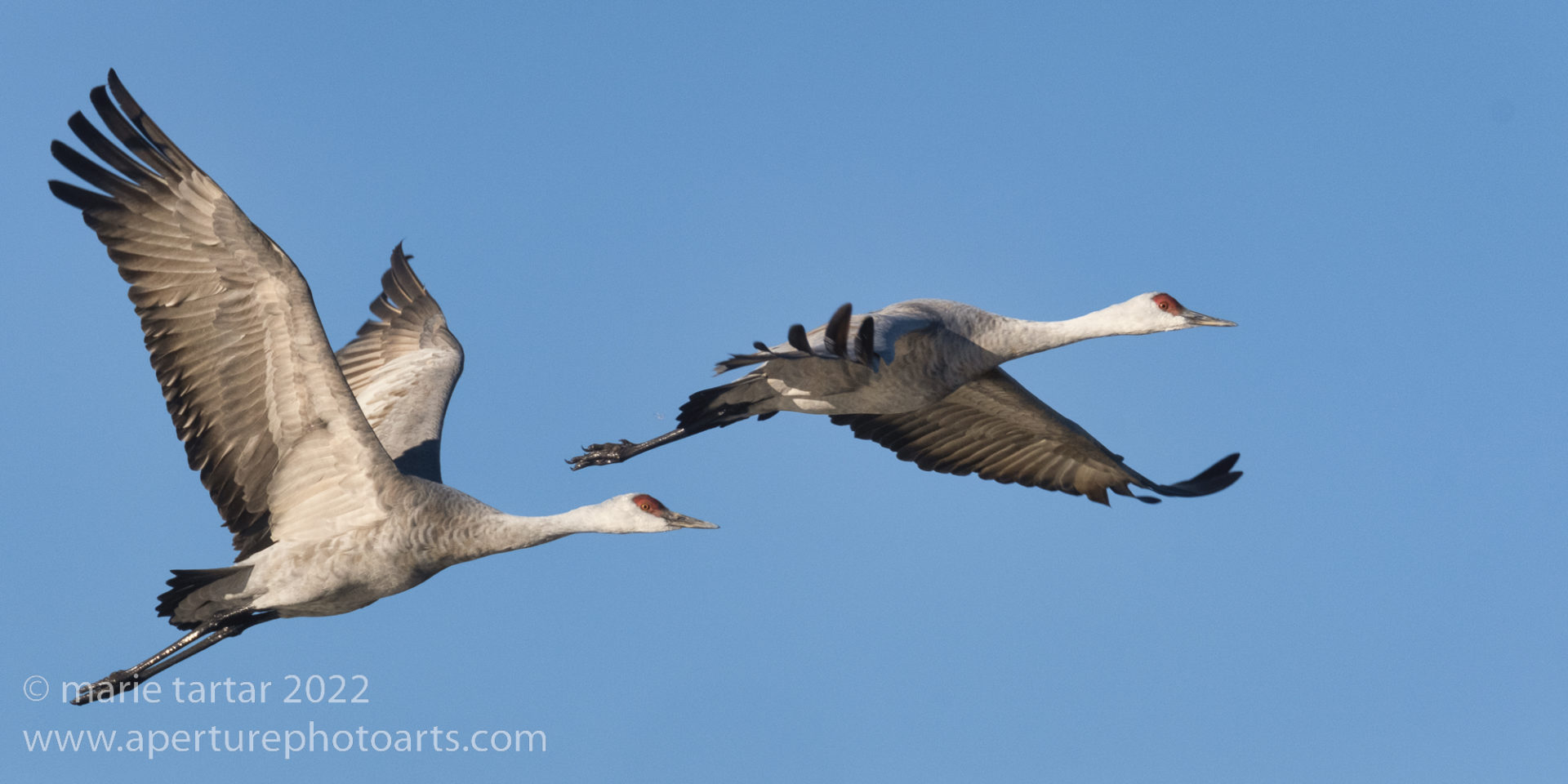
Sunny with blue skies, a typical cold Bosque del Apache morning in December, backdrop for a pair of sandhill cranes taking to the sky.

Sandhill cranes aloft, with residual fall color at the crane pond north of Bosque del Apache, New Mexico.
We started, and I later finished, listening to another of Greg’s recommendations, an enjoyable crime caper, A Man Called Doll by Jonathan Ames. Listening time was rounded out by contemporary works by Hernan Diaz (Trust) and Checkout 19 by Claire-Louise Bennett. I followed up my astonishment and enjoyment of Percival Everett’s The Trees by listening to a 2017 novel of his, So Much Blue.
Crabby Christmas at Gail and Ralph’s, this year with Janet and Scott, Ellen and David, Miles and Tatiana, and Stew and Robin in from New York, is always a highlight of our holiday season. The afterglow of the rich king crab and fingerling potato meal, followed by home-made Christmas cookies and ice cream, coupled with the buzz of the excellent wines, always means the after dinner White Elephant gift exchange is highly entertaining (and competitive). My cousin Nina was there for the fun too, having finished her semester abroad at Cal State Northridge a few days before. She scored a pepperoni pizza printed blanket as her souvenir of a wonderful evening.
New Year’s Eve was an Italian feast at Miles’ and Tatiana’s, with Ellen and David and Victor and Julie there to enjoy the meal of caponata, giant meatballs and tiramisu, followed by a screening of a 1996 film which also centers a special Italian meal: Big Night, starring Stanley Tucci (who co-directed with Campbell Scott, also in the film) and Tony Shalhoub as Italian immigrant brothers whose New Jersey restaurant isn’t thriving. They bet everything on a “big night” showcase dinner intended to revive their fortunes. It was a great note on which to end an eventful year, with delicious food and wine, in the comfortable home of dear friends. At year’s end, we were still Covid testing before special events like these but most of the fear of serious repercussions of infection of earlier pandemic years had significantly abated. As this post attests, we still managed to have a good time, at home and afield and were looking forward to 2023 as an even better, more carefree year.
-Marie




